Paul van Yperen's Blog, page 41
August 18, 2024
Alain Delon (1935-2024)
Yesterday, 18 August 2024, French film star Alain Delon (1935) died at the age of 88. He was the breathtakingly good-looking James Dean of European cinema in the late 1950s and early 1960s. He proved in such films as Plein soleil/Purple Noon (René Clément, 1960) Rocco e i suoi fratelli/Rocco and his brothers (Luchino Visconti, 1960) and L'eclisse/The Eclipse (Michelangelo Antonioni, 1962) that he was also a magnificent actor. Delon later starred in a series of popular gangster films by directors like Henri Verneuil, Jacques Deray and Jean-Pierre Melville.
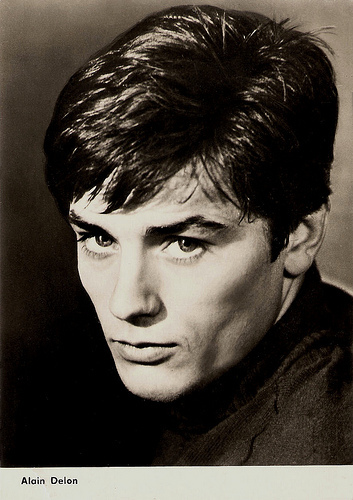
East-German postcard by VEB Progress Film-Vertrieb, Berlin, 1967. retail price: 0,20 MDN.Photo: publicity still for Rocco e i suoi fratelli/Rocco and his brothers (Luchino Visconti, 1960).

French postcard by E.D.U.G., no. 22. Photo: Sam Lévin.

German postcard by Krüger. Photo: Ufa.
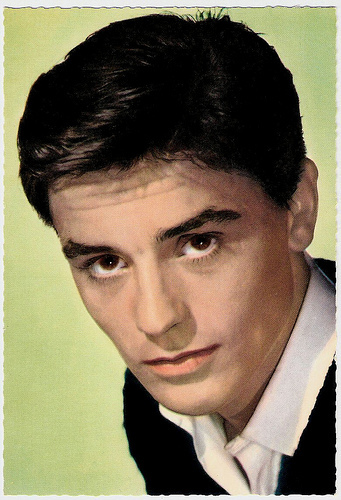
German postcard by ISV, no. H 25.
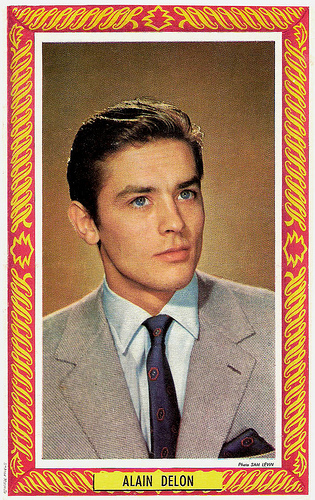
French postcard by St. Anne, Marseille. Photo: Sam Lévin.
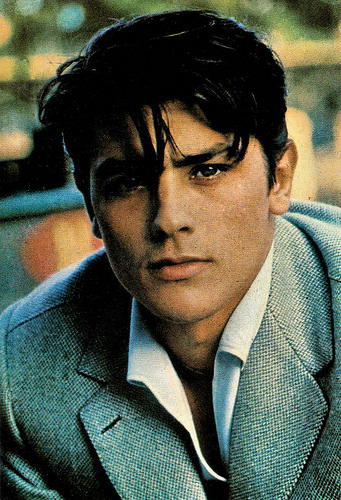
Spanish postcard, no. 161. Photo: Philippe R. Doumic.
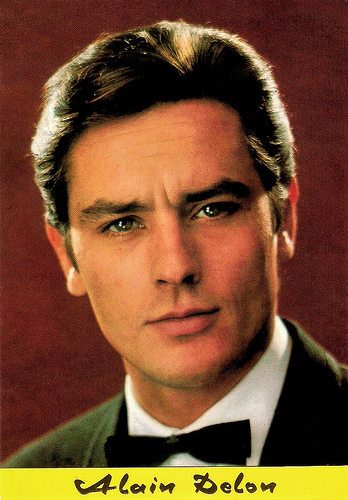
Spanish postcard by Bergas Ind. Graf., Barcelona, no. 463, 1967.
Stormy childhood
Alain Fabien Maurice Marcel Delon was born in Sceaux, a suburb of Paris in 1935. His parents, Édith Arnold and Fabien Delon, divorced when Delon was four. He had a stormy childhood and was six times expelled from different schools.
At 14, Delon left school and worked for a brief time at his stepfather Paul Boulogne's butcher shop. Three years later, the 17-year-old enlisted in the French Marines, serving in 1953-1954 in Indochina as a parachutist. In 1956, after being dishonourably discharged from the military, he returned to France. He had little money and worked at various odd jobs, including as a waiter, salesman, and porter in the Les Halles market.
During this time he became friends with the actress Brigitte Auber and joined her on a trip to the Cannes Film Festival, where his film career would begin with a screentest for David O’Selznick. He didn't go to Hollywood but decided to stay in France. He made his film debut in Quand la femmes s'en mele/Send a Woman When the Devil Fails (Yves Allégret, 1957).
In 1958, during the making of the love story Christine (Pierre Gaspard-Huit, 1959), Delon met Romy Schneider . They would be engaged till 1964.
Delon’s first outstanding success came with the role of the parasite Tom Ripley in the sundrenched thriller Plein soleil/Purple Noon (René Clément, 1960), based on the crime novel The Talented Mr. Ripley by Patricia Highsmith. Delon presented a psychological portrait of a murderous young cynic who attempts to take on the identity of his victim. The critics liked his performance. According to Wikipedia , Highsmith herself was also a fan of his portrayal.
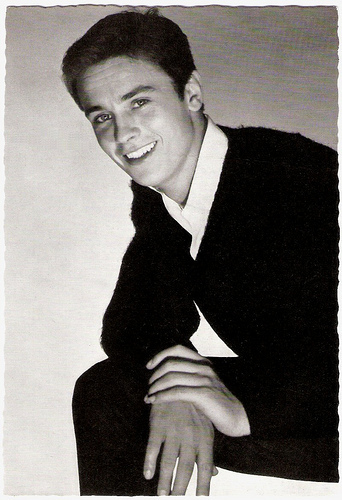
German postcard by WS-Druck, Wanne Eickel, no. 419. Photo: Sam Lévin, 1957.
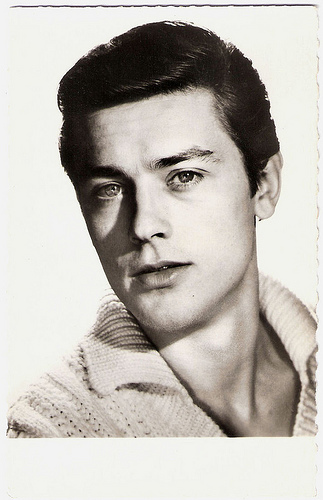
French postcard by Editions P.I., no. 1004. Offered by Les Carbones Korès 'Carboplane'. Photo: Sam Lévin.
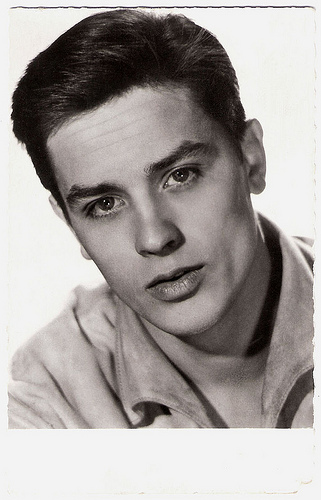
French postcard by Editions P.I., no. 1026. Photo: Sam Lévin.
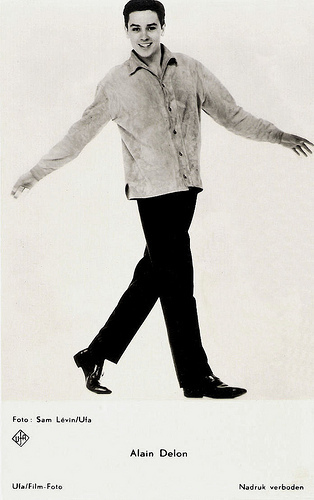
Belgian postcard by D.R.C, licence holder for Belgium and Belgian Congo of Universum Film Aktiengesellschaft, Berlin-Tempelhof, no. 4615. Photo: Sam Lévin / Ufa.
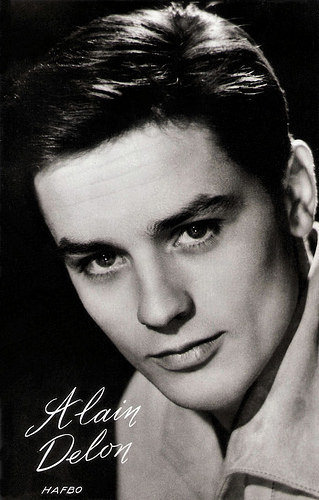
Dutch postcard by Muziekparade, Hilversum, no. AX 4701. Photo: Hafbo / Sam Lévin.
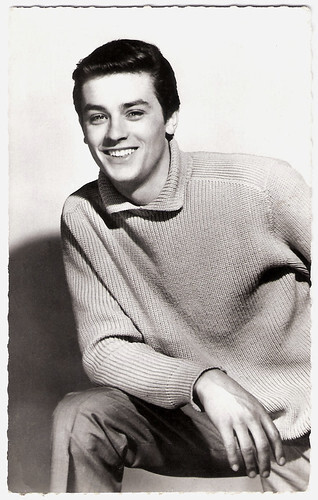
French postcard by Editions du Globe (EDUG), Paris, no. 838. Photo: Sam Lévin.
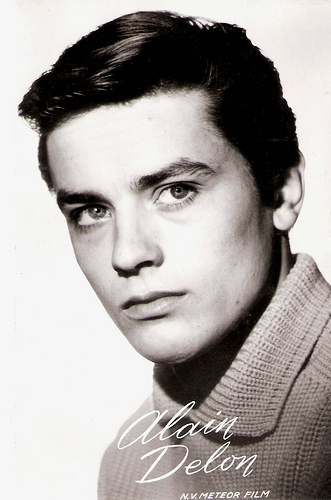
Dutch postcard by Uitg. Takken, Utrecht, no. 3980. Photo: N.V. Meteor Film / Speva / Play Art Prod. Publicity still for Christine/Liebelei (Pierre Gaspard-Huit, 1958).
The Eclipse
Luchino Visconti offered Alain Delon a totally different role in Rocco e i suoi fratelli/Rocco and His Brothers (Luchino Visconti, 1960). In this film, he plays the devoted Sicilian immigrant Rocco, who accepts the greatest sacrifices to save his characterless brother Simone, played by Renato Salvatori. Delon received international recognition for this role.
The following year Alain Delon made his stage debut in Paris in 'Dommage qu'elle soit une putain' ('Tis Pity She’s a Whore), alongside Romy Schneider . The play, written by John Ford, was directed by Luchino Visconti . The production cost a reported 60 million francs and broke box office records. It ran for more than 8 months.
Delon also gave tremendous performances in L'eclisse/The Eclipse (Michelangelo Antonioni, 1962) opposite Monica Vitti , and the epic Il Gattopardo/The Leopard (Luchino Visconti, 1963) starring opposite Burt Lancaster and Claudia Cardinale . L’eclisse won the Special Prize of the jury at the Cannes Film Festival, and the following year Il Gattopardo won the Golden Palm in Cannes.
After these acclaimed Italian films, Alain Delon returned to France and to the crime film in Mélodie en sous-sol/The Big Snatch (Henri Verneuil, 1963), with Jean Gabin . This classic genre film was distinguished by a soundly worked-out screenplay, by careful production and by excellent performances of both Gabin and Delon.
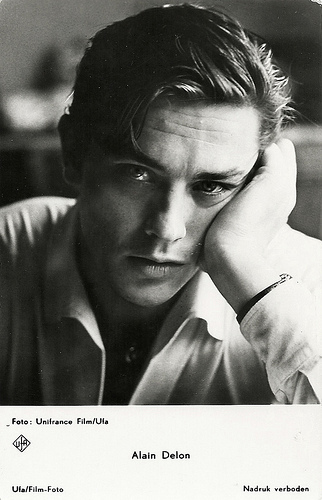
Dutch postcard by Gebr. Spanjersberg, Rotterdam, no. 1383. Photo: Unifrance Film / Ufa.
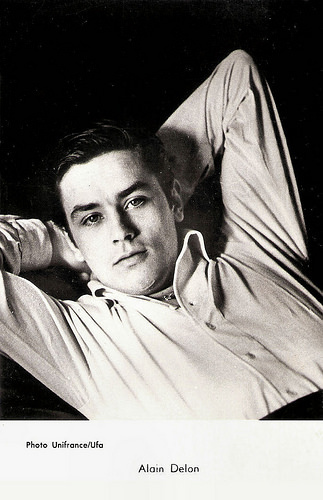
French postcard by Editions P.I., Paris, no. FK 44. Photo: Unifrance / Ufa.
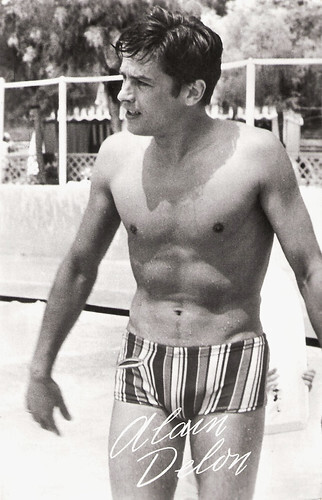
Dutch postcard by 't Sticht, Utrecht, no. 6176.
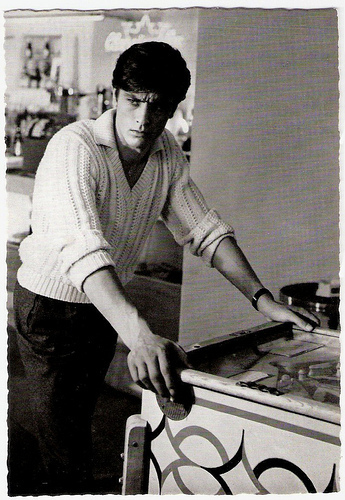
German postcard by WS-Druck, Wanne-Eickel, no. 444. Photo: Privat.
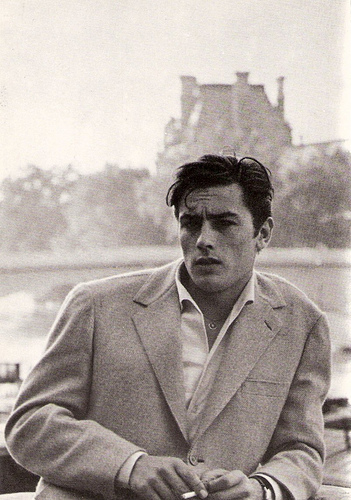
French postcard by Editions P.I., Paris, no. FK 42. Photo: Unifrance Film / Philippe R. Doumic.
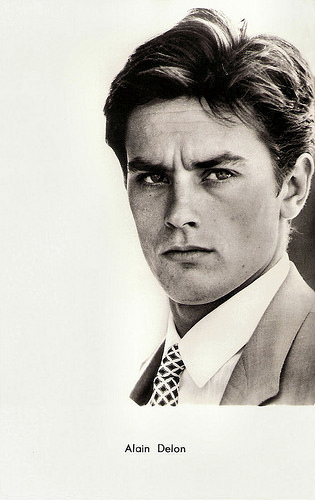
French postcard by Editions P.I., no. 1151A, offered by Les Carbones Korès 'Carboplane.
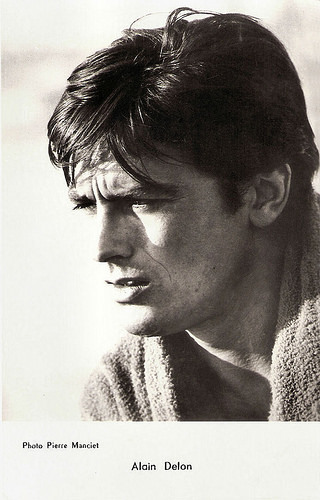
French postcard by Editions P.I., no. 1161, offered by Les Carbones Korès 'Carboplane. Photo: Pierre Manciet.
A bid for American stardom
By now Hollywood studios were very interested in Alain Delon and he decided to make a bid for American stardom. In 1965, MGM signed him to a five-picture contract. The first movie of this deal was Les Félins/Joy House (René Clément, 1964), shot in France with Jane Fonda . He followed it up with two more films for the studio: the all-star The Yellow Rolls Royce (Anthony Asquith, 1965), in which Delon had a relatively small role, and Once a Thief (Ralph Nelson, 1965), where he co-starred with Ann-Margret .
Delon then signed a three-picture deal with Columbia. He appeared for this studio in the big-budget action film Lost Command (Mark Robson, 1966) with Anthony Quinn . Universal Studios used Delon in the Western Texas Across the River (Michael Gordon, 1966), opposite Dean Martin .
For Seven Arts, Delon starred in Paris brûle-t-il?/Is Paris Burning? (René Clément, 1966) about the liberation of Paris in August 1944 by the French Resistance and the Free French Forces. This was a massive hit in France but it performed disappointingly at the US box office - as did all of Delon's Hollywood-financed films. So after six Hollywood movies, Delon returned to France.
In the late sixties, Delon came to epitomise the calm, psychopathic hoodlum, staring into the camera like a cat assessing a mouse. His tough, ruthless side was used to grand effect in Le Samouraï/The Godson (Jean-Pierre Melville, 1967), maybe Delon’s finest moment. Later Melville directed him again in the crime films Le cercle rouge/The Red Circle (1970) with Bourvil and Yves Montand , and Un Flic/A Cop (1972) with Catherine Deneuve .
In 1968 Delon also in real life got involved in a murder scandal when one of his bodyguards was found shot dead on a garbage dump near Delon's house. Eventually, Delon was cleared of all charges. In the cinema, Alain Delon had a huge success in the bloodstained Borsalino (Jacques Deray, 1970). He and Jean-Paul Belmondo played small-time gangsters who become kings of the Marseille underworld of the 1930s. He also produced Borsalino, and the film became one of France’s highest-grossing films of the time. Between 1968 and 1990 he went on to produce 26 films.
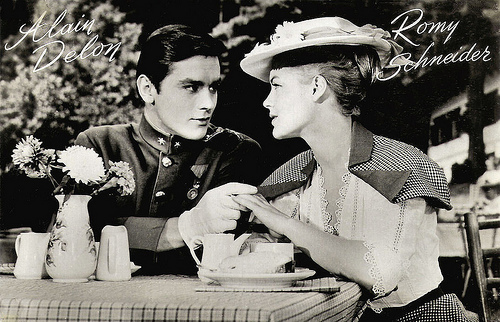
Dutch postcard by Takken, Utrecht. Photo: NV Meteor Film. Publicity still for Christine/Liebelei (Pierre Gaspard-Huit, 1958) with Romy Schneider .
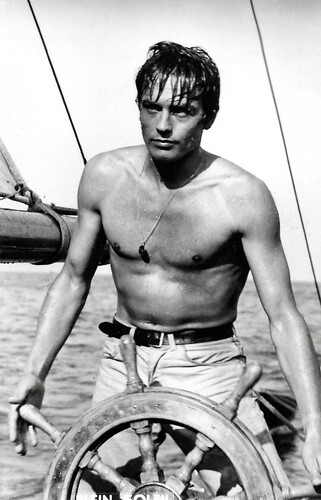
Spanish postcard by Archivo Bermejo, no. 7247. Photo: Filmax. Alain Delon in Plein Soleil/Purple Noon (René Clément, 1960).
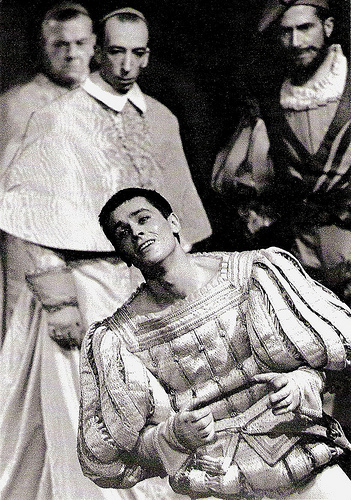
French postcard by the Bibliothèque Nationale Paris / Imp. Bussière A.G., Paris, 1990. Photo: Roger Pic. Alain Delon in the play 'Dommage qu'elle soit une p...' ('Tis Pity She’s a Whore) directed by Luchino Visconti (1961).
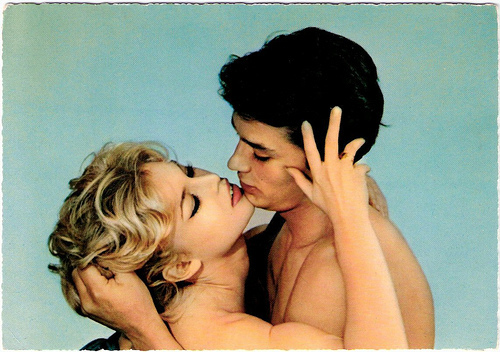
German postcard by Krüger, no. 902/95. Photo Sam Lévin. Another sexy publicity photo for Amours célèbres (Michel Boisrond, 1961) with Brigitte Bardot .

Small Romanian collectors card by Casa Filmului Acin. Photo: publicity still for L'eclisse/The Eclipse (Michelangelo Antonioni, 1962) with Monica Vitti.
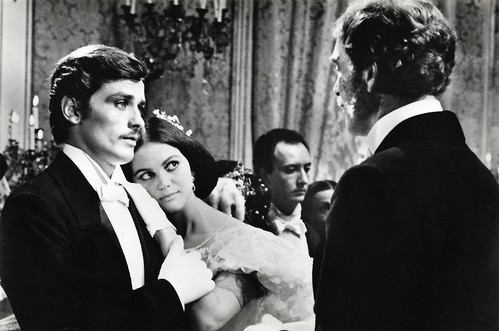
Czech postcard by UPTF / Pressfoto, Praha (Prague), no. C 198, 1965. Photo: G.B. Poletto. Alain Delon, Claudia Cardinale and Burt Lancaster in Il Gattopardo/The Leopard (Luchino Visconti, 1963).
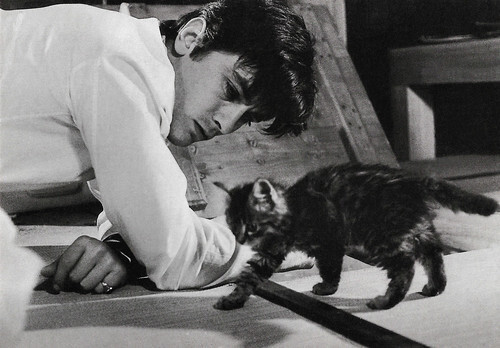
French postcard. by Editions La Malibran, Paris / Nancy, no. CF 60 Alain Delon in Les Felins/The Love Cage (René Clément, 1964).
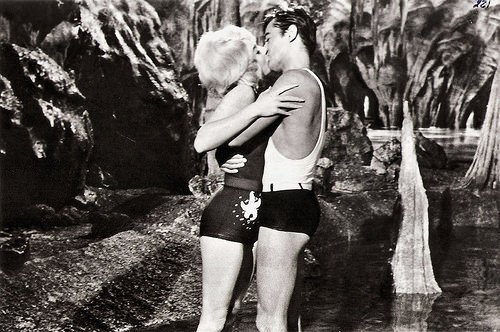
Romanian postcard by Casa Filmului Acin, no. 313. Photo: publicity still for The Yellow Rolls-Royce (Anthony Asquith, 1964) with Shirley MacLaine.
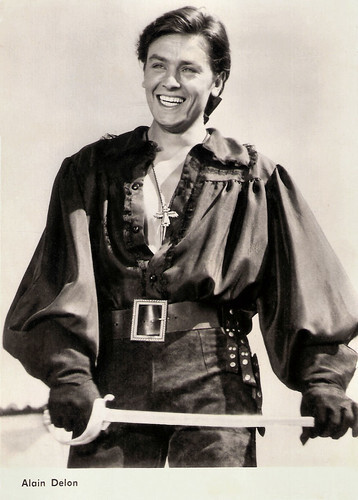
East-German postcard by VEB Progress Film-Vertrieb, Berlin, no. 2480, 1965. Photo: Alain Delon in La tulipe noire/The Black Tulip (Christian-Jaque, 1964).
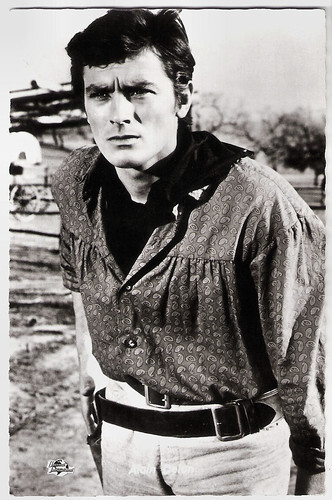
West German Kolibri postcard by Friedrich W. Sander Verlag, Minden/Westf., no. 2818. Photo: Universal. Alain Delon in Texas Across the River (Michael Gordon, 1966).
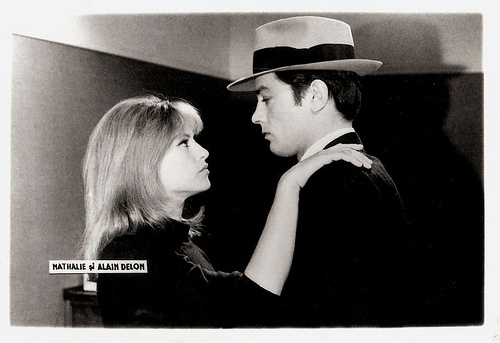
Small Romanian collectors card. Photo: publicity still for Le Samouraï (Jean-Pierre Melville, 1967) with Nathalie Delon .
Roles against type
In later years Alain Delon won critical acclaim for roles against type. In the Kafkaesque thriller Mr Klein (Joseph Losey, 1976) he was brilliant as the icily sinister art trader in German-occupied France.
In 1985 he was awarded the César Award as Best Actor for his role as an alcoholic in Notre histoire/Our Story (Bertrand Blier, 1984). Another acclaimed role was the homosexual Baron de Charlus in the fine Marcel Proust adaptation Un amour de Swann/Swann in Love (Volker Schlöndorf, 1984).
In 1990, Delon worked with New Wave auteur Jean-Luc Godard on Nouvelle Vague/New Wave (1990), in which he played twins. He also directed two films himself, Pour la peau d'un flic/For a Cop's Hide (1981) and Le Battant/The Fighter (1983).
A string of box office disasters in the next years culminated in 1998 in the unexpected failure of Une chance sur deux/Half a Chance (Patrice Leconte, 1998) in which Alain Delon was reunited with Jean-Paul Belmondo .
Alain Delon announced that he would give up acting. For his impressive film career, he received the Legion d'Honneur, the highest French decoration.
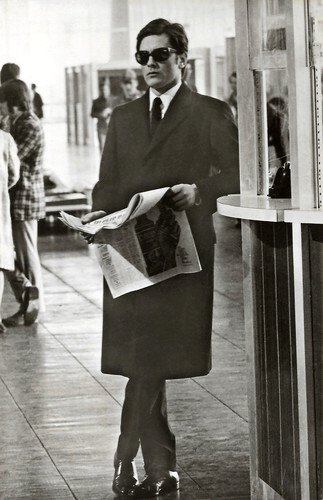
Romanian postcard by Casa Filmului Acin, no. 428. Alain Delon in Le clan des Siciliens/The Sicilian Clan (Henri Verneuil, 1969).
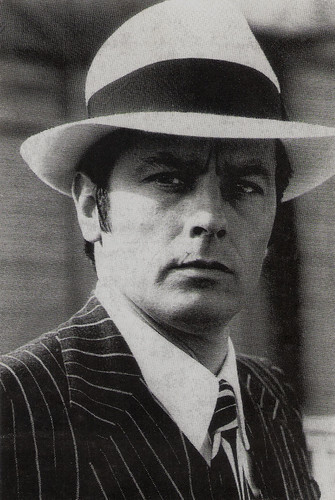
French postcard by Les Editions Gil in the Acteurs Français series, no. 4. Alain Delon in Borsalino (Jacques Deray, 1970).
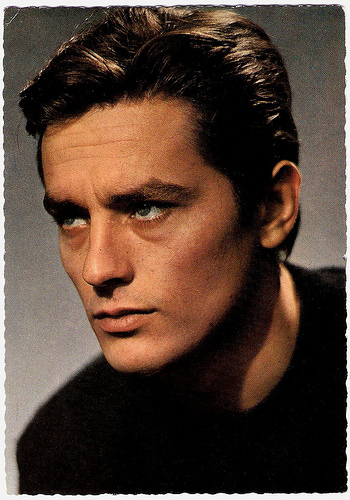
French postcard by E.D.U.G., no. 469. Photo: Sam Lévin.
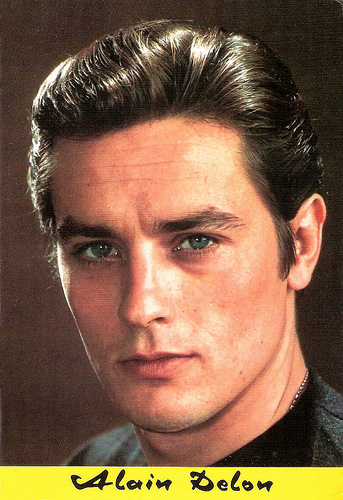
Spanish postcard by Bergas Ind. Graf., no. 572.
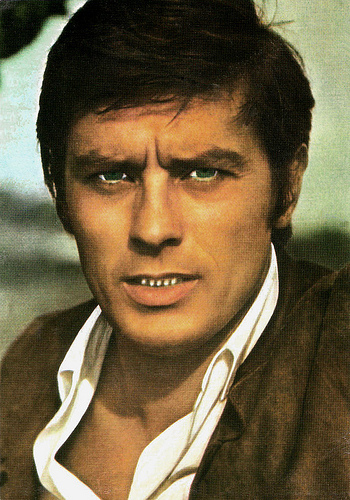
Romanian postcard by Casa Filmului Acin.
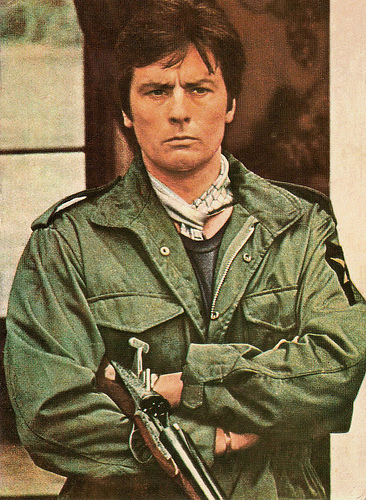
Romanian postcard by Casa Filmului Acin.
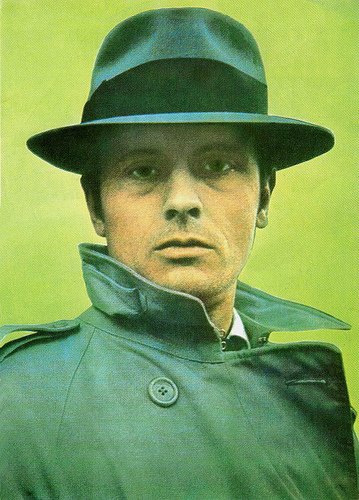
Romanian postcard by Casa Filmului Acin.
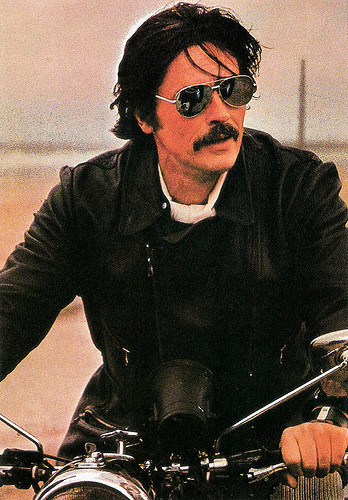
French postcard by Editions F. Nugeron, no. Star 28.
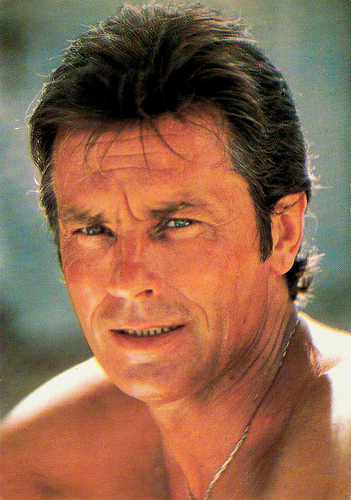
French postcard by Editions P.I., Paris, no. 3453. Photo: Michel Ginfray.
Astérix
Alain Delon returned to the cinema as Julius Cesar in Astérix aux Jeux Olympiques/Asterix at the Olympic Games (Frederic Forestier, Thomas Langmann, 2008), and he reunited with former girlfriend Mireille Darc in a stage adaptation of 'The Bridges of Madison County' by Robert James Waller at the Marigny Theatre in Paris.
Alain Delon has a son, Christian Aaron Boulogne 'Ari' Päffgen (1962), from a relationship with German singer/supermodel Nico. The child was raised mostly by Delon's mother and stepfather. He broke the relationship with his mother after she insisted on taking care of Ari. They spoke again when his step-father died in 1988, the same year Nico died.
From his first marriage to Nathalie Delon (Nathalie Barthélemy) he has another son, Anthony Delon (1964), who also acted in several films. Then he was a longtime companion of actress Mireille Darc from 1968 to 1982. He also had a relationship with Anne Parillaud. From his second marriage with former Dutch model Rosalie van Breemen, he has a son Alain-Fabien (1990) and a daughter Anouchka (1994). Rosalie was 21 when she met Alain who was 52. They lived together from 1987 till 2001.
Afterwards, Alain Delon lived in Geneva, Switzerland. He acquired Swiss citizenship in 1999, and the company managing products sold under his name is based in Geneva. Since the formation of a perfume label in his name, Delon had a variety of products sold under his name including wristwatches, clothing, eyewear, stationery and cigarettes.
After he appeared in the Russian comedy S Novym godom, mamy!/Happy New Year, Mommies! (Artyom Aksyonenko, Sarik Andreasyan, Anton Bormatov, Dmitriy Grachev, Klim Poplavskiy, 2012), his final film appearance was in Toute ressemblance (Michel Denisot, 2019) starring Frank Dubosc. In this film about a TV talking head, director Denisot put together multiple real facts and more than 50 French TV celebrities were credited including Delon. At the 2019 Cannes Film Festival, Alain Delon was the recipient of an honorary Palme d'Or for his long-standing career in the cinema.
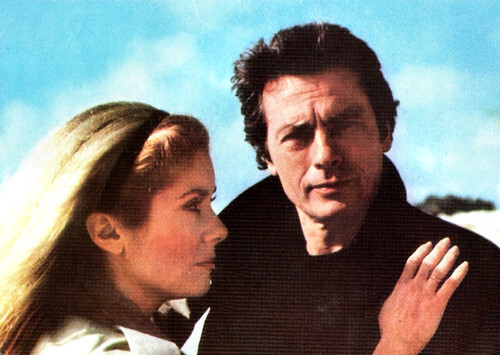
Romanian postcard by Casa Filmului Acin. Photo: publicity still for Le choc/Shock (Robin Davis, 1982) with Catherine Deneuve.
Trailer Rocco e i suoi fratelli/Rocco and his Brothers (1960). Source: Filmmuseum Amsterdam (YouTube).
Trailer for Mélodie en sous-sol/The Big Snatch (1963). Source: Curtis Hayden (YouTube).
Trailer La Piscine/The Pool (1968). Source: Filmmuseum Amsterdam (YouTube).
Sources: Alain Delon.ch (now defunct), Wikipedia, (IMDb), Il Cinema Ritrovato (page is now defunct) and .

East-German postcard by VEB Progress Film-Vertrieb, Berlin, 1967. retail price: 0,20 MDN.Photo: publicity still for Rocco e i suoi fratelli/Rocco and his brothers (Luchino Visconti, 1960).

French postcard by E.D.U.G., no. 22. Photo: Sam Lévin.

German postcard by Krüger. Photo: Ufa.

German postcard by ISV, no. H 25.

French postcard by St. Anne, Marseille. Photo: Sam Lévin.

Spanish postcard, no. 161. Photo: Philippe R. Doumic.

Spanish postcard by Bergas Ind. Graf., Barcelona, no. 463, 1967.
Stormy childhood
Alain Fabien Maurice Marcel Delon was born in Sceaux, a suburb of Paris in 1935. His parents, Édith Arnold and Fabien Delon, divorced when Delon was four. He had a stormy childhood and was six times expelled from different schools.
At 14, Delon left school and worked for a brief time at his stepfather Paul Boulogne's butcher shop. Three years later, the 17-year-old enlisted in the French Marines, serving in 1953-1954 in Indochina as a parachutist. In 1956, after being dishonourably discharged from the military, he returned to France. He had little money and worked at various odd jobs, including as a waiter, salesman, and porter in the Les Halles market.
During this time he became friends with the actress Brigitte Auber and joined her on a trip to the Cannes Film Festival, where his film career would begin with a screentest for David O’Selznick. He didn't go to Hollywood but decided to stay in France. He made his film debut in Quand la femmes s'en mele/Send a Woman When the Devil Fails (Yves Allégret, 1957).
In 1958, during the making of the love story Christine (Pierre Gaspard-Huit, 1959), Delon met Romy Schneider . They would be engaged till 1964.
Delon’s first outstanding success came with the role of the parasite Tom Ripley in the sundrenched thriller Plein soleil/Purple Noon (René Clément, 1960), based on the crime novel The Talented Mr. Ripley by Patricia Highsmith. Delon presented a psychological portrait of a murderous young cynic who attempts to take on the identity of his victim. The critics liked his performance. According to Wikipedia , Highsmith herself was also a fan of his portrayal.

German postcard by WS-Druck, Wanne Eickel, no. 419. Photo: Sam Lévin, 1957.

French postcard by Editions P.I., no. 1004. Offered by Les Carbones Korès 'Carboplane'. Photo: Sam Lévin.

French postcard by Editions P.I., no. 1026. Photo: Sam Lévin.

Belgian postcard by D.R.C, licence holder for Belgium and Belgian Congo of Universum Film Aktiengesellschaft, Berlin-Tempelhof, no. 4615. Photo: Sam Lévin / Ufa.

Dutch postcard by Muziekparade, Hilversum, no. AX 4701. Photo: Hafbo / Sam Lévin.

French postcard by Editions du Globe (EDUG), Paris, no. 838. Photo: Sam Lévin.

Dutch postcard by Uitg. Takken, Utrecht, no. 3980. Photo: N.V. Meteor Film / Speva / Play Art Prod. Publicity still for Christine/Liebelei (Pierre Gaspard-Huit, 1958).
The Eclipse
Luchino Visconti offered Alain Delon a totally different role in Rocco e i suoi fratelli/Rocco and His Brothers (Luchino Visconti, 1960). In this film, he plays the devoted Sicilian immigrant Rocco, who accepts the greatest sacrifices to save his characterless brother Simone, played by Renato Salvatori. Delon received international recognition for this role.
The following year Alain Delon made his stage debut in Paris in 'Dommage qu'elle soit une putain' ('Tis Pity She’s a Whore), alongside Romy Schneider . The play, written by John Ford, was directed by Luchino Visconti . The production cost a reported 60 million francs and broke box office records. It ran for more than 8 months.
Delon also gave tremendous performances in L'eclisse/The Eclipse (Michelangelo Antonioni, 1962) opposite Monica Vitti , and the epic Il Gattopardo/The Leopard (Luchino Visconti, 1963) starring opposite Burt Lancaster and Claudia Cardinale . L’eclisse won the Special Prize of the jury at the Cannes Film Festival, and the following year Il Gattopardo won the Golden Palm in Cannes.
After these acclaimed Italian films, Alain Delon returned to France and to the crime film in Mélodie en sous-sol/The Big Snatch (Henri Verneuil, 1963), with Jean Gabin . This classic genre film was distinguished by a soundly worked-out screenplay, by careful production and by excellent performances of both Gabin and Delon.

Dutch postcard by Gebr. Spanjersberg, Rotterdam, no. 1383. Photo: Unifrance Film / Ufa.

French postcard by Editions P.I., Paris, no. FK 44. Photo: Unifrance / Ufa.

Dutch postcard by 't Sticht, Utrecht, no. 6176.

German postcard by WS-Druck, Wanne-Eickel, no. 444. Photo: Privat.

French postcard by Editions P.I., Paris, no. FK 42. Photo: Unifrance Film / Philippe R. Doumic.

French postcard by Editions P.I., no. 1151A, offered by Les Carbones Korès 'Carboplane.

French postcard by Editions P.I., no. 1161, offered by Les Carbones Korès 'Carboplane. Photo: Pierre Manciet.
A bid for American stardom
By now Hollywood studios were very interested in Alain Delon and he decided to make a bid for American stardom. In 1965, MGM signed him to a five-picture contract. The first movie of this deal was Les Félins/Joy House (René Clément, 1964), shot in France with Jane Fonda . He followed it up with two more films for the studio: the all-star The Yellow Rolls Royce (Anthony Asquith, 1965), in which Delon had a relatively small role, and Once a Thief (Ralph Nelson, 1965), where he co-starred with Ann-Margret .
Delon then signed a three-picture deal with Columbia. He appeared for this studio in the big-budget action film Lost Command (Mark Robson, 1966) with Anthony Quinn . Universal Studios used Delon in the Western Texas Across the River (Michael Gordon, 1966), opposite Dean Martin .
For Seven Arts, Delon starred in Paris brûle-t-il?/Is Paris Burning? (René Clément, 1966) about the liberation of Paris in August 1944 by the French Resistance and the Free French Forces. This was a massive hit in France but it performed disappointingly at the US box office - as did all of Delon's Hollywood-financed films. So after six Hollywood movies, Delon returned to France.
In the late sixties, Delon came to epitomise the calm, psychopathic hoodlum, staring into the camera like a cat assessing a mouse. His tough, ruthless side was used to grand effect in Le Samouraï/The Godson (Jean-Pierre Melville, 1967), maybe Delon’s finest moment. Later Melville directed him again in the crime films Le cercle rouge/The Red Circle (1970) with Bourvil and Yves Montand , and Un Flic/A Cop (1972) with Catherine Deneuve .
In 1968 Delon also in real life got involved in a murder scandal when one of his bodyguards was found shot dead on a garbage dump near Delon's house. Eventually, Delon was cleared of all charges. In the cinema, Alain Delon had a huge success in the bloodstained Borsalino (Jacques Deray, 1970). He and Jean-Paul Belmondo played small-time gangsters who become kings of the Marseille underworld of the 1930s. He also produced Borsalino, and the film became one of France’s highest-grossing films of the time. Between 1968 and 1990 he went on to produce 26 films.

Dutch postcard by Takken, Utrecht. Photo: NV Meteor Film. Publicity still for Christine/Liebelei (Pierre Gaspard-Huit, 1958) with Romy Schneider .

Spanish postcard by Archivo Bermejo, no. 7247. Photo: Filmax. Alain Delon in Plein Soleil/Purple Noon (René Clément, 1960).

French postcard by the Bibliothèque Nationale Paris / Imp. Bussière A.G., Paris, 1990. Photo: Roger Pic. Alain Delon in the play 'Dommage qu'elle soit une p...' ('Tis Pity She’s a Whore) directed by Luchino Visconti (1961).

German postcard by Krüger, no. 902/95. Photo Sam Lévin. Another sexy publicity photo for Amours célèbres (Michel Boisrond, 1961) with Brigitte Bardot .

Small Romanian collectors card by Casa Filmului Acin. Photo: publicity still for L'eclisse/The Eclipse (Michelangelo Antonioni, 1962) with Monica Vitti.

Czech postcard by UPTF / Pressfoto, Praha (Prague), no. C 198, 1965. Photo: G.B. Poletto. Alain Delon, Claudia Cardinale and Burt Lancaster in Il Gattopardo/The Leopard (Luchino Visconti, 1963).

French postcard. by Editions La Malibran, Paris / Nancy, no. CF 60 Alain Delon in Les Felins/The Love Cage (René Clément, 1964).

Romanian postcard by Casa Filmului Acin, no. 313. Photo: publicity still for The Yellow Rolls-Royce (Anthony Asquith, 1964) with Shirley MacLaine.

East-German postcard by VEB Progress Film-Vertrieb, Berlin, no. 2480, 1965. Photo: Alain Delon in La tulipe noire/The Black Tulip (Christian-Jaque, 1964).

West German Kolibri postcard by Friedrich W. Sander Verlag, Minden/Westf., no. 2818. Photo: Universal. Alain Delon in Texas Across the River (Michael Gordon, 1966).

Small Romanian collectors card. Photo: publicity still for Le Samouraï (Jean-Pierre Melville, 1967) with Nathalie Delon .
Roles against type
In later years Alain Delon won critical acclaim for roles against type. In the Kafkaesque thriller Mr Klein (Joseph Losey, 1976) he was brilliant as the icily sinister art trader in German-occupied France.
In 1985 he was awarded the César Award as Best Actor for his role as an alcoholic in Notre histoire/Our Story (Bertrand Blier, 1984). Another acclaimed role was the homosexual Baron de Charlus in the fine Marcel Proust adaptation Un amour de Swann/Swann in Love (Volker Schlöndorf, 1984).
In 1990, Delon worked with New Wave auteur Jean-Luc Godard on Nouvelle Vague/New Wave (1990), in which he played twins. He also directed two films himself, Pour la peau d'un flic/For a Cop's Hide (1981) and Le Battant/The Fighter (1983).
A string of box office disasters in the next years culminated in 1998 in the unexpected failure of Une chance sur deux/Half a Chance (Patrice Leconte, 1998) in which Alain Delon was reunited with Jean-Paul Belmondo .
Alain Delon announced that he would give up acting. For his impressive film career, he received the Legion d'Honneur, the highest French decoration.

Romanian postcard by Casa Filmului Acin, no. 428. Alain Delon in Le clan des Siciliens/The Sicilian Clan (Henri Verneuil, 1969).

French postcard by Les Editions Gil in the Acteurs Français series, no. 4. Alain Delon in Borsalino (Jacques Deray, 1970).

French postcard by E.D.U.G., no. 469. Photo: Sam Lévin.

Spanish postcard by Bergas Ind. Graf., no. 572.

Romanian postcard by Casa Filmului Acin.

Romanian postcard by Casa Filmului Acin.

Romanian postcard by Casa Filmului Acin.

French postcard by Editions F. Nugeron, no. Star 28.

French postcard by Editions P.I., Paris, no. 3453. Photo: Michel Ginfray.
Astérix
Alain Delon returned to the cinema as Julius Cesar in Astérix aux Jeux Olympiques/Asterix at the Olympic Games (Frederic Forestier, Thomas Langmann, 2008), and he reunited with former girlfriend Mireille Darc in a stage adaptation of 'The Bridges of Madison County' by Robert James Waller at the Marigny Theatre in Paris.
Alain Delon has a son, Christian Aaron Boulogne 'Ari' Päffgen (1962), from a relationship with German singer/supermodel Nico. The child was raised mostly by Delon's mother and stepfather. He broke the relationship with his mother after she insisted on taking care of Ari. They spoke again when his step-father died in 1988, the same year Nico died.
From his first marriage to Nathalie Delon (Nathalie Barthélemy) he has another son, Anthony Delon (1964), who also acted in several films. Then he was a longtime companion of actress Mireille Darc from 1968 to 1982. He also had a relationship with Anne Parillaud. From his second marriage with former Dutch model Rosalie van Breemen, he has a son Alain-Fabien (1990) and a daughter Anouchka (1994). Rosalie was 21 when she met Alain who was 52. They lived together from 1987 till 2001.
Afterwards, Alain Delon lived in Geneva, Switzerland. He acquired Swiss citizenship in 1999, and the company managing products sold under his name is based in Geneva. Since the formation of a perfume label in his name, Delon had a variety of products sold under his name including wristwatches, clothing, eyewear, stationery and cigarettes.
After he appeared in the Russian comedy S Novym godom, mamy!/Happy New Year, Mommies! (Artyom Aksyonenko, Sarik Andreasyan, Anton Bormatov, Dmitriy Grachev, Klim Poplavskiy, 2012), his final film appearance was in Toute ressemblance (Michel Denisot, 2019) starring Frank Dubosc. In this film about a TV talking head, director Denisot put together multiple real facts and more than 50 French TV celebrities were credited including Delon. At the 2019 Cannes Film Festival, Alain Delon was the recipient of an honorary Palme d'Or for his long-standing career in the cinema.

Romanian postcard by Casa Filmului Acin. Photo: publicity still for Le choc/Shock (Robin Davis, 1982) with Catherine Deneuve.
Trailer Rocco e i suoi fratelli/Rocco and his Brothers (1960). Source: Filmmuseum Amsterdam (YouTube).
Trailer for Mélodie en sous-sol/The Big Snatch (1963). Source: Curtis Hayden (YouTube).
Trailer La Piscine/The Pool (1968). Source: Filmmuseum Amsterdam (YouTube).
Sources: Alain Delon.ch (now defunct), Wikipedia, (IMDb), Il Cinema Ritrovato (page is now defunct) and .
Published on August 18, 2024 22:00
Alain Delon
Yesterday, 18 August 2024, French film star Alain Delon (1935) died at the age of 88. He was the breathtakingly good-looking James Dean of European cinema in the late 1950s and early 1960s. He proved in such films as Plein soleil/Purple Noon (René Clément, 1960) Rocco e i suoi fratelli/Rocco and his brothers (Luchino Visconti, 1960) and L'eclisse/The Eclipse (Michelangelo Antonioni, 1962) that he was also a magnificent actor. Delon later starred in a series of popular gangster films by directors like Henri Verneuil, Jacques Deray and Jean-Pierre Melville.

East-German postcard by VEB Progress Film-Vertrieb, Berlin, 1967. retail price: 0,20 MDN.Photo: publicity still for Rocco e i suoi fratelli/Rocco and his brothers (Luchino Visconti, 1960).

French postcard by E.D.U.G., no. 22. Photo: Sam Lévin.

German postcard by Krüger. Photo: Ufa.

German postcard by ISV, no. H 25.

French postcard by St. Anne, Marseille. Photo: Sam Lévin.

Spanish postcard, no. 161. Photo: Philippe R. Doumic.

Spanish postcard by Bergas Ind. Graf., Barcelona, no. 463, 1967.
Stormy childhood
Alain Fabien Maurice Marcel Delon was born in Sceaux, a suburb of Paris in 1935. His parents, Édith Arnold and Fabien Delon, divorced when Delon was four. He had a stormy childhood and was six times expelled from different schools.
At 14, Delon left school and worked for a brief time at his stepfather Paul Boulogne's butcher shop. Three years later, the 17-year-old enlisted in the French Marines, serving in 1953-1954 in Indochina as a parachutist. In 1956, after being dishonourably discharged from the military, he returned to France. He had little money and worked at various odd jobs, including as a waiter, salesman, and porter in the Les Halles market.
During this time he became friends with the actress Brigitte Auber and joined her on a trip to the Cannes Film Festival, where his film career would begin with a screentest for David O’Selznick. He didn't go to Hollywood but decided to stay in France. He made his film debut in Quand la femmes s'en mele/Send a Woman When the Devil Fails (Yves Allégret, 1957).
In 1958, during the making of the love story Christine (Pierre Gaspard-Huit, 1959), Delon met Romy Schneider . They would be engaged till 1964.
Delon’s first outstanding success came with the role of the parasite Tom Ripley in the sundrenched thriller Plein soleil/Purple Noon (René Clément, 1960), based on the crime novel The Talented Mr. Ripley by Patricia Highsmith. Delon presented a psychological portrait of a murderous young cynic who attempts to take on the identity of his victim. The critics liked his performance. According to Wikipedia , Highsmith herself was also a fan of his portrayal.

German postcard by WS-Druck, Wanne Eickel, no. 419. Photo: Sam Lévin, 1957.

French postcard by Editions P.I., no. 1004. Offered by Les Carbones Korès 'Carboplane'. Photo: Sam Lévin.

French postcard by Editions P.I., no. 1026. Photo: Sam Lévin.

Belgian postcard by D.R.C, licence holder for Belgium and Belgian Congo of Universum Film Aktiengesellschaft, Berlin-Tempelhof, no. 4615. Photo: Sam Lévin / Ufa.

Dutch postcard by Muziekparade, Hilversum, no. AX 4701. Photo: Hafbo / Sam Lévin.

French postcard by Editions du Globe (EDUG), Paris, no. 838. Photo: Sam Lévin.

Dutch postcard by Uitg. Takken, Utrecht, no. 3980. Photo: N.V. Meteor Film / Speva / Play Art Prod. Publicity still for Christine/Liebelei (Pierre Gaspard-Huit, 1958).
The Eclipse
Luchino Visconti offered Alain Delon a totally different role in Rocco e i suoi fratelli/Rocco and His Brothers (Luchino Visconti, 1960). In this film, he plays the devoted Sicilian immigrant Rocco, who accepts the greatest sacrifices to save his characterless brother Simone, played by Renato Salvatori. Delon received international recognition for this role.
The following year Alain Delon made his stage debut in Paris in 'Dommage qu'elle soit une putain' ('Tis Pity She’s a Whore), alongside Romy Schneider . The play, written by John Ford, was directed by Luchino Visconti . The production cost a reported 60 million francs and broke box office records. It ran for more than 8 months.
Delon also gave tremendous performances in L'eclisse/The Eclipse (Michelangelo Antonioni, 1962) opposite Monica Vitti , and the epic Il Gattopardo/The Leopard (Luchino Visconti, 1963) starring opposite Burt Lancaster and Claudia Cardinale . L’eclisse won the Special Prize of the jury at the Cannes Film Festival, and the following year Il Gattopardo won the Golden Palm in Cannes.
After these acclaimed Italian films, Alain Delon returned to France and to the crime film in Mélodie en sous-sol/The Big Snatch (Henri Verneuil, 1963), with Jean Gabin . This classic genre film was distinguished by a soundly worked-out screenplay, by careful production and by excellent performances of both Gabin and Delon.

Dutch postcard by Gebr. Spanjersberg, Rotterdam, no. 1383. Photo: Unifrance Film / Ufa.

French postcard by Editions P.I., Paris, no. FK 44. Photo: Unifrance / Ufa.

Dutch postcard by 't Sticht, Utrecht, no. 6176.

German postcard by WS-Druck, Wanne-Eickel, no. 444. Photo: Privat.

French postcard by Editions P.I., Paris, no. FK 42. Photo: Unifrance Film / Philippe R. Doumic.

French postcard by Editions P.I., no. 1151A, offered by Les Carbones Korès 'Carboplane.

French postcard by Editions P.I., no. 1161, offered by Les Carbones Korès 'Carboplane. Photo: Pierre Manciet.
A bid for American stardom
By now Hollywood studios were very interested in Alain Delon and he decided to make a bid for American stardom. In 1965, MGM signed him to a five-picture contract. The first movie of this deal was Les Félins/Joy House (René Clément, 1964), shot in France with Jane Fonda . He followed it up with two more films for the studio: the all-star The Yellow Rolls Royce (Anthony Asquith, 1965), in which Delon had a relatively small role, and Once a Thief (Ralph Nelson, 1965), where he co-starred with Ann-Margret .
Delon then signed a three-picture deal with Columbia. He appeared for this studio in the big-budget action film Lost Command (Mark Robson, 1966) with Anthony Quinn . Universal Studios used Delon in the Western Texas Across the River (Michael Gordon, 1966), opposite Dean Martin .
For Seven Arts, Delon starred in Paris brûle-t-il?/Is Paris Burning? (René Clément, 1966) about the liberation of Paris in August 1944 by the French Resistance and the Free French Forces. This was a massive hit in France but it performed disappointingly at the US box office - as did all of Delon's Hollywood-financed films. So after six Hollywood movies, Delon returned to France.
In the late sixties, Delon came to epitomise the calm, psychopathic hoodlum, staring into the camera like a cat assessing a mouse. His tough, ruthless side was used to grand effect in Le Samouraï/The Godson (Jean-Pierre Melville, 1967), maybe Delon’s finest moment. Later Melville directed him again in the crime films Le cercle rouge/The Red Circle (1970) with Bourvil and Yves Montand , and Un Flic/A Cop (1972) with Catherine Deneuve .
In 1968 Delon also in real life got involved in a murder scandal when one of his bodyguards was found shot dead on a garbage dump near Delon's house. Eventually, Delon was cleared of all charges. In the cinema, Alain Delon had a huge success in the bloodstained Borsalino (Jacques Deray, 1970). He and Jean-Paul Belmondo played small-time gangsters who become kings of the Marseille underworld of the 1930s. He also produced Borsalino, and the film became one of France’s highest-grossing films of the time. Between 1968 and 1990 he went on to produce 26 films.

Dutch postcard by Takken, Utrecht. Photo: NV Meteor Film. Publicity still for Christine/Liebelei (Pierre Gaspard-Huit, 1958) with Romy Schneider .

Spanish postcard by Archivo Bermejo, no. 7247. Photo: Filmax. Alain Delon in Plein Soleil/Purple Noon (René Clément, 1960).

French postcard by the Bibliothèque Nationale Paris / Imp. Bussière A.G., Paris, 1990. Photo: Roger Pic. Alain Delon in the play 'Dommage qu'elle soit une p...' ('Tis Pity She’s a Whore) directed by Luchino Visconti (1961).

German postcard by Krüger, no. 902/95. Photo Sam Lévin. Another sexy publicity photo for Amours célèbres (Michel Boisrond, 1961) with Brigitte Bardot .

Small Romanian collectors card by Casa Filmului Acin. Photo: publicity still for L'eclisse/The Eclipse (Michelangelo Antonioni, 1962) with Monica Vitti.

Czech postcard by UPTF / Pressfoto, Praha (Prague), no. C 198, 1965. Photo: G.B. Poletto. Alain Delon, Claudia Cardinale and Burt Lancaster in Il Gattopardo/The Leopard (Luchino Visconti, 1963).

French postcard. by Editions La Malibran, Paris / Nancy, no. CF 60 Alain Delon in Les Felins/The Love Cage (René Clément, 1964).

Romanian postcard by Casa Filmului Acin, no. 313. Photo: publicity still for The Yellow Rolls-Royce (Anthony Asquith, 1964) with Shirley MacLaine.

East-German postcard by VEB Progress Film-Vertrieb, Berlin, no. 2480, 1965. Photo: Alain Delon in La tulipe noire/The Black Tulip (Christian-Jaque, 1964).

West German Kolibri postcard by Friedrich W. Sander Verlag, Minden/Westf., no. 2818. Photo: Universal. Alain Delon in Texas Across the River (Michael Gordon, 1966).

Small Romanian collectors card. Photo: publicity still for Le Samouraï (Jean-Pierre Melville, 1967) with Nathalie Delon .
Roles against type
In later years Alain Delon won critical acclaim for roles against type. In the Kafkaesque thriller Mr Klein (Joseph Losey, 1976) he was brilliant as the icily sinister art trader in German-occupied France.
In 1985 he was awarded the César Award as Best Actor for his role as an alcoholic in Notre histoire/Our Story (Bertrand Blier, 1984). Another acclaimed role was the homosexual Baron de Charlus in the fine Marcel Proust adaptation Un amour de Swann/Swann in Love (Volker Schlöndorf, 1984).
In 1990, Delon worked with New Wave auteur Jean-Luc Godard on Nouvelle Vague/New Wave (1990), in which he played twins. He also directed two films himself, Pour la peau d'un flic/For a Cop's Hide (1981) and Le Battant/The Fighter (1983).
A string of box office disasters in the next years culminated in 1998 in the unexpected failure of Une chance sur deux/Half a Chance (Patrice Leconte, 1998) in which Alain Delon was reunited with Jean-Paul Belmondo .
Alain Delon announced that he would give up acting. For his impressive film career, he received the Legion d'Honneur, the highest French decoration.

Romanian postcard by Casa Filmului Acin, no. 428. Alain Delon in Le clan des Siciliens/The Sicilian Clan (Henri Verneuil, 1969).

French postcard by Les Editions Gil in the Acteurs Français series, no. 4. Alain Delon in Borsalino (Jacques Deray, 1970).

French postcard by E.D.U.G., no. 469. Photo: Sam Lévin.

Spanish postcard by Bergas Ind. Graf., no. 572.

Romanian postcard by Casa Filmului Acin.

Romanian postcard by Casa Filmului Acin.

Romanian postcard by Casa Filmului Acin.

French postcard by Editions F. Nugeron, no. Star 28.

French postcard by Editions P.I., Paris, no. 3453. Photo: Michel Ginfray.
Astérix
Alain Delon returned to the cinema as Julius Cesar in Astérix aux Jeux Olympiques/Asterix at the Olympic Games (Frederic Forestier, Thomas Langmann, 2008), and he reunited with former girlfriend Mireille Darc in a stage adaptation of 'The Bridges of Madison County' by Robert James Waller at the Marigny Theatre in Paris.
Alain Delon has a son, Christian Aaron Boulogne 'Ari' Päffgen (1962), from a relationship with German singer/supermodel Nico. The child was raised mostly by Delon's mother and stepfather. He broke the relationship with his mother after she insisted on taking care of Ari. They spoke again when his step-father died in 1988, the same year Nico died.
From his first marriage to Nathalie Delon (Nathalie Barthélemy) he has another son, Anthony Delon (1964), who also acted in several films. Then he was a longtime companion of actress Mireille Darc from 1968 to 1982. He also had a relationship with Anne Parillaud. From his second marriage with former Dutch model Rosalie van Breemen, he has a son Alain-Fabien (1990) and a daughter Anouchka (1994). Rosalie was 21 when she met Alain who was 52. They lived together from 1987 till 2001.
Afterwards, Alain Delon lived in Geneva, Switzerland. He acquired Swiss citizenship in 1999, and the company managing products sold under his name is based in Geneva. Since the formation of a perfume label in his name, Delon had a variety of products sold under his name including wristwatches, clothing, eyewear, stationery and cigarettes.
After he appeared in the Russian comedy S Novym godom, mamy!/Happy New Year, Mommies! (Artyom Aksyonenko, Sarik Andreasyan, Anton Bormatov, Dmitriy Grachev, Klim Poplavskiy, 2012), his final film appearance was in Toute ressemblance (Michel Denisot, 2019) starring Frank Dubosc. In this film about a TV talking head, director Denisot put together multiple real facts and more than 50 French TV celebrities were credited including Delon. At the 2019 Cannes Film Festival, Alain Delon was the recipient of an honorary Palme d'Or for his long-standing career in the cinema.

Romanian postcard by Casa Filmului Acin. Photo: publicity still for Le choc/Shock (Robin Davis, 1982) with Catherine Deneuve.
Trailer Rocco e i suoi fratelli/Rocco and his Brothers (1960). Source: Filmmuseum Amsterdam (YouTube).
Trailer for Mélodie en sous-sol/The Big Snatch (1963). Source: Curtis Hayden (YouTube).
Trailer La Piscine/The Pool (1968). Source: Filmmuseum Amsterdam (YouTube).
Sources: Alain Delon.ch (now defunct), Wikipedia, (IMDb), Il Cinema Ritrovato (page is now defunct) and .

East-German postcard by VEB Progress Film-Vertrieb, Berlin, 1967. retail price: 0,20 MDN.Photo: publicity still for Rocco e i suoi fratelli/Rocco and his brothers (Luchino Visconti, 1960).

French postcard by E.D.U.G., no. 22. Photo: Sam Lévin.

German postcard by Krüger. Photo: Ufa.

German postcard by ISV, no. H 25.

French postcard by St. Anne, Marseille. Photo: Sam Lévin.

Spanish postcard, no. 161. Photo: Philippe R. Doumic.

Spanish postcard by Bergas Ind. Graf., Barcelona, no. 463, 1967.
Stormy childhood
Alain Fabien Maurice Marcel Delon was born in Sceaux, a suburb of Paris in 1935. His parents, Édith Arnold and Fabien Delon, divorced when Delon was four. He had a stormy childhood and was six times expelled from different schools.
At 14, Delon left school and worked for a brief time at his stepfather Paul Boulogne's butcher shop. Three years later, the 17-year-old enlisted in the French Marines, serving in 1953-1954 in Indochina as a parachutist. In 1956, after being dishonourably discharged from the military, he returned to France. He had little money and worked at various odd jobs, including as a waiter, salesman, and porter in the Les Halles market.
During this time he became friends with the actress Brigitte Auber and joined her on a trip to the Cannes Film Festival, where his film career would begin with a screentest for David O’Selznick. He didn't go to Hollywood but decided to stay in France. He made his film debut in Quand la femmes s'en mele/Send a Woman When the Devil Fails (Yves Allégret, 1957).
In 1958, during the making of the love story Christine (Pierre Gaspard-Huit, 1959), Delon met Romy Schneider . They would be engaged till 1964.
Delon’s first outstanding success came with the role of the parasite Tom Ripley in the sundrenched thriller Plein soleil/Purple Noon (René Clément, 1960), based on the crime novel The Talented Mr. Ripley by Patricia Highsmith. Delon presented a psychological portrait of a murderous young cynic who attempts to take on the identity of his victim. The critics liked his performance. According to Wikipedia , Highsmith herself was also a fan of his portrayal.

German postcard by WS-Druck, Wanne Eickel, no. 419. Photo: Sam Lévin, 1957.

French postcard by Editions P.I., no. 1004. Offered by Les Carbones Korès 'Carboplane'. Photo: Sam Lévin.

French postcard by Editions P.I., no. 1026. Photo: Sam Lévin.

Belgian postcard by D.R.C, licence holder for Belgium and Belgian Congo of Universum Film Aktiengesellschaft, Berlin-Tempelhof, no. 4615. Photo: Sam Lévin / Ufa.

Dutch postcard by Muziekparade, Hilversum, no. AX 4701. Photo: Hafbo / Sam Lévin.

French postcard by Editions du Globe (EDUG), Paris, no. 838. Photo: Sam Lévin.

Dutch postcard by Uitg. Takken, Utrecht, no. 3980. Photo: N.V. Meteor Film / Speva / Play Art Prod. Publicity still for Christine/Liebelei (Pierre Gaspard-Huit, 1958).
The Eclipse
Luchino Visconti offered Alain Delon a totally different role in Rocco e i suoi fratelli/Rocco and His Brothers (Luchino Visconti, 1960). In this film, he plays the devoted Sicilian immigrant Rocco, who accepts the greatest sacrifices to save his characterless brother Simone, played by Renato Salvatori. Delon received international recognition for this role.
The following year Alain Delon made his stage debut in Paris in 'Dommage qu'elle soit une putain' ('Tis Pity She’s a Whore), alongside Romy Schneider . The play, written by John Ford, was directed by Luchino Visconti . The production cost a reported 60 million francs and broke box office records. It ran for more than 8 months.
Delon also gave tremendous performances in L'eclisse/The Eclipse (Michelangelo Antonioni, 1962) opposite Monica Vitti , and the epic Il Gattopardo/The Leopard (Luchino Visconti, 1963) starring opposite Burt Lancaster and Claudia Cardinale . L’eclisse won the Special Prize of the jury at the Cannes Film Festival, and the following year Il Gattopardo won the Golden Palm in Cannes.
After these acclaimed Italian films, Alain Delon returned to France and to the crime film in Mélodie en sous-sol/The Big Snatch (Henri Verneuil, 1963), with Jean Gabin . This classic genre film was distinguished by a soundly worked-out screenplay, by careful production and by excellent performances of both Gabin and Delon.

Dutch postcard by Gebr. Spanjersberg, Rotterdam, no. 1383. Photo: Unifrance Film / Ufa.

French postcard by Editions P.I., Paris, no. FK 44. Photo: Unifrance / Ufa.

Dutch postcard by 't Sticht, Utrecht, no. 6176.

German postcard by WS-Druck, Wanne-Eickel, no. 444. Photo: Privat.

French postcard by Editions P.I., Paris, no. FK 42. Photo: Unifrance Film / Philippe R. Doumic.

French postcard by Editions P.I., no. 1151A, offered by Les Carbones Korès 'Carboplane.

French postcard by Editions P.I., no. 1161, offered by Les Carbones Korès 'Carboplane. Photo: Pierre Manciet.
A bid for American stardom
By now Hollywood studios were very interested in Alain Delon and he decided to make a bid for American stardom. In 1965, MGM signed him to a five-picture contract. The first movie of this deal was Les Félins/Joy House (René Clément, 1964), shot in France with Jane Fonda . He followed it up with two more films for the studio: the all-star The Yellow Rolls Royce (Anthony Asquith, 1965), in which Delon had a relatively small role, and Once a Thief (Ralph Nelson, 1965), where he co-starred with Ann-Margret .
Delon then signed a three-picture deal with Columbia. He appeared for this studio in the big-budget action film Lost Command (Mark Robson, 1966) with Anthony Quinn . Universal Studios used Delon in the Western Texas Across the River (Michael Gordon, 1966), opposite Dean Martin .
For Seven Arts, Delon starred in Paris brûle-t-il?/Is Paris Burning? (René Clément, 1966) about the liberation of Paris in August 1944 by the French Resistance and the Free French Forces. This was a massive hit in France but it performed disappointingly at the US box office - as did all of Delon's Hollywood-financed films. So after six Hollywood movies, Delon returned to France.
In the late sixties, Delon came to epitomise the calm, psychopathic hoodlum, staring into the camera like a cat assessing a mouse. His tough, ruthless side was used to grand effect in Le Samouraï/The Godson (Jean-Pierre Melville, 1967), maybe Delon’s finest moment. Later Melville directed him again in the crime films Le cercle rouge/The Red Circle (1970) with Bourvil and Yves Montand , and Un Flic/A Cop (1972) with Catherine Deneuve .
In 1968 Delon also in real life got involved in a murder scandal when one of his bodyguards was found shot dead on a garbage dump near Delon's house. Eventually, Delon was cleared of all charges. In the cinema, Alain Delon had a huge success in the bloodstained Borsalino (Jacques Deray, 1970). He and Jean-Paul Belmondo played small-time gangsters who become kings of the Marseille underworld of the 1930s. He also produced Borsalino, and the film became one of France’s highest-grossing films of the time. Between 1968 and 1990 he went on to produce 26 films.

Dutch postcard by Takken, Utrecht. Photo: NV Meteor Film. Publicity still for Christine/Liebelei (Pierre Gaspard-Huit, 1958) with Romy Schneider .

Spanish postcard by Archivo Bermejo, no. 7247. Photo: Filmax. Alain Delon in Plein Soleil/Purple Noon (René Clément, 1960).

French postcard by the Bibliothèque Nationale Paris / Imp. Bussière A.G., Paris, 1990. Photo: Roger Pic. Alain Delon in the play 'Dommage qu'elle soit une p...' ('Tis Pity She’s a Whore) directed by Luchino Visconti (1961).

German postcard by Krüger, no. 902/95. Photo Sam Lévin. Another sexy publicity photo for Amours célèbres (Michel Boisrond, 1961) with Brigitte Bardot .

Small Romanian collectors card by Casa Filmului Acin. Photo: publicity still for L'eclisse/The Eclipse (Michelangelo Antonioni, 1962) with Monica Vitti.

Czech postcard by UPTF / Pressfoto, Praha (Prague), no. C 198, 1965. Photo: G.B. Poletto. Alain Delon, Claudia Cardinale and Burt Lancaster in Il Gattopardo/The Leopard (Luchino Visconti, 1963).

French postcard. by Editions La Malibran, Paris / Nancy, no. CF 60 Alain Delon in Les Felins/The Love Cage (René Clément, 1964).

Romanian postcard by Casa Filmului Acin, no. 313. Photo: publicity still for The Yellow Rolls-Royce (Anthony Asquith, 1964) with Shirley MacLaine.

East-German postcard by VEB Progress Film-Vertrieb, Berlin, no. 2480, 1965. Photo: Alain Delon in La tulipe noire/The Black Tulip (Christian-Jaque, 1964).

West German Kolibri postcard by Friedrich W. Sander Verlag, Minden/Westf., no. 2818. Photo: Universal. Alain Delon in Texas Across the River (Michael Gordon, 1966).

Small Romanian collectors card. Photo: publicity still for Le Samouraï (Jean-Pierre Melville, 1967) with Nathalie Delon .
Roles against type
In later years Alain Delon won critical acclaim for roles against type. In the Kafkaesque thriller Mr Klein (Joseph Losey, 1976) he was brilliant as the icily sinister art trader in German-occupied France.
In 1985 he was awarded the César Award as Best Actor for his role as an alcoholic in Notre histoire/Our Story (Bertrand Blier, 1984). Another acclaimed role was the homosexual Baron de Charlus in the fine Marcel Proust adaptation Un amour de Swann/Swann in Love (Volker Schlöndorf, 1984).
In 1990, Delon worked with New Wave auteur Jean-Luc Godard on Nouvelle Vague/New Wave (1990), in which he played twins. He also directed two films himself, Pour la peau d'un flic/For a Cop's Hide (1981) and Le Battant/The Fighter (1983).
A string of box office disasters in the next years culminated in 1998 in the unexpected failure of Une chance sur deux/Half a Chance (Patrice Leconte, 1998) in which Alain Delon was reunited with Jean-Paul Belmondo .
Alain Delon announced that he would give up acting. For his impressive film career, he received the Legion d'Honneur, the highest French decoration.

Romanian postcard by Casa Filmului Acin, no. 428. Alain Delon in Le clan des Siciliens/The Sicilian Clan (Henri Verneuil, 1969).

French postcard by Les Editions Gil in the Acteurs Français series, no. 4. Alain Delon in Borsalino (Jacques Deray, 1970).

French postcard by E.D.U.G., no. 469. Photo: Sam Lévin.

Spanish postcard by Bergas Ind. Graf., no. 572.

Romanian postcard by Casa Filmului Acin.

Romanian postcard by Casa Filmului Acin.

Romanian postcard by Casa Filmului Acin.

French postcard by Editions F. Nugeron, no. Star 28.

French postcard by Editions P.I., Paris, no. 3453. Photo: Michel Ginfray.
Astérix
Alain Delon returned to the cinema as Julius Cesar in Astérix aux Jeux Olympiques/Asterix at the Olympic Games (Frederic Forestier, Thomas Langmann, 2008), and he reunited with former girlfriend Mireille Darc in a stage adaptation of 'The Bridges of Madison County' by Robert James Waller at the Marigny Theatre in Paris.
Alain Delon has a son, Christian Aaron Boulogne 'Ari' Päffgen (1962), from a relationship with German singer/supermodel Nico. The child was raised mostly by Delon's mother and stepfather. He broke the relationship with his mother after she insisted on taking care of Ari. They spoke again when his step-father died in 1988, the same year Nico died.
From his first marriage to Nathalie Delon (Nathalie Barthélemy) he has another son, Anthony Delon (1964), who also acted in several films. Then he was a longtime companion of actress Mireille Darc from 1968 to 1982. He also had a relationship with Anne Parillaud. From his second marriage with former Dutch model Rosalie van Breemen, he has a son Alain-Fabien (1990) and a daughter Anouchka (1994). Rosalie was 21 when she met Alain who was 52. They lived together from 1987 till 2001.
Afterwards, Alain Delon lived in Geneva, Switzerland. He acquired Swiss citizenship in 1999, and the company managing products sold under his name is based in Geneva. Since the formation of a perfume label in his name, Delon had a variety of products sold under his name including wristwatches, clothing, eyewear, stationery and cigarettes.
After he appeared in the Russian comedy S Novym godom, mamy!/Happy New Year, Mommies! (Artyom Aksyonenko, Sarik Andreasyan, Anton Bormatov, Dmitriy Grachev, Klim Poplavskiy, 2012), his final film appearance was in Toute ressemblance (Michel Denisot, 2019) starring Frank Dubosc. In this film about a TV talking head, director Denisot put together multiple real facts and more than 50 French TV celebrities were credited including Delon. At the 2019 Cannes Film Festival, Alain Delon was the recipient of an honorary Palme d'Or for his long-standing career in the cinema.

Romanian postcard by Casa Filmului Acin. Photo: publicity still for Le choc/Shock (Robin Davis, 1982) with Catherine Deneuve.
Trailer Rocco e i suoi fratelli/Rocco and his Brothers (1960). Source: Filmmuseum Amsterdam (YouTube).
Trailer for Mélodie en sous-sol/The Big Snatch (1963). Source: Curtis Hayden (YouTube).
Trailer La Piscine/The Pool (1968). Source: Filmmuseum Amsterdam (YouTube).
Sources: Alain Delon.ch (now defunct), Wikipedia, (IMDb), Il Cinema Ritrovato (page is now defunct) and .
Published on August 18, 2024 22:00
August 16, 2024
Gena Rowlands (1930-2024)
On 14 August 2024, American actress Gena Rowlands died in Indian Wells, Southern California. Rowlands played unforgettable roles in theatre, television series and the cinema. She was nominated for an Oscar for her roles in A Woman Under the Influence (1974) and Gloria (1980), both directed by her husband, John Cassavetes. Gena Rowlands was 94.
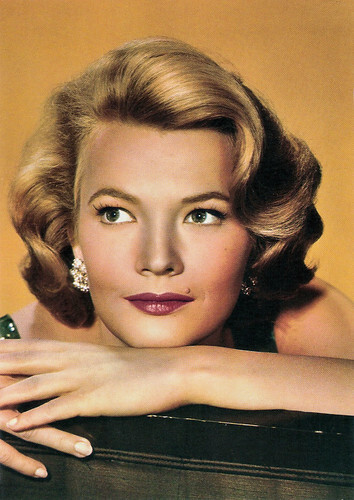
Italian postcard by Rotalfoto, Milano, no. N. 155.
Leaders in the independent film scene in the 1970s
Virginia Cathryn 'Gena' Rowlands was born in Madison, Wisconsin, in 1930. Rowlands was the daughter of the banker Edwyn Myrwyn Rowlands and his wife, the painter Mary Allen Neal. Gena grew up in Cambria, Wisconsin. In 1939, Edwyn Rowlands was appointed to political office in Washington, D.C. and the family followed him. Three years later, the family moved to Minneapolis, Minnesota. Gena Rowlands attended Lee High School and then studied at the University of Wisconsin.
She also completed classical acting training at the Academy of Dramatic Arts in New York City. There Gena met future actor and filmmaker John Cassavetes. They married in 1954. The couple had three children who also entered the film world. Nick Cassavetes followed in his father's footsteps and also became a director. Alexandra Katherine and Zoe R. Cassavetes are both actresses and directors. Rowlands and Cassavetes remained together until Cassavetes died in 1989.
Gena Rowlands made her stage debut at the Provincetown Playhouse in New York, where she had started as a wardrobe mistress. Rowlands made her first appearance in a television series in 1954 and over the decades has appeared as a guest actress in classic series such as Bonanza, 77 Sunset Strip, The People of Shiloh Ranch and Columbo. She made her Broadway breakthrough at the age of 26 in Paddy Chayefsky's romantic drama 'Middle of the Night (1956). This helped her towards a Hollywood studio contract.
As an MGM contract actress, she debuted in José Ferrer's comedy High Cost of Loving (1958). Four years later, Rowland had the leading female role in the Western Lonely are the Brave (David Miller, 1962) alongside Kirk Douglas . She kept returning to the theatre and began to appear frequently in films directed by her husband John Cassavetes from 1959 onwards. As a couple, Rowlands and Cassavetes were leaders in the independent film scene in the 1970s in the US. Cassavetes was considered a pioneer of cinema vérité, a documentary-style film. Film historian Richard Brody compared their innovative films to the collaboration between Jean-Luc Godard and his former wife Anna Karina .
They made ten films together: A Child Is Waiting (John Cassavetes, 1963) with Judy Garland , Faces (John Cassavetes, 1968), the Italian crime film Gli intoccabili/Machine Gun McCain (Giuliano Montaldo, 1969), Minnie and Moskowitz (John Cassavetes, 1971) with Seymour Cassel, A Woman Under the Influence (John Cassavetes, 1974), Two-Minute Warning (Larry Peerce, 1976) starring Charlton Heston , Opening Night (John Cassavetes, 1977), Gloria (John Cassavetes, (1980), Tempest (Paul Mazursky, 1982) with Susan Sarandon, and Love Streams (John Cassavetes, 1984). Rowlands was nominated for an Oscar for her roles in his films A Woman Under the Influence (1974) and Gloria (1980) but missed out on the Academy Award in both cases.
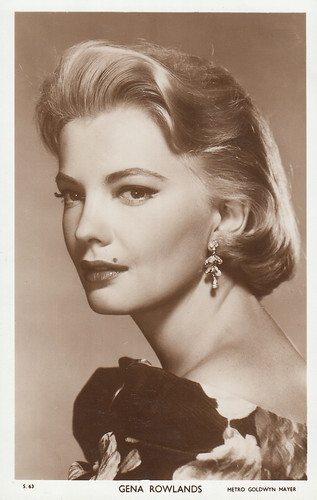
British postcard in the Picturegoer Series, London, no. S. 63. Photo: Metro Goldwyn Mayer. Collection: Marlene Pilaete.
More than 20 film awards
Gena Rowlands remained active into old age. Apart from her husband, she also filmed with many other well-known directors. She played the lead role in Woody Allen's Another Woman (1989) and acted under Jim Jarmusch in Night on Earth (1991). In 1998, she played Sandra Bullock 's mother in Hope Floats (Forest Whitaker, 1998). That same year she also made major appearances in Paulie (John Roberts, 1988) and The Mighty (Peter Chelsom, 1998) with Kieran Culkin and Sharon Stone .
Her son Nick Cassavetes also cast the actress in several of his films. One of her best-known later roles was in Nick's romantic drama The Notebook (Nick Cassavetes, 2004) with James Garner and Ryan Gosling. In the film, she plays a woman with dementia. She won a Golden Satellite Award for her role.
During her career, she won more than 20 film awards, including the Silver Bear for Opening Night (John Cassavetes, 1977). She garnered Emmy Awards for her portrayal of the occasionally alcoholic presidential wife Betty Ford in the TV Movie The Betty Ford Story (David Greene, 1987), for Face of a Stranger (Claudia Weill, 1991) and for Hysterical Blindness (Mira Nair, 2002) with Uma Thurman .
In 2015, the then 85-year-old actress received an honorary Oscar in recognition of her entire career. The New Yorker wrote in 2016 about their oeuvre: ‘Together with Rowlands, Cassavetes managed to make independent films with Hollywood influences - not in plot and style but in acting, with allure and dramatic power'.
Surrounded by her family, Gena Rowlands died in her home in Indian Wells, Southern California, on 14 August 2024. She was 94. Her death was confirmed by the impresario of her son, director Nick Cassavetes (65). Cassavetes announced in June that his mother had been suffering from Alzheimer's for several years. Since 2012, she has been married to Robert Forrest.
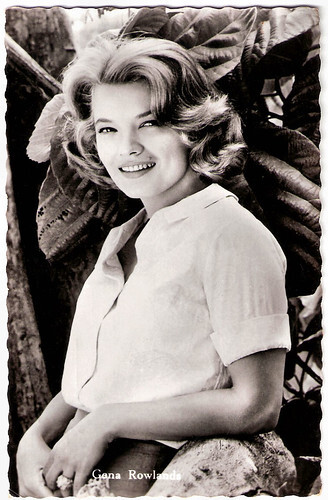
Dutch postcard. Photo: Universal. Gena Rowlands in The Spiral Road (Robert Mulligan, 1962), based on the novel by Jan de Hartog.
Sources: NOS (Dutch), Wikipedia (Dutch and German) and .

Italian postcard by Rotalfoto, Milano, no. N. 155.
Leaders in the independent film scene in the 1970s
Virginia Cathryn 'Gena' Rowlands was born in Madison, Wisconsin, in 1930. Rowlands was the daughter of the banker Edwyn Myrwyn Rowlands and his wife, the painter Mary Allen Neal. Gena grew up in Cambria, Wisconsin. In 1939, Edwyn Rowlands was appointed to political office in Washington, D.C. and the family followed him. Three years later, the family moved to Minneapolis, Minnesota. Gena Rowlands attended Lee High School and then studied at the University of Wisconsin.
She also completed classical acting training at the Academy of Dramatic Arts in New York City. There Gena met future actor and filmmaker John Cassavetes. They married in 1954. The couple had three children who also entered the film world. Nick Cassavetes followed in his father's footsteps and also became a director. Alexandra Katherine and Zoe R. Cassavetes are both actresses and directors. Rowlands and Cassavetes remained together until Cassavetes died in 1989.
Gena Rowlands made her stage debut at the Provincetown Playhouse in New York, where she had started as a wardrobe mistress. Rowlands made her first appearance in a television series in 1954 and over the decades has appeared as a guest actress in classic series such as Bonanza, 77 Sunset Strip, The People of Shiloh Ranch and Columbo. She made her Broadway breakthrough at the age of 26 in Paddy Chayefsky's romantic drama 'Middle of the Night (1956). This helped her towards a Hollywood studio contract.
As an MGM contract actress, she debuted in José Ferrer's comedy High Cost of Loving (1958). Four years later, Rowland had the leading female role in the Western Lonely are the Brave (David Miller, 1962) alongside Kirk Douglas . She kept returning to the theatre and began to appear frequently in films directed by her husband John Cassavetes from 1959 onwards. As a couple, Rowlands and Cassavetes were leaders in the independent film scene in the 1970s in the US. Cassavetes was considered a pioneer of cinema vérité, a documentary-style film. Film historian Richard Brody compared their innovative films to the collaboration between Jean-Luc Godard and his former wife Anna Karina .
They made ten films together: A Child Is Waiting (John Cassavetes, 1963) with Judy Garland , Faces (John Cassavetes, 1968), the Italian crime film Gli intoccabili/Machine Gun McCain (Giuliano Montaldo, 1969), Minnie and Moskowitz (John Cassavetes, 1971) with Seymour Cassel, A Woman Under the Influence (John Cassavetes, 1974), Two-Minute Warning (Larry Peerce, 1976) starring Charlton Heston , Opening Night (John Cassavetes, 1977), Gloria (John Cassavetes, (1980), Tempest (Paul Mazursky, 1982) with Susan Sarandon, and Love Streams (John Cassavetes, 1984). Rowlands was nominated for an Oscar for her roles in his films A Woman Under the Influence (1974) and Gloria (1980) but missed out on the Academy Award in both cases.

British postcard in the Picturegoer Series, London, no. S. 63. Photo: Metro Goldwyn Mayer. Collection: Marlene Pilaete.
More than 20 film awards
Gena Rowlands remained active into old age. Apart from her husband, she also filmed with many other well-known directors. She played the lead role in Woody Allen's Another Woman (1989) and acted under Jim Jarmusch in Night on Earth (1991). In 1998, she played Sandra Bullock 's mother in Hope Floats (Forest Whitaker, 1998). That same year she also made major appearances in Paulie (John Roberts, 1988) and The Mighty (Peter Chelsom, 1998) with Kieran Culkin and Sharon Stone .
Her son Nick Cassavetes also cast the actress in several of his films. One of her best-known later roles was in Nick's romantic drama The Notebook (Nick Cassavetes, 2004) with James Garner and Ryan Gosling. In the film, she plays a woman with dementia. She won a Golden Satellite Award for her role.
During her career, she won more than 20 film awards, including the Silver Bear for Opening Night (John Cassavetes, 1977). She garnered Emmy Awards for her portrayal of the occasionally alcoholic presidential wife Betty Ford in the TV Movie The Betty Ford Story (David Greene, 1987), for Face of a Stranger (Claudia Weill, 1991) and for Hysterical Blindness (Mira Nair, 2002) with Uma Thurman .
In 2015, the then 85-year-old actress received an honorary Oscar in recognition of her entire career. The New Yorker wrote in 2016 about their oeuvre: ‘Together with Rowlands, Cassavetes managed to make independent films with Hollywood influences - not in plot and style but in acting, with allure and dramatic power'.
Surrounded by her family, Gena Rowlands died in her home in Indian Wells, Southern California, on 14 August 2024. She was 94. Her death was confirmed by the impresario of her son, director Nick Cassavetes (65). Cassavetes announced in June that his mother had been suffering from Alzheimer's for several years. Since 2012, she has been married to Robert Forrest.

Dutch postcard. Photo: Universal. Gena Rowlands in The Spiral Road (Robert Mulligan, 1962), based on the novel by Jan de Hartog.
Sources: NOS (Dutch), Wikipedia (Dutch and German) and .
Published on August 16, 2024 22:00
August 15, 2024
Memo Benassi
Italian actor Memo Benassi (1891-1957), was among the leading exponents of the theatrical generation that marked the transition from nineteenth-century 'mattatore' ('monstre sacré') to contemporary actor. From 1916 on, he acted in silent films, but only after the sound film set in, Benassi flourished as a screen actor.
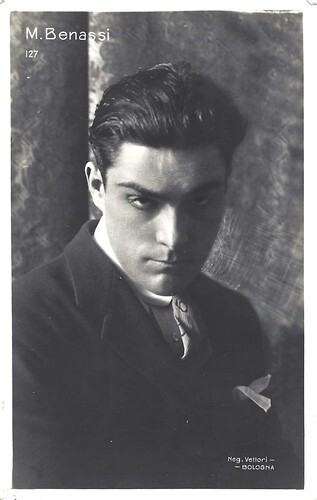
Italian postcard by Ed. Vettori, Bologna, no. 127.
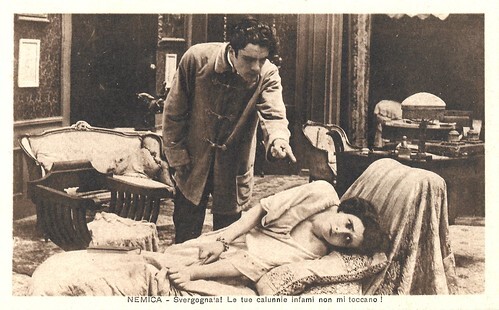
Italian postcard by IPA CT, Duplex, no. 7207. V. Uff. Rev. St., Terni. Photo: Silentium Film. Linda Pini and a young Memo Benassi in the Italian silent film La nemica/The Enemy (Ivo Illuminati, 1917), adapted from the play by Dario Niccodemi. Caption: You shameless one! Your infamous slander cannot hurt me!
A noble mask, a soft and pliant voice and an imposing physique
Memo Benassi was born Domenico Benassi in Sorbolo,Italy, in 1891. After studying acting in Milan, Benassi debuted as a generic in Ermete Novelli 's company. His first big break came in 1921 when he joined the company of Eleonora Duse . He played alongside her as Oswald in Henrik Ibsen's 'Spectres'. He would be alongside the famous actress until her last tour in Pittsburgh in 1924.
Extrovertedly using his natural gifts (his noble mask, soft and pliant voice and imposing physique), Benassi gave life to a great variety of interpretations. He expressed himself, always bordering on the grotesque and eccentric, with shifting rhythms, now fast or rushed, now broken and loose. Among his interpretations are those of the Shakespearean characters Shylock in 'The Merchant of Venice, Mark Antony in 'Julius Caesar', Thersites in 'Troilus and Cressida', Mercutio in Romeo and Juliet', and Oswald in Henrik Ibsen's 'The Spectres' and Veršinin in Anton Chekhov's 'Three Sisters'.
In 1933 he was Oberon in 'A Midsummer Night's Dream', directed by Max Reinhardt , with Evi Maltagliati , Rina Morelli and Luigi Almirante . In the same year, at the Chiostro Grande of the Basilica of Santa Croce in Florence, he played the Devil in the world premiere of Ildebrando Pizzetti's 'La rappresentazione di Santa Uliva', directed by Jacques Copeau, with Rina Morelli, Andreina Pagnani and Roldano Lupi .
In 1943 it was the turn of Igor Stravinsky's 'Histoire du soldat', with Mario Colli, and Pizzetti's 'La sacra rappresentazione di Abram e d'Isaac', with Laura Carli and Clara Petrella, at the Teatro La Fenice in Venice. The following year he tackled the role of Ernesto in Christian Friedrich Hebbel's 'Agnes Bernauer', directed by Corrado Pavolini, with Vittorio Gassman , Elena Zareschi and Ernesto Calindri.
In 1949, again alongside Vittorio Gassman , he played Tersite in Shakespeare's 'Troilus and Cressida', directed by Luchino Visconti , in which Giorgio Albertazzi made his debut. In 1954 Roberto Rossellini called Benassi to play Frère Dominique in Arthur Honegger's 'Joan of Arc at the Stake', opposite Ingrid Bergman , at the Teatro alla Scala in Milan.
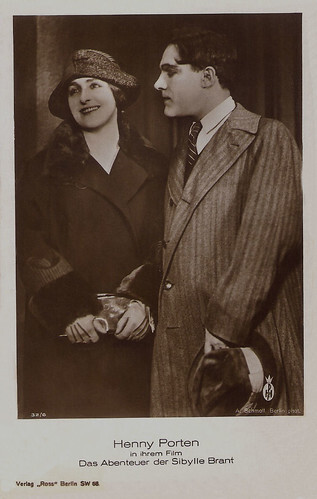
German postcard by Ross Verlag, no. 32/6. Photo: A. Schmoll, Berlin / Henny Porten-Froehlich-Produktion. Henny Porten and Memo Benassi in the German silent film Das Abenteuer der Sibylle Brant/The Adventures of Sybil Brent (Carl Froehlich, 1925).
[image error]
Italian postcard by Rizzoli, Milano, 1934-XII. Photo: Novella-Film. Isa Miranda , Tatiana Pavlova and Memo Benassi in La signora di tutti/Everybody's Woman (Max Ophüls, 1934).
A volatile and tormented personality
Memo Benassi also worked for radio and film. Between 1916 and 1920 he acted in seven Italian silent films, mostly at the company Silentium Film, including the Dario Niccodemi adaptation La nemica/The Enemy (Ivo Illuminati, 1917) starring Linda Pini. Afterwards, Benassi did two German silent films: Liebesbriefe der Baronin von S.../The Love Letters of Baroness S (Henrik Galeen, 1924) with Mia May , and Das Abenteuer der Sibylle Brant/The Adventures of Sybil Brent (Carl Froehlich, 1925) with Henny Porten .
Yet, it was when sound film had firmly set in in Italy that Benassi flourished as a screen actor. He was Judge Haller in Alessandro Blasetti's psychological drama Il caso Haller/The Haller Case (1933), also with Marta and Cele Abba and Camillo Pilotto . He was banker Monti whose spoiled daughter ( Elsa De Giorgi ) is taught a lesson in L'impiegata di papà/Daddy's employee (Alessandro Blasetti, 1934). He was the married industrial Leonardo Nanni who ruined himself for the Lulu-like young Gabriella ( Isa Miranda ) in La signora di tutti/Everybody's Woman (Max Ophüls, 1934).
Benassi acted many major parts in historical films, such as Cato in Scipione l'Africano/Scipio Africanus: The Defeat of Hannibal (Carmine Gallone, 1937), as the Russian ambassador in La principessa Tarakanova/Princess Tarakanova (Fyodor Otsep, Mario Soldati, 1938), as Tornaquinci in La cena delle beffe/The Jester's Supper (Alessandro Blasetti, 1942), as Donato Almorò in I due Foscari/The Two Orphans (Enrico Fulchignoni, 1942), and as Beethoven in Rossini (Mario Bonnard, 1942). After the war, Benassi would again play in historical films e.g. as the painter Cesare in Max Neufeld's Il tiranno di Padova/The Tyrant of Padua (1946) and as Emperor Claudius in Messalina/The Affairs of Messalina (Carmine Gallone, 1951).
From then on, Benassi's parts became scarce and even uncredited. His last major part was in Guido Salvini's Adriana Lecouvreur (1955), with Valentina Cortese in the title role. In the early days of television Benassi also took part in some transpositions of great classics, such as Hamlet (Luigi Squarzina, 1955), with Vittorio Gassman and Elena Zareschi, The Merchant of Venice (Mario Ferrero, 1955) with Romolo Valli and Anna Maria Guarnieri, and Henry IV (Claudio Fino, 1956), with Paola Borboni and Mario Scaccia.
Memo Benassi died in Bologna in 1957, at the age of 65. He was the victim of a cerebral haemorrhage, shortly after recording Anton Chekhov's 'The Swan Song' for RAI. A volatile and tormented personality, inconstant in his acting performance, Benassi was a living testimony to the crisis of the Italian theatre and an era of transition. On the occasion of the 50th anniversary of this actor's passing, a biography has been published, 'Memo Benassi. A Great Different Actor' by Leonardo Bragaglia. He is interred in the village of his birth, Sorbolo. It has named a street after him and has placed a copy of Benassi's mask by sculptor Luigi Froni in the atrium of the civic centre.
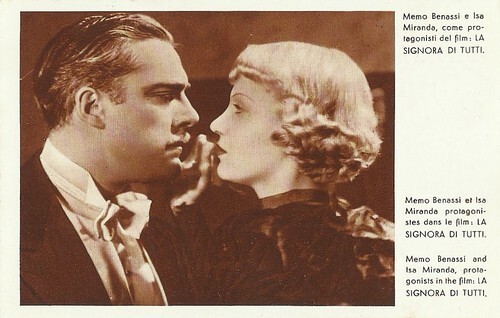
Italian postcard by Rizzoli, Milano, 1934-XII. Photo: Novella-Film. Isa Miranda and Memo Benassi in La signora di tutti/Everybody's Woman (Max Ophüls, 1934).
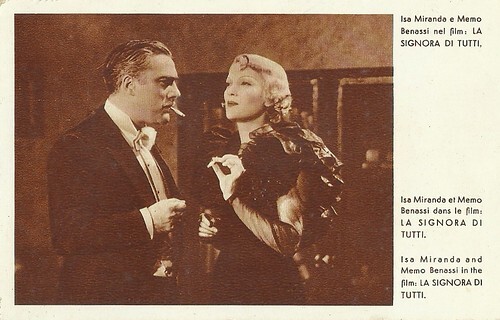
Italian postcard by Rizzoli, Milano, 1934-XII. Photo: Novella-Film. Isa Miranda and Memo Benassi in La signora di tutti/Everybody's Woman (Max Ophüls, 1934).
Sources: Wikipedia (Italian and English) and .

Italian postcard by Ed. Vettori, Bologna, no. 127.

Italian postcard by IPA CT, Duplex, no. 7207. V. Uff. Rev. St., Terni. Photo: Silentium Film. Linda Pini and a young Memo Benassi in the Italian silent film La nemica/The Enemy (Ivo Illuminati, 1917), adapted from the play by Dario Niccodemi. Caption: You shameless one! Your infamous slander cannot hurt me!
A noble mask, a soft and pliant voice and an imposing physique
Memo Benassi was born Domenico Benassi in Sorbolo,Italy, in 1891. After studying acting in Milan, Benassi debuted as a generic in Ermete Novelli 's company. His first big break came in 1921 when he joined the company of Eleonora Duse . He played alongside her as Oswald in Henrik Ibsen's 'Spectres'. He would be alongside the famous actress until her last tour in Pittsburgh in 1924.
Extrovertedly using his natural gifts (his noble mask, soft and pliant voice and imposing physique), Benassi gave life to a great variety of interpretations. He expressed himself, always bordering on the grotesque and eccentric, with shifting rhythms, now fast or rushed, now broken and loose. Among his interpretations are those of the Shakespearean characters Shylock in 'The Merchant of Venice, Mark Antony in 'Julius Caesar', Thersites in 'Troilus and Cressida', Mercutio in Romeo and Juliet', and Oswald in Henrik Ibsen's 'The Spectres' and Veršinin in Anton Chekhov's 'Three Sisters'.
In 1933 he was Oberon in 'A Midsummer Night's Dream', directed by Max Reinhardt , with Evi Maltagliati , Rina Morelli and Luigi Almirante . In the same year, at the Chiostro Grande of the Basilica of Santa Croce in Florence, he played the Devil in the world premiere of Ildebrando Pizzetti's 'La rappresentazione di Santa Uliva', directed by Jacques Copeau, with Rina Morelli, Andreina Pagnani and Roldano Lupi .
In 1943 it was the turn of Igor Stravinsky's 'Histoire du soldat', with Mario Colli, and Pizzetti's 'La sacra rappresentazione di Abram e d'Isaac', with Laura Carli and Clara Petrella, at the Teatro La Fenice in Venice. The following year he tackled the role of Ernesto in Christian Friedrich Hebbel's 'Agnes Bernauer', directed by Corrado Pavolini, with Vittorio Gassman , Elena Zareschi and Ernesto Calindri.
In 1949, again alongside Vittorio Gassman , he played Tersite in Shakespeare's 'Troilus and Cressida', directed by Luchino Visconti , in which Giorgio Albertazzi made his debut. In 1954 Roberto Rossellini called Benassi to play Frère Dominique in Arthur Honegger's 'Joan of Arc at the Stake', opposite Ingrid Bergman , at the Teatro alla Scala in Milan.

German postcard by Ross Verlag, no. 32/6. Photo: A. Schmoll, Berlin / Henny Porten-Froehlich-Produktion. Henny Porten and Memo Benassi in the German silent film Das Abenteuer der Sibylle Brant/The Adventures of Sybil Brent (Carl Froehlich, 1925).
[image error]
Italian postcard by Rizzoli, Milano, 1934-XII. Photo: Novella-Film. Isa Miranda , Tatiana Pavlova and Memo Benassi in La signora di tutti/Everybody's Woman (Max Ophüls, 1934).
A volatile and tormented personality
Memo Benassi also worked for radio and film. Between 1916 and 1920 he acted in seven Italian silent films, mostly at the company Silentium Film, including the Dario Niccodemi adaptation La nemica/The Enemy (Ivo Illuminati, 1917) starring Linda Pini. Afterwards, Benassi did two German silent films: Liebesbriefe der Baronin von S.../The Love Letters of Baroness S (Henrik Galeen, 1924) with Mia May , and Das Abenteuer der Sibylle Brant/The Adventures of Sybil Brent (Carl Froehlich, 1925) with Henny Porten .
Yet, it was when sound film had firmly set in in Italy that Benassi flourished as a screen actor. He was Judge Haller in Alessandro Blasetti's psychological drama Il caso Haller/The Haller Case (1933), also with Marta and Cele Abba and Camillo Pilotto . He was banker Monti whose spoiled daughter ( Elsa De Giorgi ) is taught a lesson in L'impiegata di papà/Daddy's employee (Alessandro Blasetti, 1934). He was the married industrial Leonardo Nanni who ruined himself for the Lulu-like young Gabriella ( Isa Miranda ) in La signora di tutti/Everybody's Woman (Max Ophüls, 1934).
Benassi acted many major parts in historical films, such as Cato in Scipione l'Africano/Scipio Africanus: The Defeat of Hannibal (Carmine Gallone, 1937), as the Russian ambassador in La principessa Tarakanova/Princess Tarakanova (Fyodor Otsep, Mario Soldati, 1938), as Tornaquinci in La cena delle beffe/The Jester's Supper (Alessandro Blasetti, 1942), as Donato Almorò in I due Foscari/The Two Orphans (Enrico Fulchignoni, 1942), and as Beethoven in Rossini (Mario Bonnard, 1942). After the war, Benassi would again play in historical films e.g. as the painter Cesare in Max Neufeld's Il tiranno di Padova/The Tyrant of Padua (1946) and as Emperor Claudius in Messalina/The Affairs of Messalina (Carmine Gallone, 1951).
From then on, Benassi's parts became scarce and even uncredited. His last major part was in Guido Salvini's Adriana Lecouvreur (1955), with Valentina Cortese in the title role. In the early days of television Benassi also took part in some transpositions of great classics, such as Hamlet (Luigi Squarzina, 1955), with Vittorio Gassman and Elena Zareschi, The Merchant of Venice (Mario Ferrero, 1955) with Romolo Valli and Anna Maria Guarnieri, and Henry IV (Claudio Fino, 1956), with Paola Borboni and Mario Scaccia.
Memo Benassi died in Bologna in 1957, at the age of 65. He was the victim of a cerebral haemorrhage, shortly after recording Anton Chekhov's 'The Swan Song' for RAI. A volatile and tormented personality, inconstant in his acting performance, Benassi was a living testimony to the crisis of the Italian theatre and an era of transition. On the occasion of the 50th anniversary of this actor's passing, a biography has been published, 'Memo Benassi. A Great Different Actor' by Leonardo Bragaglia. He is interred in the village of his birth, Sorbolo. It has named a street after him and has placed a copy of Benassi's mask by sculptor Luigi Froni in the atrium of the civic centre.

Italian postcard by Rizzoli, Milano, 1934-XII. Photo: Novella-Film. Isa Miranda and Memo Benassi in La signora di tutti/Everybody's Woman (Max Ophüls, 1934).

Italian postcard by Rizzoli, Milano, 1934-XII. Photo: Novella-Film. Isa Miranda and Memo Benassi in La signora di tutti/Everybody's Woman (Max Ophüls, 1934).
Sources: Wikipedia (Italian and English) and .
Published on August 15, 2024 22:00
August 14, 2024
Vivian Blaine
Vivian Blaine (1921-1995) was a talented American stage and film actress and singer. She became famous as Miss Adelaide, the long-suffering chorus girl with a heart of gold in the original Broadway production of the musical ‘Guys and Dolls’ (1950). She reprised the role in the 1955 film adaptation. Throughout her career, Blaine appeared in a total of 20 film productions.
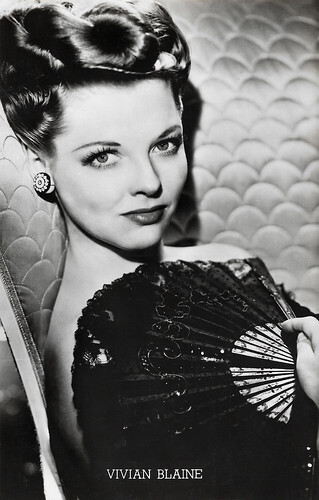
Dutch postcard, no. 851. Photo: 20th Century Fox.
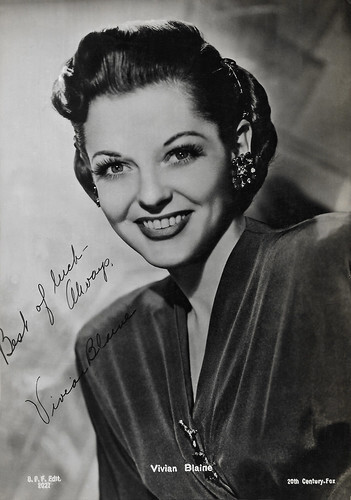
Italian postcard by B.F.F. Edit., no. 2027. Photo: 20th Century Fox.
Following the ad-libs of Stan Laurel
Vivian Blaine was born Vivian Stapleton in Newark, in 1921. She was the daughter of insurance agent Lionel 'Leo’ Stapleton and Wilhelmina Tepley. Her parents divorced when she was quite young. The cherry-blonde-haired Vivian appeared on local stages as early as 1934 and she started touring after graduating from South Side High School.
She performed as a singer and dancer in various nightclubs such as the Copacabana in New York from 1937. At the same time, Stapleton's stage name Vivian Blaine was born. In 1942, Blaine's agent and soon-to-be husband Manny Franks arranged that she signed a contract with 20th Century Fox. Franks made her lose 40 pounds before she could make her film debut.
She debuted in the sports film It Happened in Flatbush (Ray McCarey, 1942) with Lloyd Nolan and Carole Landis. In 1943, she starred alongside Stan Laurel and Oliver Hardy in the comedy Jitterbugs (Malcolm St. Clair, 1943). Stan Laurel highly respected her for being able to follow his ad-libs and participate in the comic bits without breaking up and ruining the scene.
Two years later, she appeared in Nob Hill (Henry Hathaway, 1945) alongside George Raft and Joan Bennett . In about four films in the 1940s, Blaine starred alongside Carmen Miranda, including the comedy-drama Greenwich Village (Walter Lang, 1944).
She played the role of Emily Edwards in the musical film State Fair (Walter Lang, 1945) alongside Jeanne Crain and Dana Andrews . As Blaine had experience as a singer, she was allowed to sing her songs herself, while the other actors except Dick Haymes were dubbed by professional singers, as was customary at the time. The title ‘That's for Me’, which she sang in the film and later was released on Decca Records, remained in the Billboard magazine charts for four weeks, reaching number six. This was despite a ban by the film studio prohibiting the actors from releasing vocal recordings.
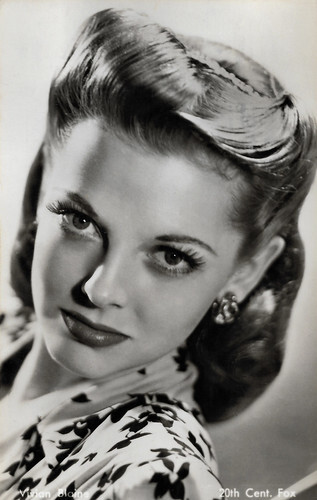
Dutch postcard by DRC, no. 39. Photo: 20th Century Fox M.P.E.A. Sent by mail in 1948.
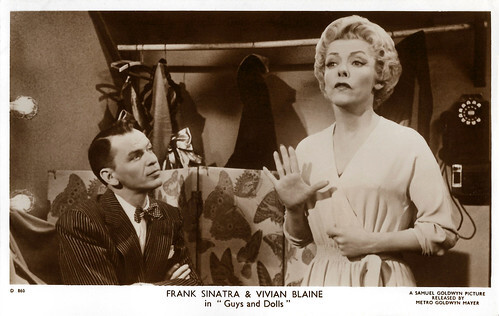
British postcard in the Picturegier Series, London, no. D 860. Photo: Samuel Goldwyn / MGM. Frank Sinatra and Vivian Blaine in Guys and Dolls (Joseph L. Mankiewicz, 1955).
She stopped the show each night
In addition to her career as a film actress, Vivian Blaine also appeared on Broadway in New York. Between 1950 and 1953, Blaine played Miss Adelaide in the musical ‘Guys and Dolls’ original cast. She stopped the show each night with her rendition of ‘Adelaide's Lament’, in which she complains about having a bad cold because of her long engagement to gambler Nathan Detroit. An album of the musical was released with the same cast that same year.
The unique language used by the gangsters and gamblers in the musical came from Damon Runyon's short stories ‘The Idyll Of Miss Sarah Brown’ and ‘Blood Pressure’. Blaine took over her role for the film version, Guys and Dolls (Joseph L. Mankiewicz, 1955), starring Marlon Brando , Frank Sinatra and Jean Simmons .
The film was shot in its entirety on the outside areas of the MGM studios (the Goldwyn Lot) where Times Square and parts of Broadway had been recreated. The set designers used the same logos in the neon signs as in Times Square but adapted them so that the company names became unrecognizable. The choreography of the songs was provided by Michael Kidd. Guys and Dolls was awarded two Golden Globes and received several Oscar nominations. The film was a huge success, raising $20 million worldwide on a budget of $5 million.
In 1957, she acted alongside Red Skelton in the comedy Public Pigeon No. 1 (Norman Z. MacLeod, 1957). One of her last films was the Sci-Fi-Horror film Parasite (Charles Band, 1982), with Demi Moore in her first major film role. Blaine's other Broadway appearances include roles in ‘A Hatful of Rain’ (1956-1958), 'Gypsy’ (1960 and 1962) and ‘Zorba’ (1970-1971 and 1984). After her Broadway appearance in ‘Company’ in 1972, she appeared on national television at the 25th Tony anniversary special. This led to a revival of her TV career with guest appearances on shows like Fantasy Island (1978), and The Love Boat (1978), and a recurring role in the cult hit Mary Hartman, Mary Hartman (1976).
In 1983, Blaine became the first celebrity to make public service announcements for AIDS-related causes. She made numerous appearances in support of the then-fledgling AIDS Project Los Angeles (APLA). Her final onscreen appearance was in Murder, She Wrote (1985). She played 'Rita Bristol' an ageing former star, trying to make a comeback. Blaine was married three times. She divorced her first husband, Manny Franks, in 1956. In 1959, she married Milton Rackmil, the head of Universal Pictures and Decca Records. They divorced in 1961. She took her third and final husband, electrician Stewart Clark, in 1973. In 1995, Vivian Blaine died of congestive heart failure in Beth Israel Hospital North in New York City at the age of 74. She was buried in the Kensico Cemetery in Valhalla, New York.
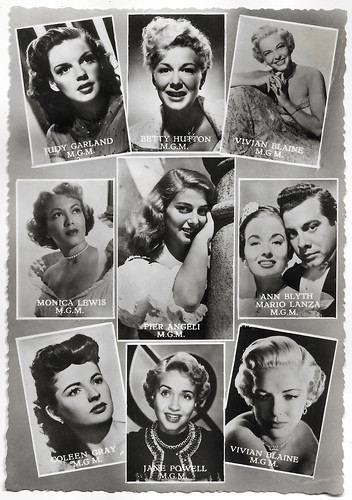
Dutch postcard by Sparo (Gebr. Spanjersberg N.V., Rotterdam). Photos: Metro-Goldwyn-Mayer. The picture stars are Judy Garland , Betty Hutton , Vivian Blaine (twice), Monica Lewis, Pier Angeli , Ann Blyth, Mario Lanza , Coleen Gray, and Jane Powell . The postcard must date from ca. 1951, when Blyth and Lanza starred together in The Great Caruso (Richard Thorpe, 1951).
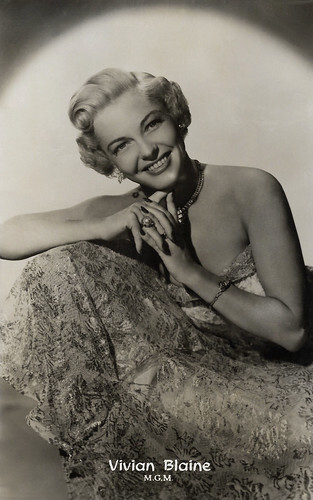
Vintage postcard. Photo: M.G.M.
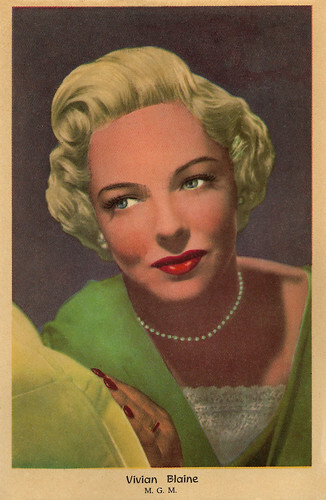
Vintage postcard. Photo: M.G.M.
Sources: Find A Grave, Wikipedia (Dutch, German and English) and IMDb.

Dutch postcard, no. 851. Photo: 20th Century Fox.

Italian postcard by B.F.F. Edit., no. 2027. Photo: 20th Century Fox.
Following the ad-libs of Stan Laurel
Vivian Blaine was born Vivian Stapleton in Newark, in 1921. She was the daughter of insurance agent Lionel 'Leo’ Stapleton and Wilhelmina Tepley. Her parents divorced when she was quite young. The cherry-blonde-haired Vivian appeared on local stages as early as 1934 and she started touring after graduating from South Side High School.
She performed as a singer and dancer in various nightclubs such as the Copacabana in New York from 1937. At the same time, Stapleton's stage name Vivian Blaine was born. In 1942, Blaine's agent and soon-to-be husband Manny Franks arranged that she signed a contract with 20th Century Fox. Franks made her lose 40 pounds before she could make her film debut.
She debuted in the sports film It Happened in Flatbush (Ray McCarey, 1942) with Lloyd Nolan and Carole Landis. In 1943, she starred alongside Stan Laurel and Oliver Hardy in the comedy Jitterbugs (Malcolm St. Clair, 1943). Stan Laurel highly respected her for being able to follow his ad-libs and participate in the comic bits without breaking up and ruining the scene.
Two years later, she appeared in Nob Hill (Henry Hathaway, 1945) alongside George Raft and Joan Bennett . In about four films in the 1940s, Blaine starred alongside Carmen Miranda, including the comedy-drama Greenwich Village (Walter Lang, 1944).
She played the role of Emily Edwards in the musical film State Fair (Walter Lang, 1945) alongside Jeanne Crain and Dana Andrews . As Blaine had experience as a singer, she was allowed to sing her songs herself, while the other actors except Dick Haymes were dubbed by professional singers, as was customary at the time. The title ‘That's for Me’, which she sang in the film and later was released on Decca Records, remained in the Billboard magazine charts for four weeks, reaching number six. This was despite a ban by the film studio prohibiting the actors from releasing vocal recordings.

Dutch postcard by DRC, no. 39. Photo: 20th Century Fox M.P.E.A. Sent by mail in 1948.

British postcard in the Picturegier Series, London, no. D 860. Photo: Samuel Goldwyn / MGM. Frank Sinatra and Vivian Blaine in Guys and Dolls (Joseph L. Mankiewicz, 1955).
She stopped the show each night
In addition to her career as a film actress, Vivian Blaine also appeared on Broadway in New York. Between 1950 and 1953, Blaine played Miss Adelaide in the musical ‘Guys and Dolls’ original cast. She stopped the show each night with her rendition of ‘Adelaide's Lament’, in which she complains about having a bad cold because of her long engagement to gambler Nathan Detroit. An album of the musical was released with the same cast that same year.
The unique language used by the gangsters and gamblers in the musical came from Damon Runyon's short stories ‘The Idyll Of Miss Sarah Brown’ and ‘Blood Pressure’. Blaine took over her role for the film version, Guys and Dolls (Joseph L. Mankiewicz, 1955), starring Marlon Brando , Frank Sinatra and Jean Simmons .
The film was shot in its entirety on the outside areas of the MGM studios (the Goldwyn Lot) where Times Square and parts of Broadway had been recreated. The set designers used the same logos in the neon signs as in Times Square but adapted them so that the company names became unrecognizable. The choreography of the songs was provided by Michael Kidd. Guys and Dolls was awarded two Golden Globes and received several Oscar nominations. The film was a huge success, raising $20 million worldwide on a budget of $5 million.
In 1957, she acted alongside Red Skelton in the comedy Public Pigeon No. 1 (Norman Z. MacLeod, 1957). One of her last films was the Sci-Fi-Horror film Parasite (Charles Band, 1982), with Demi Moore in her first major film role. Blaine's other Broadway appearances include roles in ‘A Hatful of Rain’ (1956-1958), 'Gypsy’ (1960 and 1962) and ‘Zorba’ (1970-1971 and 1984). After her Broadway appearance in ‘Company’ in 1972, she appeared on national television at the 25th Tony anniversary special. This led to a revival of her TV career with guest appearances on shows like Fantasy Island (1978), and The Love Boat (1978), and a recurring role in the cult hit Mary Hartman, Mary Hartman (1976).
In 1983, Blaine became the first celebrity to make public service announcements for AIDS-related causes. She made numerous appearances in support of the then-fledgling AIDS Project Los Angeles (APLA). Her final onscreen appearance was in Murder, She Wrote (1985). She played 'Rita Bristol' an ageing former star, trying to make a comeback. Blaine was married three times. She divorced her first husband, Manny Franks, in 1956. In 1959, she married Milton Rackmil, the head of Universal Pictures and Decca Records. They divorced in 1961. She took her third and final husband, electrician Stewart Clark, in 1973. In 1995, Vivian Blaine died of congestive heart failure in Beth Israel Hospital North in New York City at the age of 74. She was buried in the Kensico Cemetery in Valhalla, New York.

Dutch postcard by Sparo (Gebr. Spanjersberg N.V., Rotterdam). Photos: Metro-Goldwyn-Mayer. The picture stars are Judy Garland , Betty Hutton , Vivian Blaine (twice), Monica Lewis, Pier Angeli , Ann Blyth, Mario Lanza , Coleen Gray, and Jane Powell . The postcard must date from ca. 1951, when Blyth and Lanza starred together in The Great Caruso (Richard Thorpe, 1951).

Vintage postcard. Photo: M.G.M.

Vintage postcard. Photo: M.G.M.
Sources: Find A Grave, Wikipedia (Dutch, German and English) and IMDb.
Published on August 14, 2024 22:00
August 13, 2024
Directed by Marcel Pagnol
Marcel Pagnol (1895-1974) was a French writer, playwright, and film director. Pagnol is regarded as one of France's greatest 20th-century writers. His play ‘Marius’ became in 1931 the first of his works to be adapted into a film. Between 1933 and 1954, Marcel Pagnol made about 21 films.
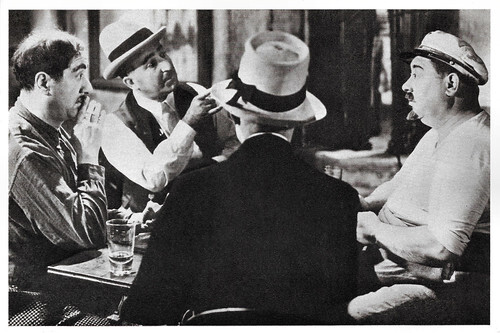
French postcard by Editions La Malibran, Paris / Saint-Dié, no. CF 22. Raimu , Fernand Charpin , Paul Dullac and Robert Vattier in Marius (Alexander Korda, 1931), written by Marcel Pagnol. Caption: The card game.
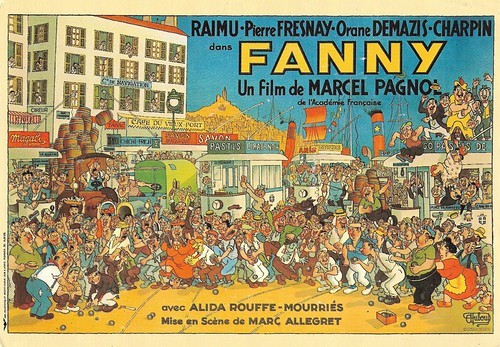
French postcard by CPM / Jean Dubout, 1982. Poster (1950) by Albert Dubout for Fanny (Marc Allégret, 1932), based on the play by Marcel Pagnol.
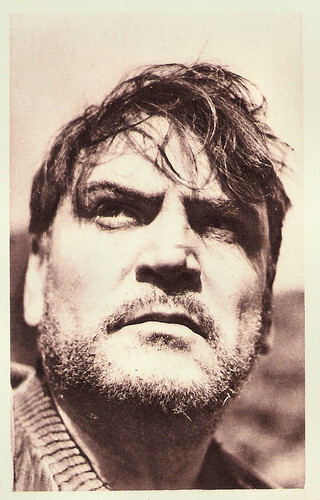
French postcard by Crépa, Editeur, Paris. Photo: Pierre Méré. Gabriel Gabrio as Panturle Regain/Harvest (Marcel Pagnol, 1937).
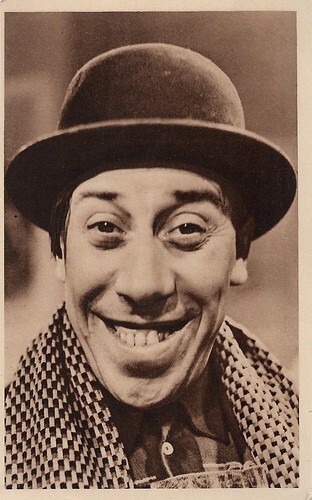
French postcard. Photo: Les Films Marcel Pagnol. Fernandel in Regain (Marcel Pagnol, 1937).
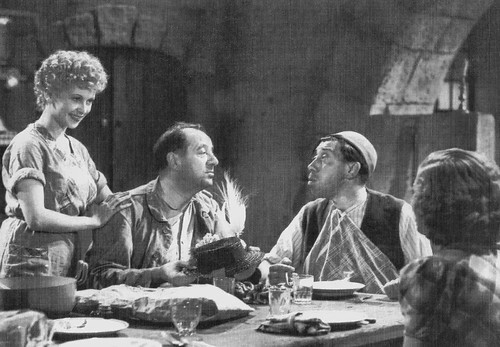
French postcard in the Raimu series by MPC (Marcel Pagnol Com), no. 46. Raimu , Fernandel and Josette Day in La fille du Puisatier (Marcel Pagnol, 1940), written by Marcel Pagnol.
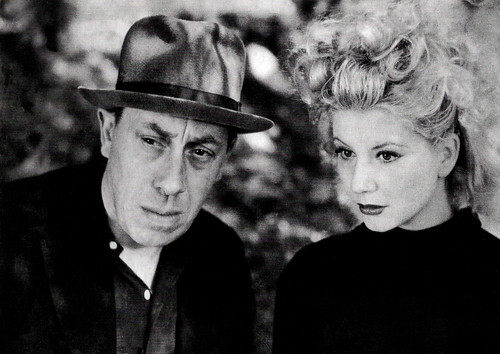
French postcard by MPC (Marcel Pagnol Com), no. 39. Photo: Henri Moiroud. Fernandel and Jacqueline Pagnol in Nais (Raymond Leboursier, Marcel Pagnol, 1945).
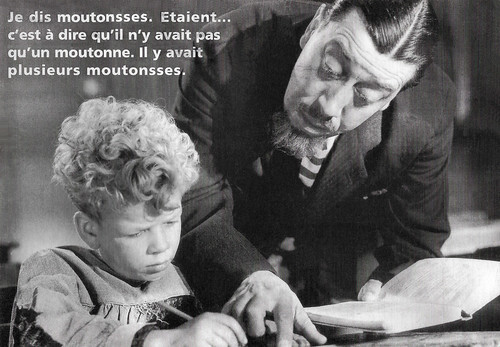
French postcard by DR MPC (Marcel Pagnol Com), no. 19. Photo: Pierre Mère. Fernandel and Michel Malloire in Topaze (Marcel Pagnol 1951).
Illuminating the provincial life of the lower class
Marcel Pagnol was born in 1895 in Aubagne, in southern France near Marseille He was the eldest son of schoolteacher Joseph Pagnol and seamstress Augustine Lansot. Pagnol grew up in Marseille with his younger brothers Paul and René, and younger sister Germaine. At secondary school in Marseille, he and some fellow pupils founded the magazine Fortunio, later Cahiers du Sud. In 1915, he was a reserve teacher at several schools. From 1923 to 1926, he was an English teacher at the Lycée Condorcet in Paris.
Pagnol began writing plays in 1922. The first ones remained unpublished. Together with his school friend Paul Nivoix, he wrote ‘Les Marchands de la Gloire’ in 1925. A year later, he wrote ’Jazz’, which became his first success. In 1928, he became known to the general public with ‘Topaze’, the play that marked his final breakthrough. It tells the story of a modest school teacher who is fired for being too honest and decides to become a dishonest businessman. Exiled in Paris, Pagnol returned nostalgically to his Provençal roots, taking this as his setting for his play ‘Marius’ (1929), which appeared a year later and also struck a chord with the general public. The follow-up play ‘Fanny’ (1932) appeared in the following years.
In 1929, on a visit to London, Marcel Pagnol attended a screening of one of the first talking films and he was so impressed that he decided to devote his efforts to cinema. He contacted Paramount Picture studios and suggested adapting his play ‘Marius' for cinema. The film was directed by Alexander Korda and released on 10 October 1931. Marius (Alexander Korda, 1931, starring Raimu , Pierre Fresnay and Orane Démazis , became one of the first successful French-language talking films. It was soon followed by the sequel Fanny (Marc Allégret 1932). Like Marius, the film was a box office success in France and is still considered to be a classic of French cinema.
In 1932 Pagnol founded a film production studio in the countryside near Marseille. He directed Jofroi (Marcel Pagnol, 1934) starring Vincent Scotto as a man who has sold his orchard. When the new owner wants to cut the trees down, the former owner threatens suicide. The film is based on the short story ‘Jofroi de la Maussan’ by Jean Giono. Over the next decade, Pagnol produced his own films, taking many different roles in the production – financier, director, scriptwriter, studio head, and foreign-language script translator – and employing the greatest French actors of the period.
Wikipedia : “In his films, Pagnol transfers his playwriting talents onto the big screen. His editing style is somberly reserved, placing emphasis on the content of an image. As a pictorial naturalist, Pagnol relies on film as art to convey a deeper meaning rather than solely as a tool to tell a story. Pagnol also took great care in the type of actors he employed, hiring local actors to appear in his films to highlight their unique accents and culture. Like his plays, Pagnol's films emphasize dialogue and musicality. The themes of many of Pagnol's films revolve around the acute observation of social rituals. Using interchangeable symbols and recurring character roles, such as proud fathers and rebellious children, Pagnol illuminates the provincial life of the lower class."
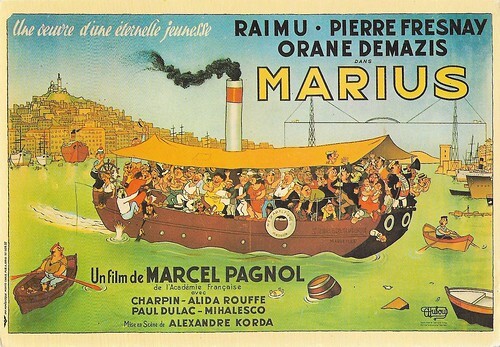
French postcard, Jean Dubout 1982, D2. 1950 poster by Albert Dubout for Marius (Alexander Korda, 1931), adapted from the play by Marcel Pagnol.
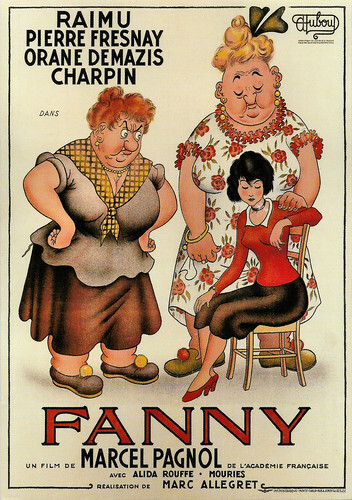
French postcard by Jean Dubout, Paris, 2009, D 49. Poster design by Albert Dubout (1950) for a re-issue of Fanny (Marc Allegret, 1932), written by Marcel Pagnol.
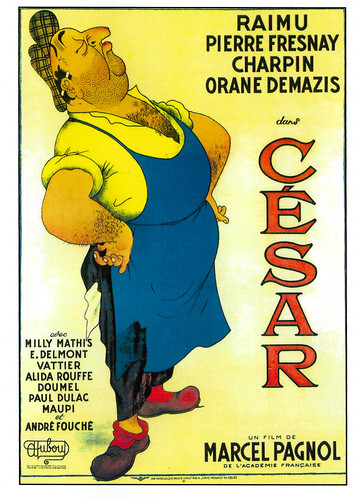
French postcard in the Encyclopédie du Cinéma series by ADAGP, Paris, 1999 / Carterie Artistique et Cinématographique, Pont du Casse, no. EDC 1088, Vis. 4. Poster design by Albert Dubout for César (Marcel Pagnol, 1936), written by Marcel Pagnol.
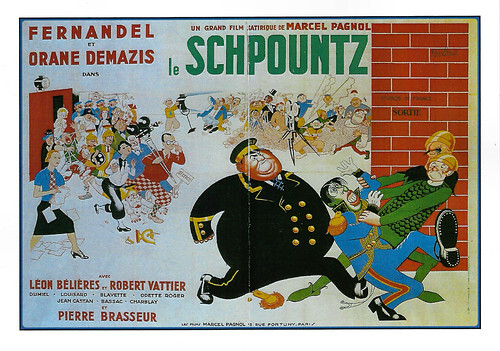
French postcard in the Encyclopédie du Cinéma series by Carterie Artistique et Cinématographique, Pont du Casse, no. EDC 2185, Vis. 01 FR. Poster design by Albert Dubout for Le Schpountz/Heartbeat (Marcel Pagnol, 1937) with Fernandel and Orane Demazis.
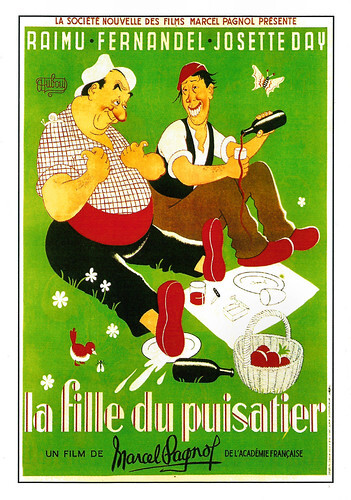
French postcard in the Encyclopédie du Cinéma series by ADAGP, Paris, 1999 / Carterie Artistique et Cinématographique, Pont du Casse, no. EDC 1102, Vis. 01 FR. Poster design by Albert Dubout for La fille du puisatier/The Well-Digger's Daughter (Marcel Pagnol, 1940) with Raimu and Fernandel .
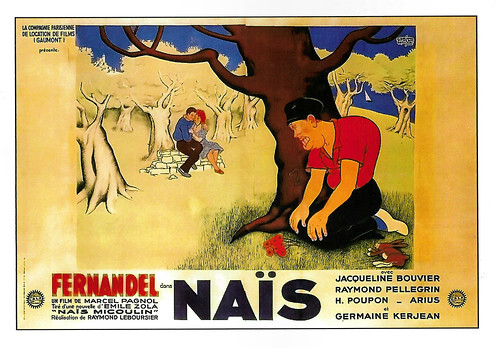
French postcard in the Encyclopédie du Cinéma series by ADAGP, Paris, 1999 / Carterie Artistique et Cinématographique, Pont du Casse, no. EDC 1285, Vis. 2. Poster design by Albert Dubout for Naïs (Raymond Lebourdier, Marcel Pagnol, 1945) with Fernandel .
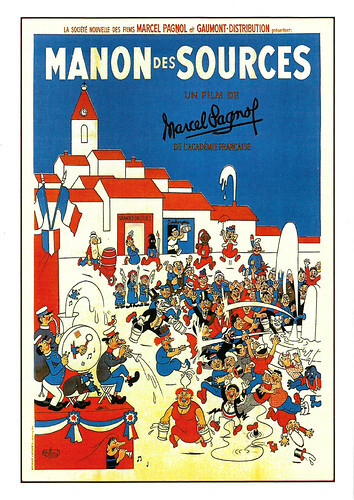
French postcard in the Encyclopédie du Cinéma series by Carterie Artistique et Cinématographique, Pont du Casse, no. EDC 1270, Vis. 03 FR R. 02. Poster design by Albert Dubout for Manon des sources/Manon of the Spring (Marcel Pagnol, 1952).
Pagnol's affectionate reminiscences of childhood
In 1945, Marcel Pagnol remarried Jacqueline Bouvier, who starred in some of his later films under the name Jacqueline Pagnol. They had two children together, Frédéric (born 1946) and Estelle (born 1949). Estelle died at the age of two. Pagnol was so devastated that he fled the south and returned to live in Paris.
He returned to writing plays, but after his next piece was badly received he decided to change his job once more and began writing a series of autobiographical novels – ‘Souvenirs d'enfance’ – based on his childhood experiences. In 1957, the first two novels in the series, ‘La gloire de mon père’ and ‘Le château de ma mère’ were published to instant acclaim. The third ‘Le Temps des secrets’ was published in 1959, and the fourth’ Le Temps des Amours’ was to remain unfinished and was not published until 1977, after his death.
In the meantime, Pagnol adapted his own film Manon des Sources (Marcel Pagnol, 1952) into two novels, 'Jean de Florette' and 'Manon des Sources', collectively titled ‘L'eau des collines’. The novels focused on the machinations of Provençal peasant life at the beginning of the twentieth century and were published in 1962.
In 1946, Pagnol was elected to the Académie Française, taking his seat in March 1947. He was the first filmmaker to receive this honour. Marcel Pagnol died in 1974 in Paris at the age of 79. He is buried in Marseille at the cemetery La Treille.
Since his death, many of his works have been adapted into films. In 1986, 'Jean de Florette' and 'Manon des Sources' were adapted by filmmaker Claude Berri. In 1990, 'La gloire de mon père' and 'Le château de ma mère', Pagnol's affectionate reminiscences of childhood, were filmed by Yves Robert. In 2000, Jacques Nahum produced 'Marius', 'Fanny', and 'César' for French television. In 2011, 'La fille du puisatier' was filmed by Daniel Auteuil. In 2013, 'Marius' and 'Fanny' were remade by Daniel Auteuil. In 2022, 'Le Temps Des Secrets' was adapted and filmed by Christophe Barratier.
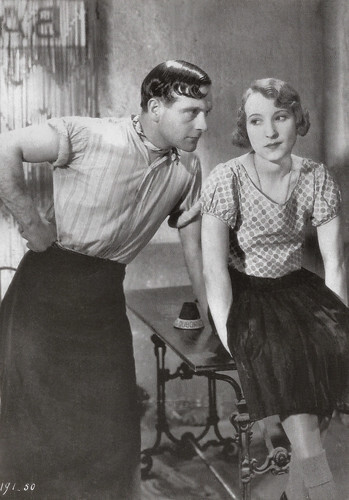
French postcard in the Raimu series by MPC (Marcel Pagnol Com), no. 11. Pierre Fresnay and Orane Démazis in Marius (Alexander Korda, 1931), written by Marcel Pagnol.
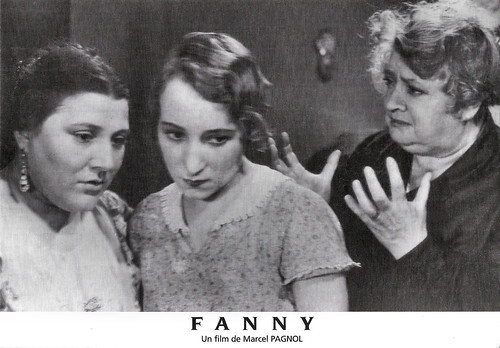
French postcard by MPC (Marcel-Pagnol.com), no. 21. Photo: Roger Foster. Orane Démazis , Alida Rouffe and Milly Mathis in Fanny (Marc Allegret, 1932), written by Marcel Pagnol.
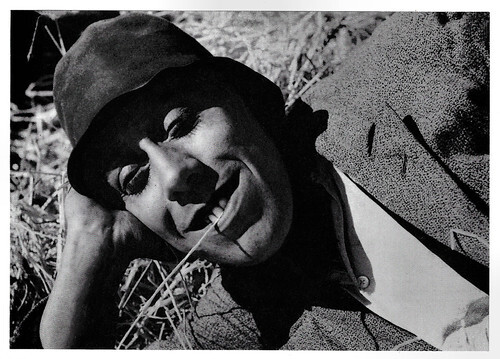
Swiss postcard by News Productions, Baulmes, no. 56505. Photo: Cinémathèque Suisse. Fernandel in Angèle (Marcel Pagnol, 1934).
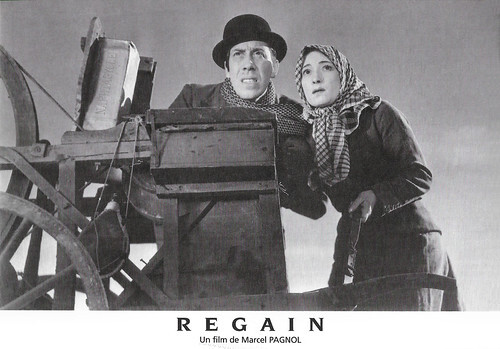
French postcard by MPC (Marcel-Pagnol.com), no. 20. Fernandel and Orane Démazis in Regain/Harvest (Marcel Pagnol, 1937).
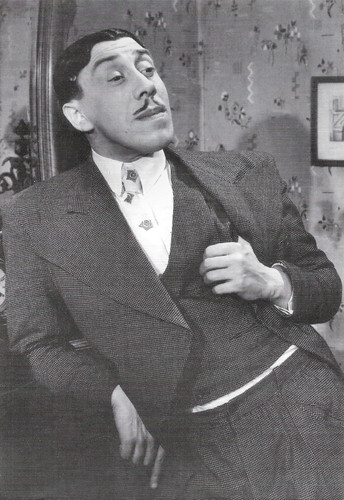
French postcard by DR MPC (Marcel Pagnol Com), no. 7. Photo: Roger Corbeau. Fernandel in Le Schpountz/Heartbeat (Marcel Pagnol, 1938).
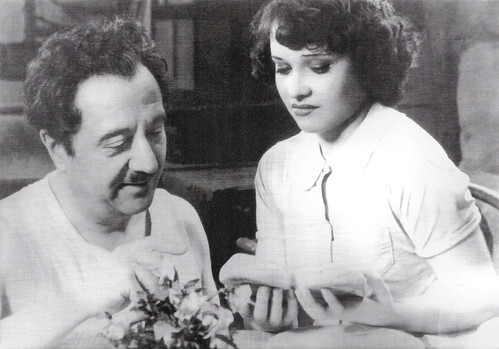
French postcard in the Raimu series by MPC (Marcel Pagnol Com), no. 36. Photo: Roger Corbeau. Raimu and Ginette Leclerc in La femme du boulanger/The Baker's Wife (Marcel Pagnol, 1938).
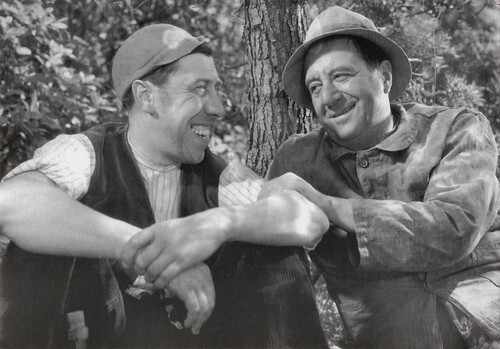
French postcard in the Raimu series by MPC (Marcel Pagnol Com), no. 33. Fernandel and Raimu in La fille du Puisatier/The Well-Digger's Daughter (Marcel Pagnol, 1940), written by Marcel Pagnol.
Sources: Wikipedia (Dutch and English) and .

French postcard by Editions La Malibran, Paris / Saint-Dié, no. CF 22. Raimu , Fernand Charpin , Paul Dullac and Robert Vattier in Marius (Alexander Korda, 1931), written by Marcel Pagnol. Caption: The card game.

French postcard by CPM / Jean Dubout, 1982. Poster (1950) by Albert Dubout for Fanny (Marc Allégret, 1932), based on the play by Marcel Pagnol.

French postcard by Crépa, Editeur, Paris. Photo: Pierre Méré. Gabriel Gabrio as Panturle Regain/Harvest (Marcel Pagnol, 1937).

French postcard. Photo: Les Films Marcel Pagnol. Fernandel in Regain (Marcel Pagnol, 1937).

French postcard in the Raimu series by MPC (Marcel Pagnol Com), no. 46. Raimu , Fernandel and Josette Day in La fille du Puisatier (Marcel Pagnol, 1940), written by Marcel Pagnol.

French postcard by MPC (Marcel Pagnol Com), no. 39. Photo: Henri Moiroud. Fernandel and Jacqueline Pagnol in Nais (Raymond Leboursier, Marcel Pagnol, 1945).

French postcard by DR MPC (Marcel Pagnol Com), no. 19. Photo: Pierre Mère. Fernandel and Michel Malloire in Topaze (Marcel Pagnol 1951).
Illuminating the provincial life of the lower class
Marcel Pagnol was born in 1895 in Aubagne, in southern France near Marseille He was the eldest son of schoolteacher Joseph Pagnol and seamstress Augustine Lansot. Pagnol grew up in Marseille with his younger brothers Paul and René, and younger sister Germaine. At secondary school in Marseille, he and some fellow pupils founded the magazine Fortunio, later Cahiers du Sud. In 1915, he was a reserve teacher at several schools. From 1923 to 1926, he was an English teacher at the Lycée Condorcet in Paris.
Pagnol began writing plays in 1922. The first ones remained unpublished. Together with his school friend Paul Nivoix, he wrote ‘Les Marchands de la Gloire’ in 1925. A year later, he wrote ’Jazz’, which became his first success. In 1928, he became known to the general public with ‘Topaze’, the play that marked his final breakthrough. It tells the story of a modest school teacher who is fired for being too honest and decides to become a dishonest businessman. Exiled in Paris, Pagnol returned nostalgically to his Provençal roots, taking this as his setting for his play ‘Marius’ (1929), which appeared a year later and also struck a chord with the general public. The follow-up play ‘Fanny’ (1932) appeared in the following years.
In 1929, on a visit to London, Marcel Pagnol attended a screening of one of the first talking films and he was so impressed that he decided to devote his efforts to cinema. He contacted Paramount Picture studios and suggested adapting his play ‘Marius' for cinema. The film was directed by Alexander Korda and released on 10 October 1931. Marius (Alexander Korda, 1931, starring Raimu , Pierre Fresnay and Orane Démazis , became one of the first successful French-language talking films. It was soon followed by the sequel Fanny (Marc Allégret 1932). Like Marius, the film was a box office success in France and is still considered to be a classic of French cinema.
In 1932 Pagnol founded a film production studio in the countryside near Marseille. He directed Jofroi (Marcel Pagnol, 1934) starring Vincent Scotto as a man who has sold his orchard. When the new owner wants to cut the trees down, the former owner threatens suicide. The film is based on the short story ‘Jofroi de la Maussan’ by Jean Giono. Over the next decade, Pagnol produced his own films, taking many different roles in the production – financier, director, scriptwriter, studio head, and foreign-language script translator – and employing the greatest French actors of the period.
Wikipedia : “In his films, Pagnol transfers his playwriting talents onto the big screen. His editing style is somberly reserved, placing emphasis on the content of an image. As a pictorial naturalist, Pagnol relies on film as art to convey a deeper meaning rather than solely as a tool to tell a story. Pagnol also took great care in the type of actors he employed, hiring local actors to appear in his films to highlight their unique accents and culture. Like his plays, Pagnol's films emphasize dialogue and musicality. The themes of many of Pagnol's films revolve around the acute observation of social rituals. Using interchangeable symbols and recurring character roles, such as proud fathers and rebellious children, Pagnol illuminates the provincial life of the lower class."

French postcard, Jean Dubout 1982, D2. 1950 poster by Albert Dubout for Marius (Alexander Korda, 1931), adapted from the play by Marcel Pagnol.

French postcard by Jean Dubout, Paris, 2009, D 49. Poster design by Albert Dubout (1950) for a re-issue of Fanny (Marc Allegret, 1932), written by Marcel Pagnol.

French postcard in the Encyclopédie du Cinéma series by ADAGP, Paris, 1999 / Carterie Artistique et Cinématographique, Pont du Casse, no. EDC 1088, Vis. 4. Poster design by Albert Dubout for César (Marcel Pagnol, 1936), written by Marcel Pagnol.

French postcard in the Encyclopédie du Cinéma series by Carterie Artistique et Cinématographique, Pont du Casse, no. EDC 2185, Vis. 01 FR. Poster design by Albert Dubout for Le Schpountz/Heartbeat (Marcel Pagnol, 1937) with Fernandel and Orane Demazis.

French postcard in the Encyclopédie du Cinéma series by ADAGP, Paris, 1999 / Carterie Artistique et Cinématographique, Pont du Casse, no. EDC 1102, Vis. 01 FR. Poster design by Albert Dubout for La fille du puisatier/The Well-Digger's Daughter (Marcel Pagnol, 1940) with Raimu and Fernandel .

French postcard in the Encyclopédie du Cinéma series by ADAGP, Paris, 1999 / Carterie Artistique et Cinématographique, Pont du Casse, no. EDC 1285, Vis. 2. Poster design by Albert Dubout for Naïs (Raymond Lebourdier, Marcel Pagnol, 1945) with Fernandel .

French postcard in the Encyclopédie du Cinéma series by Carterie Artistique et Cinématographique, Pont du Casse, no. EDC 1270, Vis. 03 FR R. 02. Poster design by Albert Dubout for Manon des sources/Manon of the Spring (Marcel Pagnol, 1952).
Pagnol's affectionate reminiscences of childhood
In 1945, Marcel Pagnol remarried Jacqueline Bouvier, who starred in some of his later films under the name Jacqueline Pagnol. They had two children together, Frédéric (born 1946) and Estelle (born 1949). Estelle died at the age of two. Pagnol was so devastated that he fled the south and returned to live in Paris.
He returned to writing plays, but after his next piece was badly received he decided to change his job once more and began writing a series of autobiographical novels – ‘Souvenirs d'enfance’ – based on his childhood experiences. In 1957, the first two novels in the series, ‘La gloire de mon père’ and ‘Le château de ma mère’ were published to instant acclaim. The third ‘Le Temps des secrets’ was published in 1959, and the fourth’ Le Temps des Amours’ was to remain unfinished and was not published until 1977, after his death.
In the meantime, Pagnol adapted his own film Manon des Sources (Marcel Pagnol, 1952) into two novels, 'Jean de Florette' and 'Manon des Sources', collectively titled ‘L'eau des collines’. The novels focused on the machinations of Provençal peasant life at the beginning of the twentieth century and were published in 1962.
In 1946, Pagnol was elected to the Académie Française, taking his seat in March 1947. He was the first filmmaker to receive this honour. Marcel Pagnol died in 1974 in Paris at the age of 79. He is buried in Marseille at the cemetery La Treille.
Since his death, many of his works have been adapted into films. In 1986, 'Jean de Florette' and 'Manon des Sources' were adapted by filmmaker Claude Berri. In 1990, 'La gloire de mon père' and 'Le château de ma mère', Pagnol's affectionate reminiscences of childhood, were filmed by Yves Robert. In 2000, Jacques Nahum produced 'Marius', 'Fanny', and 'César' for French television. In 2011, 'La fille du puisatier' was filmed by Daniel Auteuil. In 2013, 'Marius' and 'Fanny' were remade by Daniel Auteuil. In 2022, 'Le Temps Des Secrets' was adapted and filmed by Christophe Barratier.

French postcard in the Raimu series by MPC (Marcel Pagnol Com), no. 11. Pierre Fresnay and Orane Démazis in Marius (Alexander Korda, 1931), written by Marcel Pagnol.

French postcard by MPC (Marcel-Pagnol.com), no. 21. Photo: Roger Foster. Orane Démazis , Alida Rouffe and Milly Mathis in Fanny (Marc Allegret, 1932), written by Marcel Pagnol.

Swiss postcard by News Productions, Baulmes, no. 56505. Photo: Cinémathèque Suisse. Fernandel in Angèle (Marcel Pagnol, 1934).

French postcard by MPC (Marcel-Pagnol.com), no. 20. Fernandel and Orane Démazis in Regain/Harvest (Marcel Pagnol, 1937).

French postcard by DR MPC (Marcel Pagnol Com), no. 7. Photo: Roger Corbeau. Fernandel in Le Schpountz/Heartbeat (Marcel Pagnol, 1938).

French postcard in the Raimu series by MPC (Marcel Pagnol Com), no. 36. Photo: Roger Corbeau. Raimu and Ginette Leclerc in La femme du boulanger/The Baker's Wife (Marcel Pagnol, 1938).

French postcard in the Raimu series by MPC (Marcel Pagnol Com), no. 33. Fernandel and Raimu in La fille du Puisatier/The Well-Digger's Daughter (Marcel Pagnol, 1940), written by Marcel Pagnol.
Sources: Wikipedia (Dutch and English) and .
Published on August 13, 2024 22:00
August 12, 2024
La festa del blat/La fiesta del trigo (1914)
La festa del blat/La fiesta del trigo (1914) is an oddity, an early silent Spanish film, produced in Catalonia by a Barcelona-based company called Cóndor Films. The artistic director of the film was Josep de Togores i Muntades, and the technical director and cinematographer was Joan Solà i Mestres. La festa del blat (Catalonian title) was based on a play (1896) by Àngel Guimerà. The title translates as The Wheat Festival. The main actors were Mercedes Ramos, Lola Arquimbau, and Emili Armengol and the producer claimed that the film had 2000 extras. The film was shot in Caldes de Malavella, Llagostera and Girona. Reclam Films in Mallorca published a series of six black and white collector cards for the film, with the Spanish title, La fiesta del trigo.
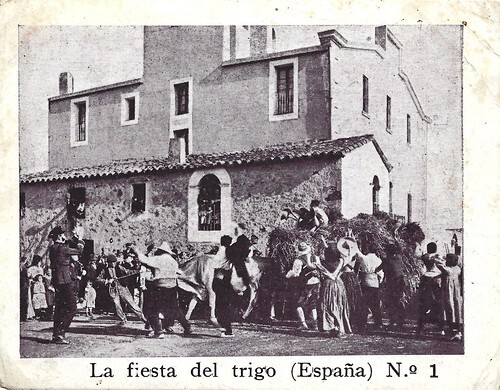
Spanish collector card by Reclam Films, Mallorca, no. 1 of 6. Scene from La festa del blat/La fiesta del trigo/The Wheat Festival (Josep de Togores i Muntades, Joan Solà i Mestres, 1914) Photo: Cóndor Films, Barcelona.
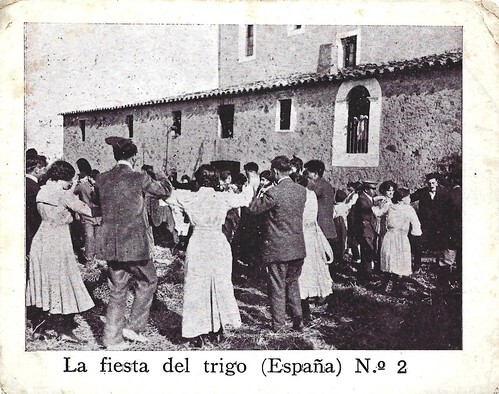
Spanish collector card by Reclam Films, Mallorca, no. 2 of 6. Scene from La festa del blat/La fiesta del trigo/The Wheat Festival (Josep de Togores i Muntades, Joan Solà i Mestres, 1914) Photo: Cóndor Films, Barcelona.
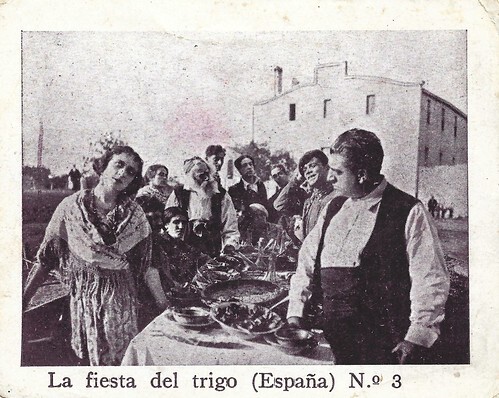
Spanish collector card by Reclam Films, Mallorca, no. 3 of 6. Scene from La festa del blat/La fiesta del trigo/The Wheat Festival (Josep de Togores i Muntades, Joan Solà i Mestres, 1914) Photo: Cóndor Films, Barcelona.
Film pioneer Josep de Togores
Film director Josep de Togores i Muntades (1868-1926) or José de Togores is now best remembered as a Spanish football executive. He was the second president of the Catalan Football Federation (1904–1905) and co-founder of the sports magazine Mundo Deportivo (1906). Togores was a man of wide culture, and as such, in addition to sports, he was also interested in music and was a friend and host to Camille Saint-Saëns and Spanish composer Enric Granados, with whom he organised concerts at his home. He also collected art and painted as a hobby.
His income began to dwindle in the early 1910s, and he went bankrupt after several unsuccessful businesses. Togores saw in the world of cinema and filmmaking, a path that fitted his personality. His first film was La festa del blat/La fiesta del trigo/The Wheat Festival (Josep de Togores i Muntades, Joan Solà i Mestres, 1914), based on a play by Àngel Guimerà and produced by Condor Films.
La festa del blat/La fiesta del trigo/The Wheat Festival (Josep de Togores i Muntades, Joan Solà i Mestres, 1914) tells the tale of Jaume, a young worker, who flees to the mountains to avoid being arrested. On the day of the Wheat Festival, the betrothed Oriola, a rich heiress, and Vicentó pick up an exhausted Jaume in the middle of the road. He goes to work at the girl's uncle's farmhouse. Vicentó, jealous of the love between Jaume and his fiancee, denounces him. Jaume tries to prevent the workers from attacking Vicentó. He is mortally wounded and dies in Oriola's arms. The premiere of La festa del blat was attended by author Àngel Guimerà himself, who praised Togores's work.
Togores's film debut was followed by Dansa fatal/Fatal Dance (Josep de Togores, 1914), El pollo Tejada/Chicken Tejada (Josep de Togores, 1915), with a plot inspired by the homonymous zarzuela by Carlos Arniches. With the rising production costs of his films, he began to work with Segre Films. Under this production company, Togores directed eight films. In the film El cuervo del campamento/The Camp Crow (Fructuós Gelabert, Josep de Togores, 1915) he shared the direction with Fructuós Gelabert. Amor de pescadora/Fisherwoman's Love (Josep de Togores, 1915) features the performance of renowned artists, but it was Un sólo corazó/A Single Heart (1915), that made the biggest impression and was consecrated as the best Spanish film till then. In articles, Togores expressed the great opportunity that Spanish cinema had during the First World War while there was a lack of foreign films. The last major production of Togores for Segre was El sello de oro/The Golden Seal (Josep de Togores, 1916), starring Stacia Napierkowska .
He continued with Flor del arroyo, Secrets del mar/Flower of the Stream, Secrets of the Sea (Josep de Togores, 1916), and in the following years, he made the serial Prova tràgica/Tragic Test (Josep de Togores, 1916?), Un drama a la muntanya/A mountain drama (Josep de Togores, 1916?), La pescadora de Tossa/The fisherwoman of Tossa (Josep de Togores, 1916?), El cavaller Casaroja/The Cavalier Casaroja (Josep de Togores, 1916?), El regal de bodes/The Wedding Gift (Josep de Togores, 1916?), and El golfo (Josep de Togores, 1917-1919) with Ernesto Vilches, which was filmed in Bilbao and San Sebastián, for the Madrid production company Dessy Films. His films were considered of high quality, with good technical collaborators, ambitious and extensive themes, lavish presentation, and featuring great actors and actresses such as Fernando Díaz de Mendoza, María Guerrero, Lola París, and Pastora Imperio. His style was classified as drama a la Italiana, and this conception increased with the addition of Giovanni Doria to his work team.
Josep de Togores Muntades tried to capture his audience with a theatrical style even when it approached realism. Although his films were dynamic, the public found them too theatrical, and their themes were artificial and not very cinematic. After directing sixteen films, the film world had brought him more difficulties than financial benefits to his family. Togores' economic situation was precarious, so he decided to meet his son, artist Josep Togores i Llach in Paris. There he focused on promoting the career of his son and he became an important art collector. He devoted the last years of his life to promoting the work of his son. There are very few studies of the work of Josep de Togores Muntades. Two of his films, El pollo de Tejada (1915) and El Golfo (1917-1919), have been restored.
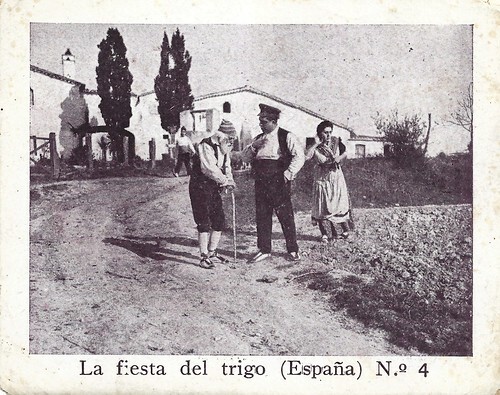
Spanish collector card by Reclam Films, Mallorca, no. 4 of 6. Scene from La festa del blat/La fiesta del trigo/The Wheat Festival (Josep de Togores i Muntades, Joan Solà i Mestres, 1914) Photo: Cóndor Films, Barcelona.
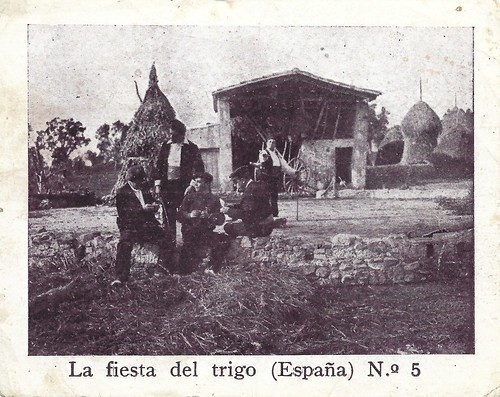
Spanish collector card by Reclam Films, Mallorca, no. 5 of 6. Scene from La festa del blat/La fiesta del trigo/The Wheat Festival (Josep de Togores i Muntades, Joan Solà i Mestres, 1914) Photo: Cóndor Films, Barcelona.
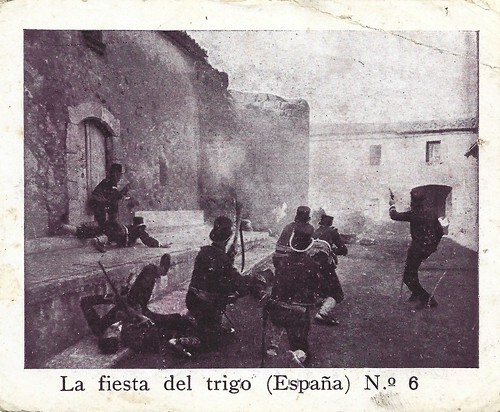
Spanish collector card by Reclam Films, Mallorca, no. 6 of 6. Scene from La festa del blat/La fiesta del trigo/The Wheat Festival (Josep de Togores i Muntades, Joan Solà i Mestres, 1914) Photo: Cóndor Films, Barcelona.
Sources: Cervantes Virtual (Spanish), Real Academia de la Historia (Spanish), Wikipedia and IMDb.

Spanish collector card by Reclam Films, Mallorca, no. 1 of 6. Scene from La festa del blat/La fiesta del trigo/The Wheat Festival (Josep de Togores i Muntades, Joan Solà i Mestres, 1914) Photo: Cóndor Films, Barcelona.

Spanish collector card by Reclam Films, Mallorca, no. 2 of 6. Scene from La festa del blat/La fiesta del trigo/The Wheat Festival (Josep de Togores i Muntades, Joan Solà i Mestres, 1914) Photo: Cóndor Films, Barcelona.

Spanish collector card by Reclam Films, Mallorca, no. 3 of 6. Scene from La festa del blat/La fiesta del trigo/The Wheat Festival (Josep de Togores i Muntades, Joan Solà i Mestres, 1914) Photo: Cóndor Films, Barcelona.
Film pioneer Josep de Togores
Film director Josep de Togores i Muntades (1868-1926) or José de Togores is now best remembered as a Spanish football executive. He was the second president of the Catalan Football Federation (1904–1905) and co-founder of the sports magazine Mundo Deportivo (1906). Togores was a man of wide culture, and as such, in addition to sports, he was also interested in music and was a friend and host to Camille Saint-Saëns and Spanish composer Enric Granados, with whom he organised concerts at his home. He also collected art and painted as a hobby.
His income began to dwindle in the early 1910s, and he went bankrupt after several unsuccessful businesses. Togores saw in the world of cinema and filmmaking, a path that fitted his personality. His first film was La festa del blat/La fiesta del trigo/The Wheat Festival (Josep de Togores i Muntades, Joan Solà i Mestres, 1914), based on a play by Àngel Guimerà and produced by Condor Films.
La festa del blat/La fiesta del trigo/The Wheat Festival (Josep de Togores i Muntades, Joan Solà i Mestres, 1914) tells the tale of Jaume, a young worker, who flees to the mountains to avoid being arrested. On the day of the Wheat Festival, the betrothed Oriola, a rich heiress, and Vicentó pick up an exhausted Jaume in the middle of the road. He goes to work at the girl's uncle's farmhouse. Vicentó, jealous of the love between Jaume and his fiancee, denounces him. Jaume tries to prevent the workers from attacking Vicentó. He is mortally wounded and dies in Oriola's arms. The premiere of La festa del blat was attended by author Àngel Guimerà himself, who praised Togores's work.
Togores's film debut was followed by Dansa fatal/Fatal Dance (Josep de Togores, 1914), El pollo Tejada/Chicken Tejada (Josep de Togores, 1915), with a plot inspired by the homonymous zarzuela by Carlos Arniches. With the rising production costs of his films, he began to work with Segre Films. Under this production company, Togores directed eight films. In the film El cuervo del campamento/The Camp Crow (Fructuós Gelabert, Josep de Togores, 1915) he shared the direction with Fructuós Gelabert. Amor de pescadora/Fisherwoman's Love (Josep de Togores, 1915) features the performance of renowned artists, but it was Un sólo corazó/A Single Heart (1915), that made the biggest impression and was consecrated as the best Spanish film till then. In articles, Togores expressed the great opportunity that Spanish cinema had during the First World War while there was a lack of foreign films. The last major production of Togores for Segre was El sello de oro/The Golden Seal (Josep de Togores, 1916), starring Stacia Napierkowska .
He continued with Flor del arroyo, Secrets del mar/Flower of the Stream, Secrets of the Sea (Josep de Togores, 1916), and in the following years, he made the serial Prova tràgica/Tragic Test (Josep de Togores, 1916?), Un drama a la muntanya/A mountain drama (Josep de Togores, 1916?), La pescadora de Tossa/The fisherwoman of Tossa (Josep de Togores, 1916?), El cavaller Casaroja/The Cavalier Casaroja (Josep de Togores, 1916?), El regal de bodes/The Wedding Gift (Josep de Togores, 1916?), and El golfo (Josep de Togores, 1917-1919) with Ernesto Vilches, which was filmed in Bilbao and San Sebastián, for the Madrid production company Dessy Films. His films were considered of high quality, with good technical collaborators, ambitious and extensive themes, lavish presentation, and featuring great actors and actresses such as Fernando Díaz de Mendoza, María Guerrero, Lola París, and Pastora Imperio. His style was classified as drama a la Italiana, and this conception increased with the addition of Giovanni Doria to his work team.
Josep de Togores Muntades tried to capture his audience with a theatrical style even when it approached realism. Although his films were dynamic, the public found them too theatrical, and their themes were artificial and not very cinematic. After directing sixteen films, the film world had brought him more difficulties than financial benefits to his family. Togores' economic situation was precarious, so he decided to meet his son, artist Josep Togores i Llach in Paris. There he focused on promoting the career of his son and he became an important art collector. He devoted the last years of his life to promoting the work of his son. There are very few studies of the work of Josep de Togores Muntades. Two of his films, El pollo de Tejada (1915) and El Golfo (1917-1919), have been restored.

Spanish collector card by Reclam Films, Mallorca, no. 4 of 6. Scene from La festa del blat/La fiesta del trigo/The Wheat Festival (Josep de Togores i Muntades, Joan Solà i Mestres, 1914) Photo: Cóndor Films, Barcelona.

Spanish collector card by Reclam Films, Mallorca, no. 5 of 6. Scene from La festa del blat/La fiesta del trigo/The Wheat Festival (Josep de Togores i Muntades, Joan Solà i Mestres, 1914) Photo: Cóndor Films, Barcelona.

Spanish collector card by Reclam Films, Mallorca, no. 6 of 6. Scene from La festa del blat/La fiesta del trigo/The Wheat Festival (Josep de Togores i Muntades, Joan Solà i Mestres, 1914) Photo: Cóndor Films, Barcelona.
Sources: Cervantes Virtual (Spanish), Real Academia de la Historia (Spanish), Wikipedia and IMDb.
Published on August 12, 2024 22:00
August 11, 2024
Van Johnson
American actor Van Johnson (1916-2008) was a red-haired, freckle-faced and invariably friendly-looking song-and-dance star in MGM films. In the mid-1940s he emerged as a box office favourite and was second only to heartthrob Frank Sinatra during the 'Bobby-soxer' era. Playing earnest soldiers and boy-next-doors made him a solid box-office attraction while MGM's major stars were off to war.
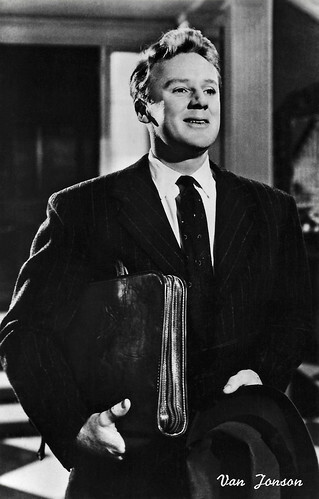
Italian postcard by Bromofoto, Milano, no. 220.
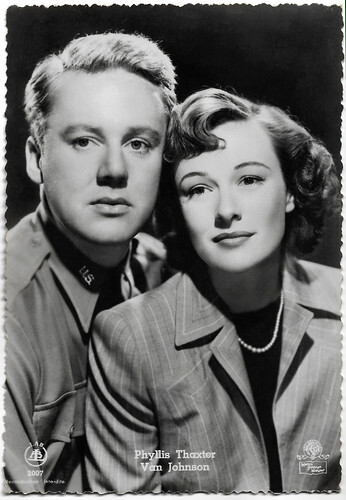
Belgian postcard by Les Editions d'Art L.A.B., Bruxelles, no. 2007. Photo: Metro-Goldwyn-Mayer. Van Johnson and Phyllis Thaxter in Thirty Seconds Over Tokyo (Mervyn LeRoy, 1944).
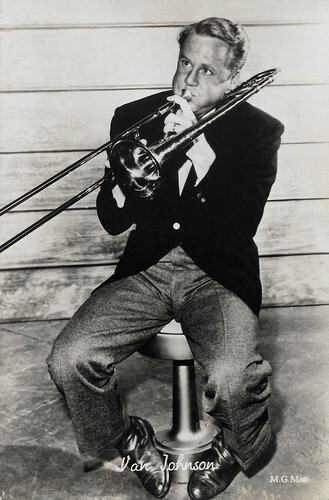
Dutch postcard. Photo: M.G.M. Sent by mail in 1953.
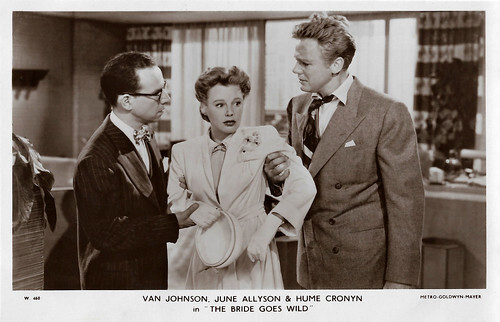
British postcard in the Picturegoer Series, London, no. W 460. Photo: Metro-Goldwyn-Mayer. Hume Cronyn, June Allyson and Van Johnson in The Bride Goes Wild (Norman Taurog, 1948).
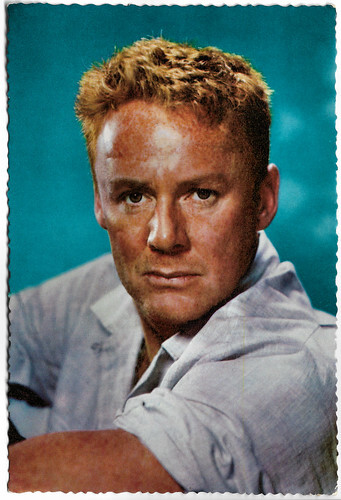
Spanish postcard by Soberanas (Sobe), no. 12012. Photo: 20th Century Fox. Van Johnson in The Bottom of the Bottle (Henry Hathaway, 1956).
The Voiceless Sinatra
Van Johnson was born Charles Van Dell Johnson in Newport, Rhode Island in 1916. His father, Charles E. Johnson was a plumber from Sweden and later a real estate salesman. His mother, Loretta Neumann (or Snyder), was a homemaker and had been a dietitian at Metro-Goldwyn-Mayer. She was an alcoholic who abandoned him when he was three.
Johnson endured a lonely and unhappy childhood. Gary Brumburgh at IMDb : "Happier times were spent drifting into the fantasy world of movies, and he developed an ardent passion to entertain. Taking singing, dancing and violin lessons during his high school years, he disregarded his father's wish to become a lawyer and instead left home following graduation to try his luck in New York."
Van made his Broadway debut in 1936 in 'New Faces of 1936', an annual revue that had also introduced Henry Fonda in 1934. Van would appear in a total of seven Broadway shows, including the original cast production of 'Pal Joey' in 1940-1941 In 1942, Van Johnson got a contract with MGM and went to Hollywood. The tall, red-haired actor took advantage of the fact that all established stars were in military service. Johnson was exempt from army service after being injured in a car accident driving with his close friend Keenan Wynn to a screening of Keeper of the Flame (George Cukor, 1942). He had a metal plate placed in his forehead.
One of his first roles was as a replacement for Lew Ayres in the hospital film series Dr Kildare alongside Lionel Barrymore . Johnson's breakthrough came with the war film A Guy Named Joe (Victor Fleming, 1943) alongside Spencer Tracy and Irene Dunne . Within two years, he rose from small supporting roles in which he often played the "nice young man next door" to one of the ten highest-grossing stars in the film industry.
Van Johnson was known for his red socks and his bobbysoxer popularity was such that he was nicknamed "The Voiceless Sinatra". The studio often placed him alongside June Allyson or Esther Williams in big-screen musicals and romantic films. He first received top billing with the musical Two Girls and a Sailor (Richard Thorpe, 1944) opposite June Allyson and Gloria DeHaven .
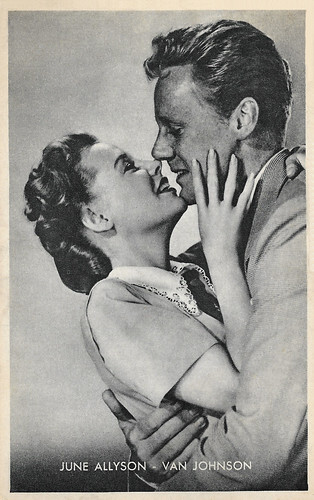
Belgian collector card by Kwatta, no. C. 163 (Series C. 99 - 196). Photo: M.G.M. June Allyson and Van Johnson in The Bride Goes Wild (Norman Taurog, 1948).
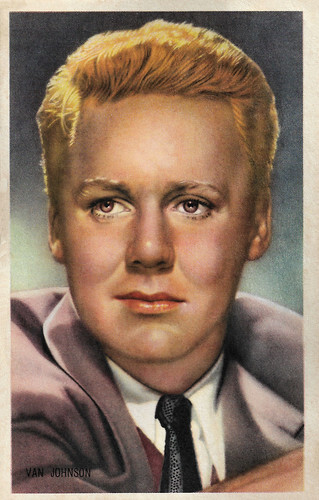
Belgian collector card by Kwatta, Bois-d'Haine, no. C. 222 (Serie C. 197 - C. 228). Photo: M.G.M.
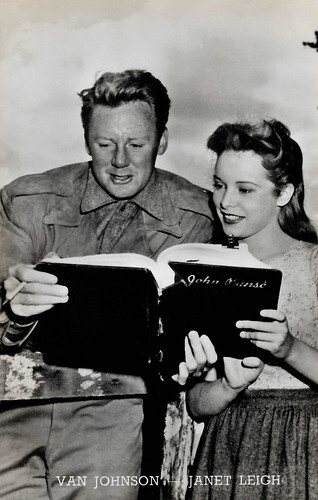
Belgian postcard, no. 61. Photo: M.G.M. Van Johnson and Janet Leigh on the set of The Romance of Rosy Ridge (Roy Rowland, 1947).
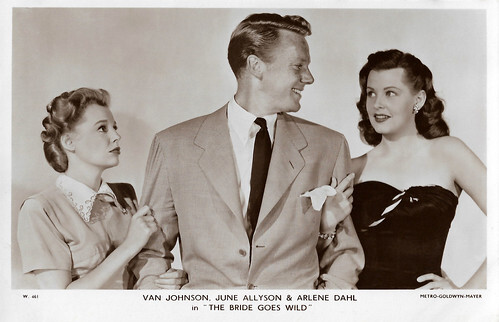
British postcard in the Picturegoer Series, London, no. W 462. Photo: Metro-Goldwyn-Mayer. Van Johnson, June Allyson (left), and Arlene Dahl in The Bride Goes Wild (Norman Taurog, 1948).
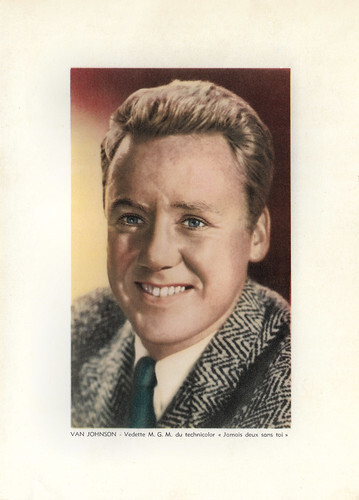
Big Belgian collector card by Kwatta, Bois d'Haine. Photo: M.G.M. Publicity still for Duchess of Idaho (Robert Z. Leonard, 1950).
Arranged marriage
After the end of World War II, the big stars such as Clark Gable , James Stewart and Robert Taylor returned to reclaim their post-war stardom. Van Johnson willingly relinquished his 'golden boy' pedestal, but he remained a high-profile musical star. He was the partner of Judy Garland in the musical In the Good Old Summertime (Robert Z. Leonard, Buster Keaton, 1949) and was also seen in the musical Brigadoon (Vincente Minnelli, 1954) alongside Gene Kelly .
He also turned to dramatic films and played such well-known roles as Holley in Battleground (William A. Wellman, 1949), Charles Wills in The Last Time I Saw Paris (Richard Brooks, 1954) starring Elizabeth Taylor , and Lieutenant Steve Maryk in The Caine Mutiny (Edward Dmytryk, 1954) with Humphrey Bogart and José Ferrer .
In November 1954, his mother suddenly resurfaced and sued him for nine hundred dollars in monthly support. He fought back, saying she did not help raise him so, although he was willing to give her money, she was not entitled to court-ordered support. It was eventually settled out of court and he agreed to pay her four hundred dollars a month. Johnson played his last leading roles in Hollywood in the 1960s and appeared in several Italian films from the end of the decade.
Johnson made guest appearances in TV series such as Batman (as the minstrel in 2 episodes in 1966), Here's Lucy and The Love Boat and the Miniseries Rich Man, Poor Man (1976), for which he was nominated for an Emmy. He had success in the theatre with the musical 'The Music Man'. In 1985, he made a minor comeback. He starred in the Broadway musical 'La Cage Aux Folles' and had a supporting role in Woody Allen 's comedy The Purple Rose of Cairo (1985). His last musical role was as Cap' Andy in 'Show Boat' in 1991. A year later, he played his last cinema role alongside Fred Williamson in the thriller Three Days to a Kill (Fred Williamson, 1992).
Johnson was married to Eve Lynn Abbott in 1947, on the day of her divorce from actor Keenan Wynn. The couple produced one daughter, Schuyler V. Johnson (1948) and divorced in 1961. According to Eve in 1999, MGM boss Louis B. Mayer had arranged the marriage to conceal Johnson's homosexuality from the public. He later left her for her male tennis instructor according to her son, Ned Wynn. Van Johnson underwent skin cancer treatment in 1963. He died in 2008 at a senior living facility in Nyack, New York, at 92. He had been one of the last surviving matinee idols of Hollywood's 'golden age'.
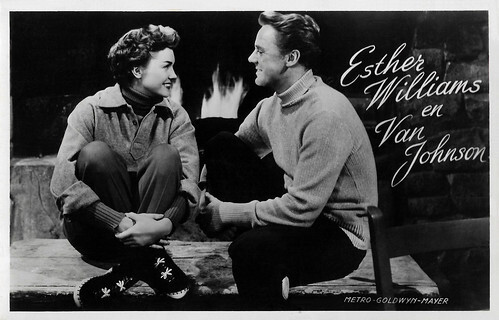
Dutch postcard. Photo: Metro-Goldwyn-Mayer (MGM). Esther Williams and Van Johnson in Thrill of a Romance (Richard Thorpe, 1945).
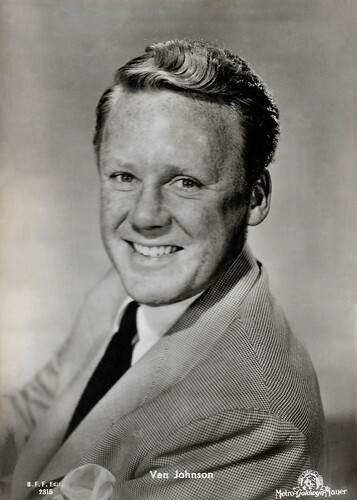
Italian postcard by B.F.F. Edit., no. 2315. Photo: Metro Goldwyn Mayer. Publicity still for The Bride Goes Wild (Norman Taurog, 1948).
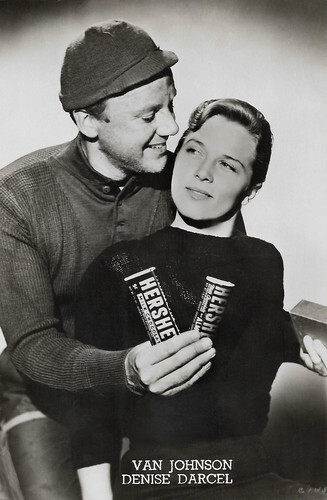
Vintage postcard, no. 457. Van Johnson and Denise Darcel in Battleground (William A. Wellman, 1949).
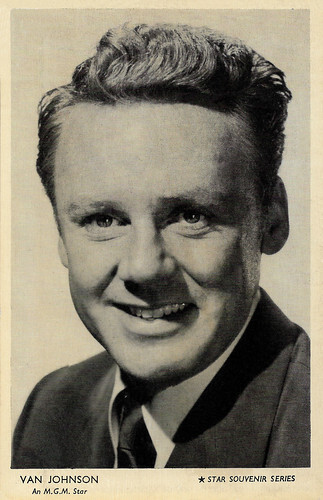
British postcard in the Star Souvenir Series, edited by Peter Noble, no. 15, published by Jarrold & Sons LTD. Norwich, England. Photo: M.G.M. (M.G.M. 25th anniversary souvenir). Caption: The Idol of the bobby-soxers, red-haired, freckle-faced Van has starred for M.G.M. in a score of films, including High Barbaree, The World and his Wife, Command Decision, The Good Ols Summer Time and Scene of the Crime.
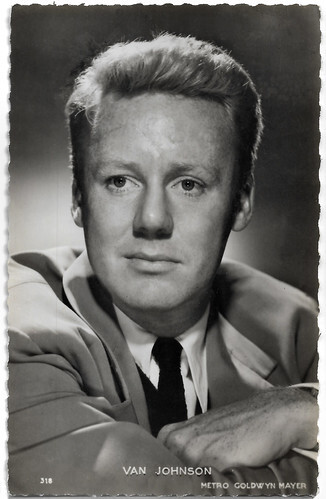
French postcard by Editions P.I., presented by Les Carbones Korès "Carboplane", no. 318. Photo: Metro Goldwyn Mayer, 1954.
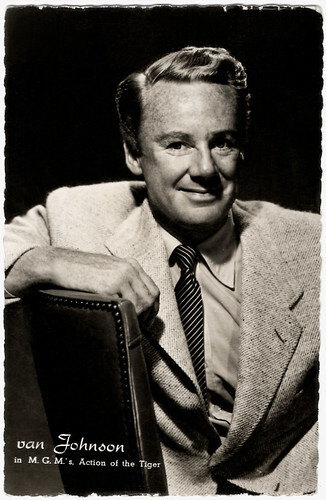
Dutch postcard, no. 11. Photo: M.G.M. Van Johnson in Action of the Tiger (Terence Young, 1957).
Sources: (IMDb), Wikipedia (Dutch, German and English) and .

Italian postcard by Bromofoto, Milano, no. 220.

Belgian postcard by Les Editions d'Art L.A.B., Bruxelles, no. 2007. Photo: Metro-Goldwyn-Mayer. Van Johnson and Phyllis Thaxter in Thirty Seconds Over Tokyo (Mervyn LeRoy, 1944).

Dutch postcard. Photo: M.G.M. Sent by mail in 1953.

British postcard in the Picturegoer Series, London, no. W 460. Photo: Metro-Goldwyn-Mayer. Hume Cronyn, June Allyson and Van Johnson in The Bride Goes Wild (Norman Taurog, 1948).

Spanish postcard by Soberanas (Sobe), no. 12012. Photo: 20th Century Fox. Van Johnson in The Bottom of the Bottle (Henry Hathaway, 1956).
The Voiceless Sinatra
Van Johnson was born Charles Van Dell Johnson in Newport, Rhode Island in 1916. His father, Charles E. Johnson was a plumber from Sweden and later a real estate salesman. His mother, Loretta Neumann (or Snyder), was a homemaker and had been a dietitian at Metro-Goldwyn-Mayer. She was an alcoholic who abandoned him when he was three.
Johnson endured a lonely and unhappy childhood. Gary Brumburgh at IMDb : "Happier times were spent drifting into the fantasy world of movies, and he developed an ardent passion to entertain. Taking singing, dancing and violin lessons during his high school years, he disregarded his father's wish to become a lawyer and instead left home following graduation to try his luck in New York."
Van made his Broadway debut in 1936 in 'New Faces of 1936', an annual revue that had also introduced Henry Fonda in 1934. Van would appear in a total of seven Broadway shows, including the original cast production of 'Pal Joey' in 1940-1941 In 1942, Van Johnson got a contract with MGM and went to Hollywood. The tall, red-haired actor took advantage of the fact that all established stars were in military service. Johnson was exempt from army service after being injured in a car accident driving with his close friend Keenan Wynn to a screening of Keeper of the Flame (George Cukor, 1942). He had a metal plate placed in his forehead.
One of his first roles was as a replacement for Lew Ayres in the hospital film series Dr Kildare alongside Lionel Barrymore . Johnson's breakthrough came with the war film A Guy Named Joe (Victor Fleming, 1943) alongside Spencer Tracy and Irene Dunne . Within two years, he rose from small supporting roles in which he often played the "nice young man next door" to one of the ten highest-grossing stars in the film industry.
Van Johnson was known for his red socks and his bobbysoxer popularity was such that he was nicknamed "The Voiceless Sinatra". The studio often placed him alongside June Allyson or Esther Williams in big-screen musicals and romantic films. He first received top billing with the musical Two Girls and a Sailor (Richard Thorpe, 1944) opposite June Allyson and Gloria DeHaven .

Belgian collector card by Kwatta, no. C. 163 (Series C. 99 - 196). Photo: M.G.M. June Allyson and Van Johnson in The Bride Goes Wild (Norman Taurog, 1948).

Belgian collector card by Kwatta, Bois-d'Haine, no. C. 222 (Serie C. 197 - C. 228). Photo: M.G.M.

Belgian postcard, no. 61. Photo: M.G.M. Van Johnson and Janet Leigh on the set of The Romance of Rosy Ridge (Roy Rowland, 1947).

British postcard in the Picturegoer Series, London, no. W 462. Photo: Metro-Goldwyn-Mayer. Van Johnson, June Allyson (left), and Arlene Dahl in The Bride Goes Wild (Norman Taurog, 1948).

Big Belgian collector card by Kwatta, Bois d'Haine. Photo: M.G.M. Publicity still for Duchess of Idaho (Robert Z. Leonard, 1950).
Arranged marriage
After the end of World War II, the big stars such as Clark Gable , James Stewart and Robert Taylor returned to reclaim their post-war stardom. Van Johnson willingly relinquished his 'golden boy' pedestal, but he remained a high-profile musical star. He was the partner of Judy Garland in the musical In the Good Old Summertime (Robert Z. Leonard, Buster Keaton, 1949) and was also seen in the musical Brigadoon (Vincente Minnelli, 1954) alongside Gene Kelly .
He also turned to dramatic films and played such well-known roles as Holley in Battleground (William A. Wellman, 1949), Charles Wills in The Last Time I Saw Paris (Richard Brooks, 1954) starring Elizabeth Taylor , and Lieutenant Steve Maryk in The Caine Mutiny (Edward Dmytryk, 1954) with Humphrey Bogart and José Ferrer .
In November 1954, his mother suddenly resurfaced and sued him for nine hundred dollars in monthly support. He fought back, saying she did not help raise him so, although he was willing to give her money, she was not entitled to court-ordered support. It was eventually settled out of court and he agreed to pay her four hundred dollars a month. Johnson played his last leading roles in Hollywood in the 1960s and appeared in several Italian films from the end of the decade.
Johnson made guest appearances in TV series such as Batman (as the minstrel in 2 episodes in 1966), Here's Lucy and The Love Boat and the Miniseries Rich Man, Poor Man (1976), for which he was nominated for an Emmy. He had success in the theatre with the musical 'The Music Man'. In 1985, he made a minor comeback. He starred in the Broadway musical 'La Cage Aux Folles' and had a supporting role in Woody Allen 's comedy The Purple Rose of Cairo (1985). His last musical role was as Cap' Andy in 'Show Boat' in 1991. A year later, he played his last cinema role alongside Fred Williamson in the thriller Three Days to a Kill (Fred Williamson, 1992).
Johnson was married to Eve Lynn Abbott in 1947, on the day of her divorce from actor Keenan Wynn. The couple produced one daughter, Schuyler V. Johnson (1948) and divorced in 1961. According to Eve in 1999, MGM boss Louis B. Mayer had arranged the marriage to conceal Johnson's homosexuality from the public. He later left her for her male tennis instructor according to her son, Ned Wynn. Van Johnson underwent skin cancer treatment in 1963. He died in 2008 at a senior living facility in Nyack, New York, at 92. He had been one of the last surviving matinee idols of Hollywood's 'golden age'.

Dutch postcard. Photo: Metro-Goldwyn-Mayer (MGM). Esther Williams and Van Johnson in Thrill of a Romance (Richard Thorpe, 1945).

Italian postcard by B.F.F. Edit., no. 2315. Photo: Metro Goldwyn Mayer. Publicity still for The Bride Goes Wild (Norman Taurog, 1948).

Vintage postcard, no. 457. Van Johnson and Denise Darcel in Battleground (William A. Wellman, 1949).

British postcard in the Star Souvenir Series, edited by Peter Noble, no. 15, published by Jarrold & Sons LTD. Norwich, England. Photo: M.G.M. (M.G.M. 25th anniversary souvenir). Caption: The Idol of the bobby-soxers, red-haired, freckle-faced Van has starred for M.G.M. in a score of films, including High Barbaree, The World and his Wife, Command Decision, The Good Ols Summer Time and Scene of the Crime.

French postcard by Editions P.I., presented by Les Carbones Korès "Carboplane", no. 318. Photo: Metro Goldwyn Mayer, 1954.

Dutch postcard, no. 11. Photo: M.G.M. Van Johnson in Action of the Tiger (Terence Young, 1957).
Sources: (IMDb), Wikipedia (Dutch, German and English) and .
Published on August 11, 2024 22:00
August 10, 2024
Audrey Hepburn
Elegant, talented and funny Audrey Hepburn (1929-1993) was a Belgian-born, British-Dutch actress and humanitarian. After a start in European cinema, she became one of the most successful Hollywood stars of the 1950s and 1960s.
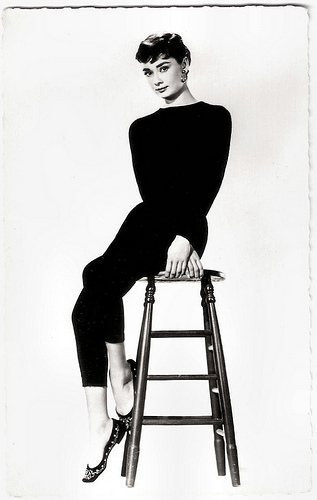
French postcard by Editions du Globe, Paris, no. 385. Photo: Paramount / P.P.C. Publicity still for Sabrina (Billy Wilder, 1954). Costume: Hubert de Givenchy.
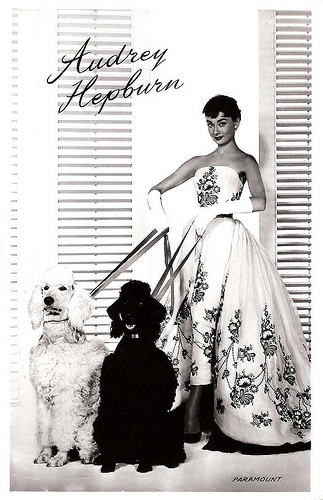
Dutch postcard by Takken, Utrecht, no. 1530. Photo: Paramount. Publicity still for Sabrina (Billy Wilder, 1954). Costume: Hubert de Givenchy.
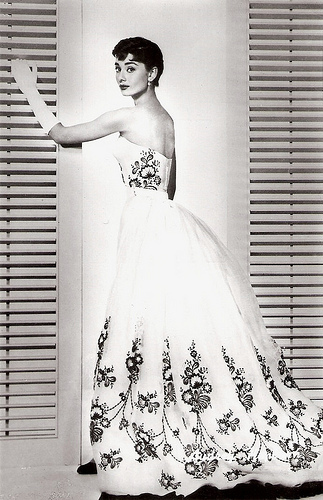
French postcard. Publicity still for Sabrina (Billy Wilder, 1954). Costume: Hubert de Givenchy.
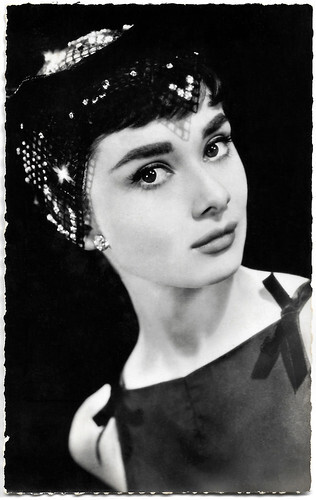
French postcard by Editions du Globe, Paris, no. 384. Photo: Paramount / PPC, 1955. Audrey Hepburn in Sabrina (Billy Wilder, 1954). Costume: Hubert de Givenchy.
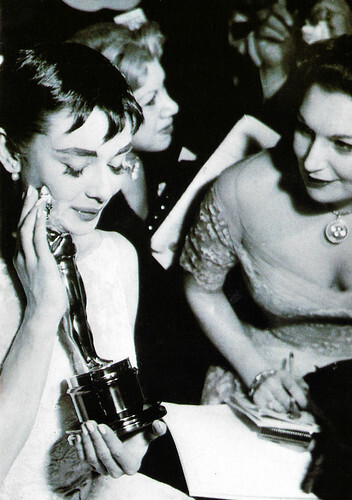
German postcard by Tushita, Duisburg / Innenhalen, no. B 489. Photo: Transglobe /Popperfoto. Audrey Hepburn was five times nominated for an Academy Award, and was awarded in 1954 the Academy Award for Best Actress for her performance in Roman Holiday (William Wyler, 1953).
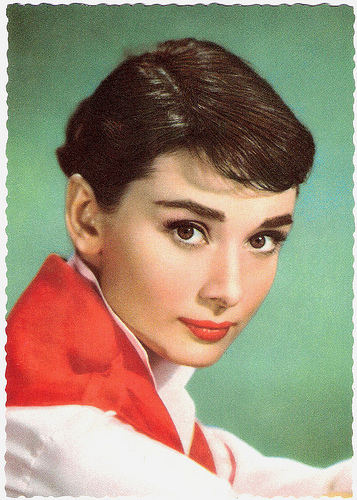
German postcard by Ufa, Berlin-Tempelhof, no. CK-5. Retail price: 30 Pfg. Photo: Paramount Film.
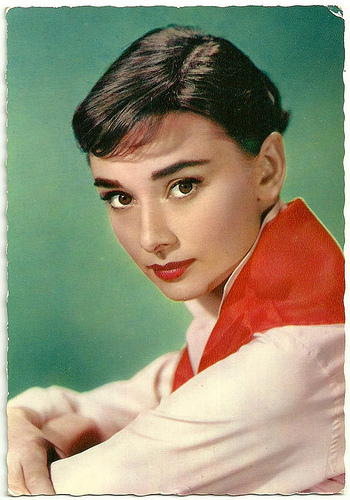
French postcard. Unknown editor and photographer.
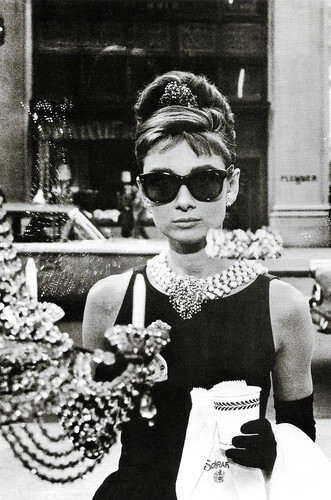
Italian postcard by Emilio Modric Editore, Ancona, no. MX 243. Photo: Audrey Hepburn in Breakfast at Tiffany's (Blake Edwards, 1961).
Wartime in Arnhem
Audrey Hepburn was born Audrey Kathleen Ruston in Ixelles/Elsene, a municipality in Brussels, Belgium, in 1929. She was the only child of Joseph Victor Anthony Ruston, a Briton, and his second wife, the former Baroness Ella van Heemstra, a Dutch aristocrat, who was the daughter of a former governor of Dutch Guiana.
Her father later used the surname of his maternal grandmother, Kathleen Hepburn, to the family and her surname became Hepburn-Ruston. Hepburn's father's job with a British insurance company meant the family travelled often between Brussels, England, and The Netherlands. In 1935, her parents divorced and her father, a Nazi sympathiser, left the family.
In 1939, her mother moved her and her two half-brothers to their grandfather's home in Arnhem in the Netherlands, believing the Netherlands would be safe from a German attack. Hepburn attended the Arnhem Conservatory from 1939 to 1945, where she trained in ballet along with the standard school curriculum. In 1940, the Germans invaded the Netherlands. During the German occupation, Hepburn adopted the pseudonym Edda van Heemstra, modifying her mother's documents because an 'English-sounding' name was considered dangerous.
By 1944, Audrey had become a proficient ballerina. She secretly danced for groups of people to collect money for the Dutch resistance. During the Dutch famine that followed, over the winter of 1944, people starved and froze to death in the streets. Hepburn and many others resorted to making flour out of tulip bulbs to bake cakes and biscuits. Hepburn's wartime experiences later led her to become involved with UNICEF.
In 1945, after the war, Hepburn left the Arnhem Conservatory and moved to Amsterdam, where she took ballet lessons with Lithuanian-Dutch-Jewish dancer and choreographer Sonia Gaskell. Hepburn made her first film appearance in Nederlands in 7 lessen/Dutch in Seven Lessons (Charles Huguenot van der Linden, Heinz Josephson, 1948), a Dutch film made for KLM Royal Dutch Airlines. It had a film-within-the-film scenario involving a cameraman who's given a week to photograph the aerial highlights of Holland for a travelogue. Hepburn played the stewardess.
She then travelled with her mother to London. Gaskell provided an introduction to Marie Rambert, and Hepburn studied ballet at the Ballet Rambert, supporting herself with part-time work as a model. Rambert warned her that she could not become a prima ballerina, because she was relatively tall (1.7m). Audrey decided to pursue an acting career instead.
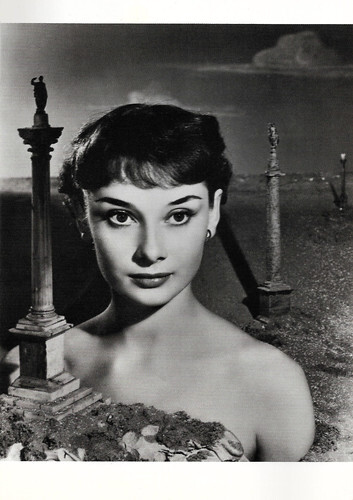
British postcard by Acme Cards, London, no. AM 1. Photo: Angus McBean, 1951.
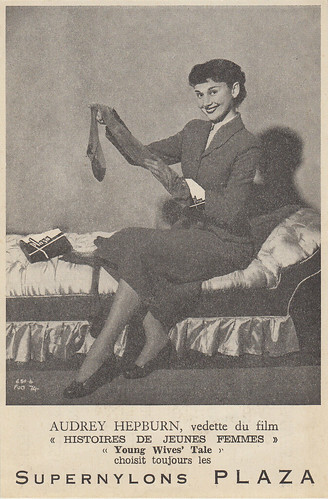
French promotion card for Supernylons Plaza. The card refers to the British film Young Wives' Tale (Henry Cass, 1951) with 22-year-old Audrey Hepburn in her fourth film, two years before Roman Holiday (William Wyler, 1953). Collection: Marlene Pilaete.
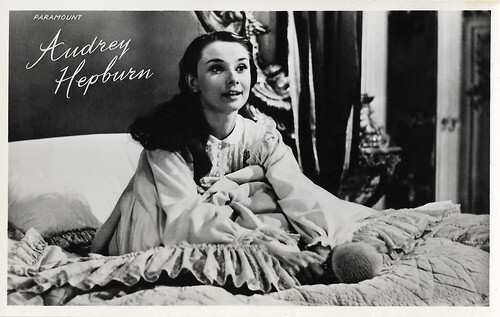
Dutch postcard by Takken / 't Sticht, Utrecht, no. 1469. Photo: Paramount. Audrey Hepburn in Roman Holiday (William Wyler, 1953).
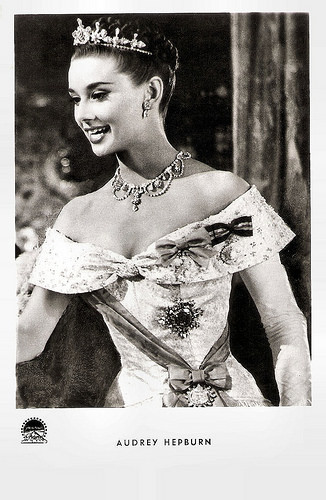
German postcard by Kunst und Bild, Berlin, no. A 1031. Photo: Paramount. Publicity still for Roman Holiday (William Wyler, 1953).
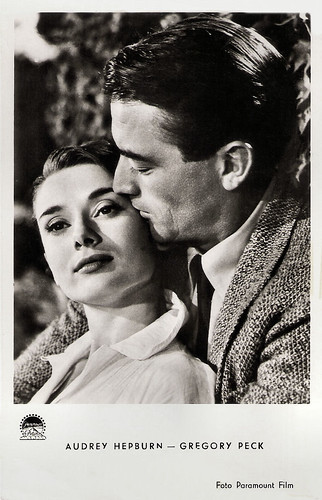
German postcard by Kunst und Bild, Berlin, no. A 1079. Photo: Paramount. Audrey Hepburn and Gregory Peck in Roman Holiday (William Wyler, 1953).
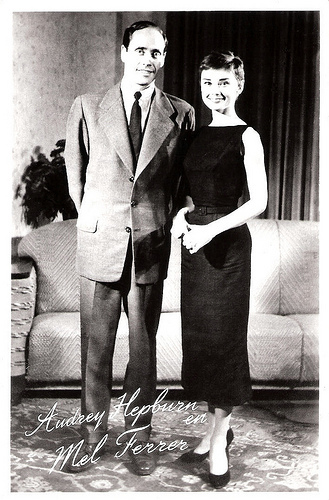
Dutch postcard by Takken, Utrecht, no. 1598. With Mel Ferrer .
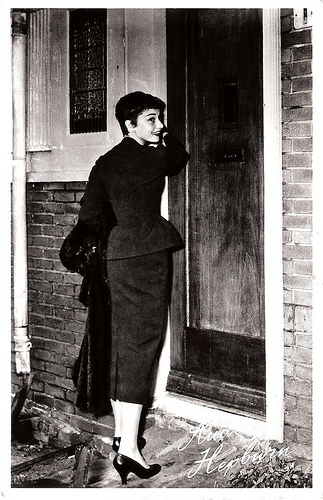
Dutch postcard by Takken, Utrecht, no. 1599. Audrey Hepburn visited Arnhem after the war.
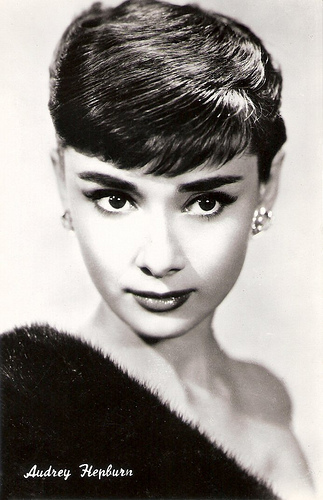
Italian postcard by Bromofoto, Milano (Milan).
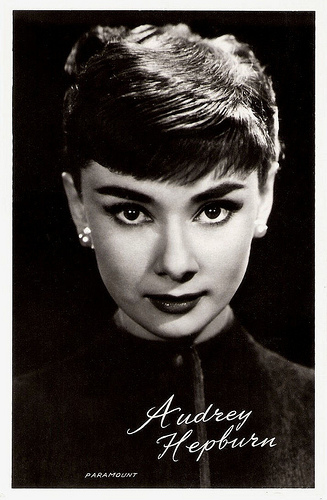
Dutch postcard by Takken, Utrecht, no. 1422. Photo: Paramount.
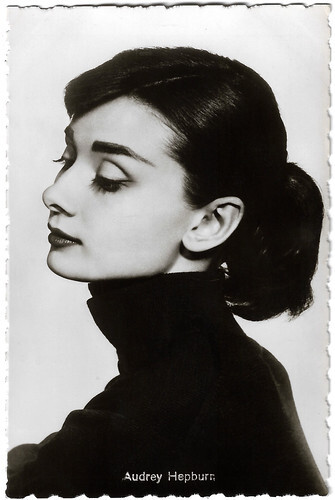
West German postcard by Kolibri Verlag, Minden/Westf., no. 2884.
Meeting Colette
In London, Audrey Hepburn played in musical theatre in productions such as 'High Button Shoes' and 'Sauce Piquante'. Her theatre work revealed that her voice was not strong and needed to be developed, and during this time she took elocution lessons with the actor Felix Aylmer.
Part-time modelling work was not always available and Hepburn registered with the casting officers of Britain's film studios in the hope of getting work as an extra. Hepburn's first British film role was in the farce One Wild Oat (Charles Saunders, 1951) in which she played a hotel receptionist. She played several more small roles in Young Wives' Tale (Henry Cass, 1951), Laughter in Paradise (Mario Zampi, 1951), the classic crime comedy The Lavender Hill Mob (Charles Crichton, 1951), and the comedy Monte Carlo Baby (Jean Boyer, Lester Fuller, 1951).
Monte Carlo Baby was shot at the same time as the French-language version, Nous irons à Monte Carlo (Jean Boyer, 1952). During the filming, Hepburn met the famous author Colette , who recommended her for the lead character of a stage version of her novel 'Gigi' on Broadway.
Colette reportedly said when she first saw Hepburn "Voilà! There's our Gigi!" The play opened on 24 November 1951 and ran for 219 performances. Audrey won a Theatre World Award for her performance. Hepburn's first significant film performance was in the British crime drama Secret People (Thorold Dickinson, 1952), starring Valentina Cortese . Audrey played a prodigious ballerina and did all of her own dancing scenes.
Her first starring role was opposite Gregory Peck in the Italian-set Roman Holiday (William Wyler, 1952). Producers initially wanted Elizabeth Taylor for the role of Princess Ann, but director William Wyler was so impressed by Hepburn's screen test (the camera was left on and candid footage of Hepburn relaxing and answering questions, unaware that she was still being filmed, displayed her talents), that he cast her in the lead. For her enchanting role in Roman Holiday, she would win an Academy Award, a Golden Globe and a BAFTA. Paramount signed her to a seven-picture contract with twelve months in between films to allow her time for stage work.
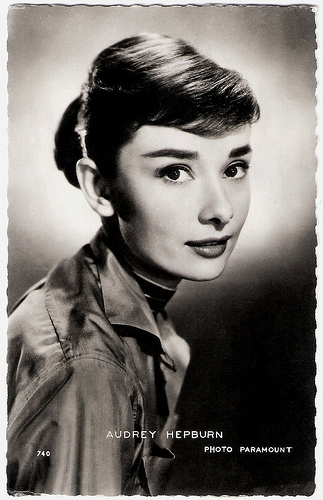
French postcard by Editions P.I., Paris, no. 740. Photo: Paramount, 1956.
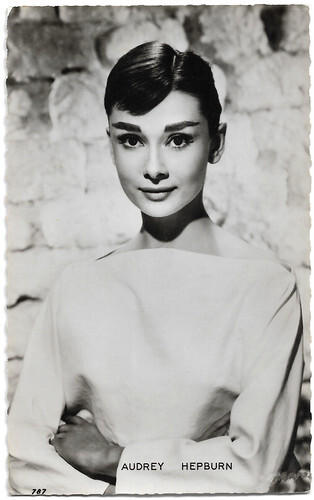
French postcard by Editions P.I., Paris, no. 787. Photo: Paramount Pictures, 1956.
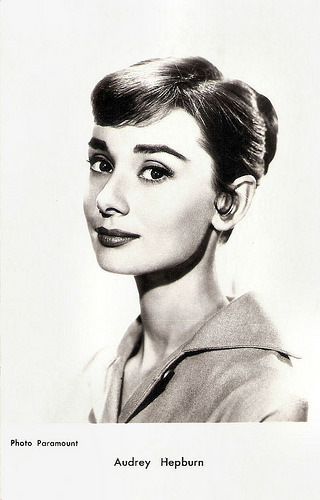
French postcard by Editions P.I., Paris, no. 788. Photo: Paramount.
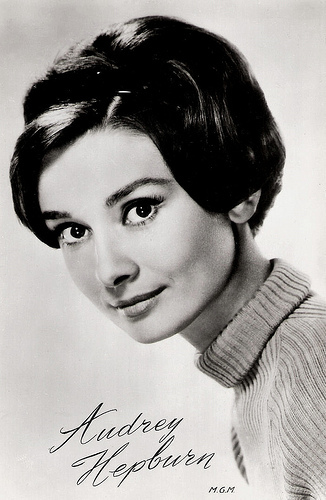
Dutch postcard by Uitg. Takken, Utrecht, no. 4244. Photo: MGM. Publicity still for Green Mansions (Mel Ferrer, 1959).
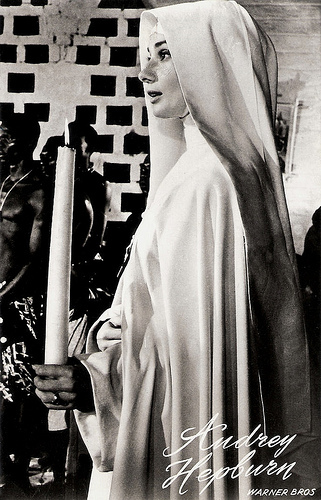
Dutch postcard by Takken, Utrecht, no. 4175. Photo: Warner Bros. Publicity still for The Nun's Story. (Fred Zinnemann, 1959).
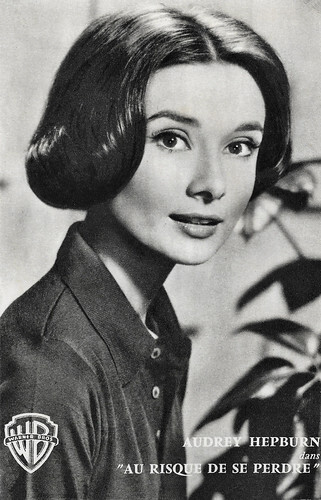
French promotion card by Warner Bros. Photo: Warner Bros. Audrey Hepburn in The Nun's Story (Fred Zinnemann, 1959).
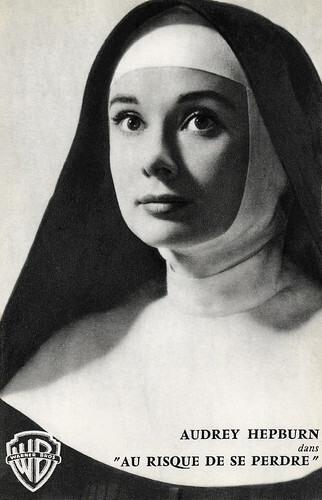
French promotion card by Warner Bros. Photo: Warner Bros. Audrey Hepburn in The Nun's Story (Fred Zinnemann, 1959).
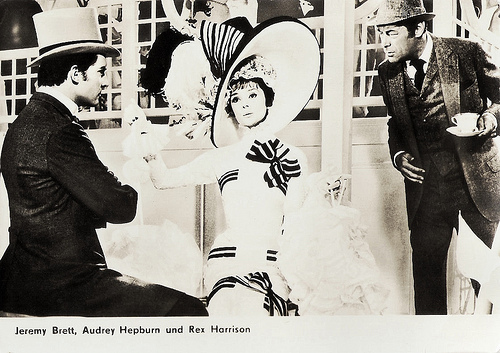
East-German postcard by VEB-Progress Film-Vertrieb, Berlin, no. 2989. Retail price: 0,20 MDM. Photo: Warner Bros. Publicity still for My Fair Lady (George Cukor, 1964) with Jeremy Brett and Rex Harrison . Costumes: Cecil Beaton.
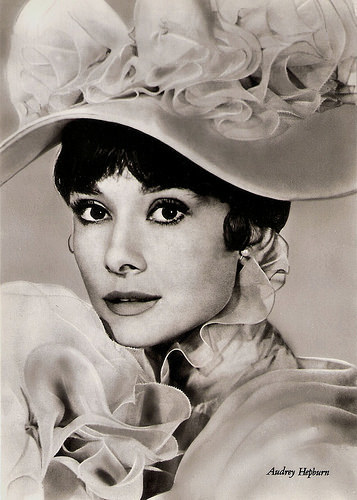
East-German postcard by VEB-Progress Film-Vertrieb, Berlin, no. 2988. Retail price: 0,20 MDM. Photo: Warner Bros. Publicity still for My Fair Lady (George Cukor, 1964). Costume: Cecil Beaton.
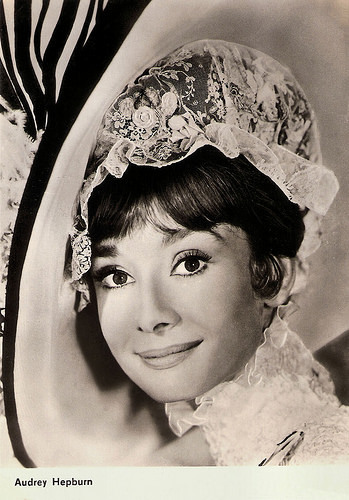
East-German postcard by VEB-Progress Film-Vertrieb, Berlin, no. 3028. Retail price: 0,20 MDM. Photo: Warner Bros. Publicity still for My Fair Lady (George Cukor, 1964). Costume: Cecil Beaton.
Oscar and Tony
After Roman Holiday, Audrey Hepburn filmed Sabrina (Billy Wilder, 1954) with Humphrey Bogart and William Holden . Hepburn was sent to a then-young and upcoming fashion designer Hubert de Givenchy to decide on her wardrobe. Their creative partnership endured for the remainder of Hepburn’s life. Audrey Hepburn wore De Givenchy creations in some of her most renowned films, such as How to Steal a Million (William Wyler, 1966) and Breakfast at Tiffany’s (Blake Edwards, 1961).
In 1954, she returned to the stage to play the water sprite in 'Ondine' in a performance with Mel Ferrer , who she would marry later in the year. She also won a Tony Award for her performance in 'Ondine' (1954). Hepburn is one of only three actresses to receive a Best Actress Oscar and Best Actress Tony in the same year - the others were Shirley Booth and Ellen Burstyn.
Audrey Hepburn was now one of the most successful film actresses in the world, but also a major fashion influence. Her gamine and elfin appearance and widely recognised sense of chic were both admired and imitated. She co-starred with such notable leading men as Henry Fonda in War and Peace (King Vidor, 1956), Fred Astaire in Funny Face (Stanley Donen, 1957), Maurice Chevalier and Gary Cooper in Love in the Afternoon (Billy Wilder, 1957), Anthony Perkins in Green Mansions (Mel Ferrer, 1959), and Burt Lancaster in The Unforgiven (John Huston, 1960).
According to Denny Jackson at IMDb , "Audrey reached the pinnacle of her career when she played Holly Golightly in the delightful film Breakfast at Tiffany's (1961). For this, she received another Oscar nomination." Opposite Shirley MacLaine , she starred in The Children's Hour (William Wyler, 1961). She scored another box office hit with the espionage caper Charade (Stanley Donen, 1963) with Cary Grant . One of her most radiant roles was as Eliza Doolittle in the film version of My Fair Lady (George Cukor, 1964), opposite Rex Harrison. She became only the third actor to receive $1,000,000 for a film role. She followed it with roles opposite Peter O'Toole in How to Steal a Million (William Wyler, 1966) and Albert Finney in Two for the Road (Stanley Donen, 1967).
Audrey Hepburn received Academy Award nominations for Sabrina (Billy Wilder, 1954), The Nun's Story (Fred Zinnemann, 1959), Breakfast at Tiffany's (Blake Edwards, 1961) and Wait Until Dark (Terence Young, 1967), and won BAFTA Awards for her performances in The Nun's Story(Fred Zinnemann, 1959) and Charade (Stanley Donen, 1963). After Wait Until Dark (1967) and 15 years of continuous success, she took a break from film-making from 1968 to 1975, mostly to spend more time with her two sons.
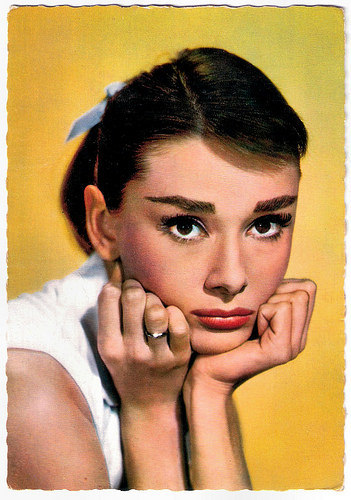
French postcard by E.D.U.G., no. 129.
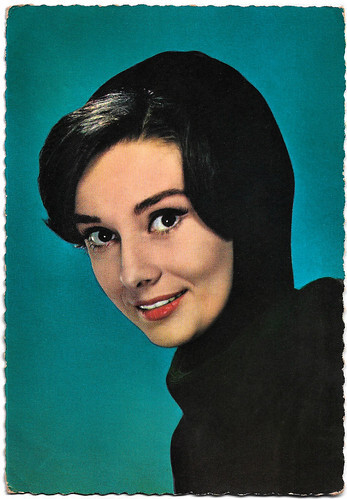
West German postcard by Schumann-Verlag, Berlin-Dahlem. Photo: Star Revue.
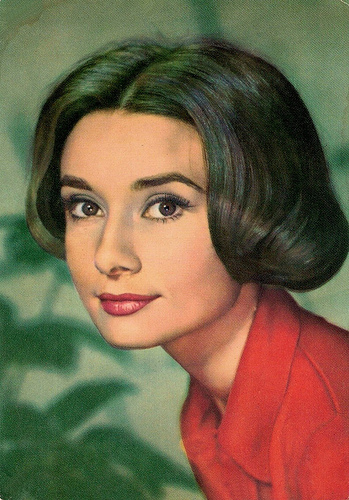
Spanish postcard by Postal Oscarcolor, no. F-179.
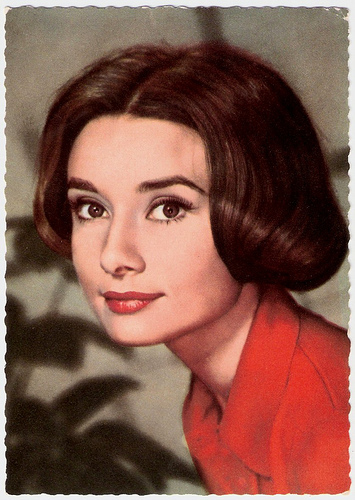
German postcard by Ufa (Universum-Film Aktiengesellschaft, Berlin-Tempelhof), no. CK-179. Photo: Terb Agency / Ufa. The retail price was 30 Pfg.
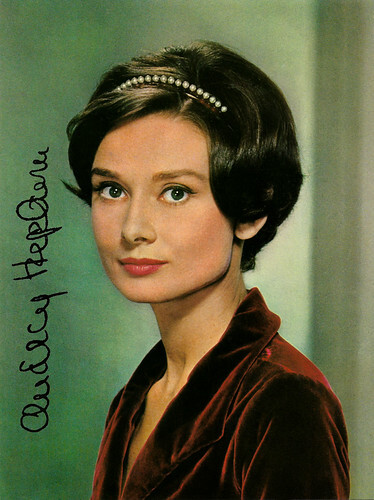
Big Dutch autograph card.
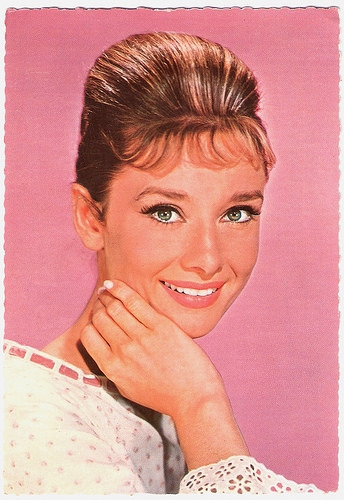
French postcard by E.D.U.G., no. 222.
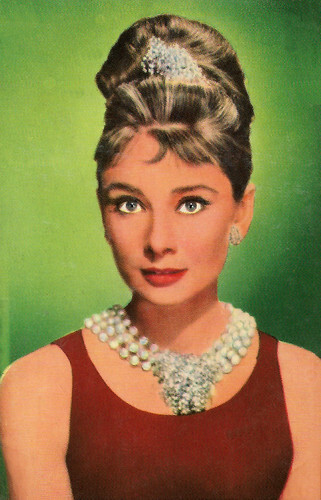
Dutch collectors card by the School of Dancing Joy, Amsterdam, no. 25. Audrey Hepburn in Breakfast at Tiffany's (Blake Edwards, 1961). On the flip side are the basic steps of the slow waltz printed.
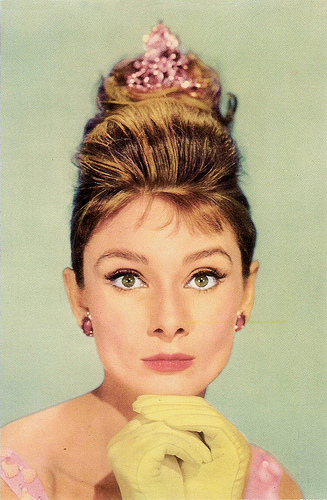
Israelian postcard by Editions De Luxe, no. 130. Photo: publicity still for Breakfast at Tiffany's (Blake Edwards, 1961).
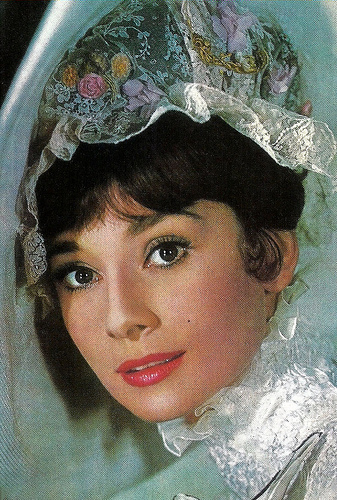
Spanish postcard by Oscarcolor. Audrey Hepburn in My Fair Lady (George Cukor, 1964).
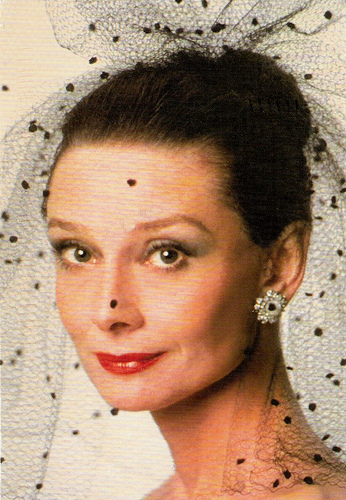
American postcard.
Passion for humanitarian work
In 1976 Audrey Hepburn returned to the screen with Sean Connery in the period piece Robin and Marian (Richard Lester, 1976), which was moderately successful.
Three years later she took the leading role in the international production Bloodline (Terence Young, 1979) based on a novel by Sidney Sheldon. The film, an international intrigue amid the jet-set, was a critical and box office failure. Another commercial failure was the mad cap private-eye caper They All Laughed (Peter Bogdanovich, 1981). In 1989 she made her last film appearance as an angel in the romantic comedy Always (Steven Spielberg, 1989) starring Richard Dreyfuss.
Her wartime experiences inspired her passion for humanitarian work, and although she had worked for the United Nations Children's Fund (UNICEF) since the 1950s, during her later life, she dedicated much of her time and energy to the organisation. From 1988 until 1992, she worked in some of the most profoundly disadvantaged communities of Africa, South America and Asia. In 1992, she was awarded the Presidential Medal of Freedom in recognition of her work as a UNICEF Goodwill Ambassador.
After her divorce from American actor Mel Ferrer , Hepburn married Italian psychiatrist Dr. Andrea Dotti. She had a son with each – Sean (1960) by Ferrer, and Luca (1970) by Dotti. From 1980 until her death, she lived with the Dutch actor Robert Wolders.
In 1993, Audrey Hepburn died of appendiceal cancer at her home in Tolochenaz, Switzerland at the age of 63. She was posthumously awarded The Jean Hersholt Humanitarian Award by the Academy of Motion Picture Arts and Sciences for her humanitarian work. She received a posthumous Grammy Award for her spoken word recording, Audrey Hepburn's Enchanted Tales in 1994, and in the same year, won an Emmy Award for Outstanding Achievement for Gardens of the World with Audrey Hepburn, thereby becoming one of a few people to receive an Academy, Emmy, Grammy and Tony award. In 1999, she was ranked as the third greatest female star of all time by the American Film Institute.
Scenes from Nederlands in 7 lessen/Dutch in Seven Lessons (1948). Source: EverythingAudrey.com (YouTube).
Audrey Hepburn in Laughter in Paradise (1951). Source: My username is Robyn (YouTube).
Scenes from Secret People (1952). Source: EverythingAudrey.com (YouTube).
The screen test by William Wyler for Roman Holiday (1952). Source: Haphazard Studios (YouTube).
Audrey Hepburn and her husband Mel Ferrer visit the Netherlands to attend a film premiere of El Greco starring Mel Ferrer. Source: FabAudrey (YouTube).
Trailer of Breakfast at Tiffany's (1961). Source: FabAudrey (YouTube).
The Fashion Designer and His Muse - Audrey Hepburn and Hubert de Givenchy. Source: Nanda (YouTube).
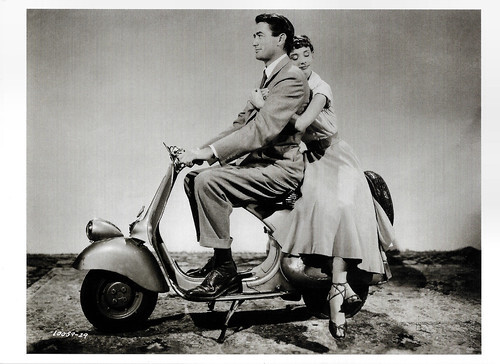
Swiss postcard by CVB Publishers, no. 57255. Photo: Collection Cinémathèque Suisse, Lausanne. Gregory Peck and Audrey Hepburn in Roman Holiday (William Wyler, 1953).
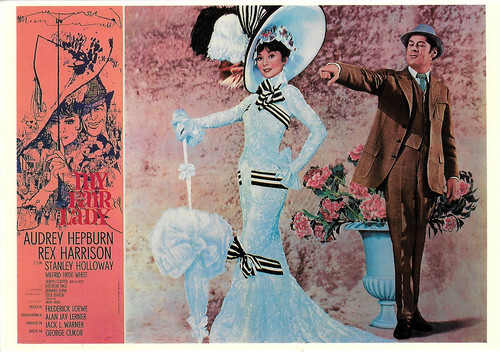
American postcard in the Magic of the Movies Series by Mayfair Cards, no. FP 859. Lobby card: Warner Bros / Reel Poster Archive. Audrey Hepburn and Rex Harrison in My Fair Lady (George Cukor, 1964).
Sources: (IMDb), Gemeentemuseum Den Haag (page now defunct), Wikipedia and .

French postcard by Editions du Globe, Paris, no. 385. Photo: Paramount / P.P.C. Publicity still for Sabrina (Billy Wilder, 1954). Costume: Hubert de Givenchy.

Dutch postcard by Takken, Utrecht, no. 1530. Photo: Paramount. Publicity still for Sabrina (Billy Wilder, 1954). Costume: Hubert de Givenchy.

French postcard. Publicity still for Sabrina (Billy Wilder, 1954). Costume: Hubert de Givenchy.

French postcard by Editions du Globe, Paris, no. 384. Photo: Paramount / PPC, 1955. Audrey Hepburn in Sabrina (Billy Wilder, 1954). Costume: Hubert de Givenchy.

German postcard by Tushita, Duisburg / Innenhalen, no. B 489. Photo: Transglobe /Popperfoto. Audrey Hepburn was five times nominated for an Academy Award, and was awarded in 1954 the Academy Award for Best Actress for her performance in Roman Holiday (William Wyler, 1953).

German postcard by Ufa, Berlin-Tempelhof, no. CK-5. Retail price: 30 Pfg. Photo: Paramount Film.

French postcard. Unknown editor and photographer.

Italian postcard by Emilio Modric Editore, Ancona, no. MX 243. Photo: Audrey Hepburn in Breakfast at Tiffany's (Blake Edwards, 1961).
Wartime in Arnhem
Audrey Hepburn was born Audrey Kathleen Ruston in Ixelles/Elsene, a municipality in Brussels, Belgium, in 1929. She was the only child of Joseph Victor Anthony Ruston, a Briton, and his second wife, the former Baroness Ella van Heemstra, a Dutch aristocrat, who was the daughter of a former governor of Dutch Guiana.
Her father later used the surname of his maternal grandmother, Kathleen Hepburn, to the family and her surname became Hepburn-Ruston. Hepburn's father's job with a British insurance company meant the family travelled often between Brussels, England, and The Netherlands. In 1935, her parents divorced and her father, a Nazi sympathiser, left the family.
In 1939, her mother moved her and her two half-brothers to their grandfather's home in Arnhem in the Netherlands, believing the Netherlands would be safe from a German attack. Hepburn attended the Arnhem Conservatory from 1939 to 1945, where she trained in ballet along with the standard school curriculum. In 1940, the Germans invaded the Netherlands. During the German occupation, Hepburn adopted the pseudonym Edda van Heemstra, modifying her mother's documents because an 'English-sounding' name was considered dangerous.
By 1944, Audrey had become a proficient ballerina. She secretly danced for groups of people to collect money for the Dutch resistance. During the Dutch famine that followed, over the winter of 1944, people starved and froze to death in the streets. Hepburn and many others resorted to making flour out of tulip bulbs to bake cakes and biscuits. Hepburn's wartime experiences later led her to become involved with UNICEF.
In 1945, after the war, Hepburn left the Arnhem Conservatory and moved to Amsterdam, where she took ballet lessons with Lithuanian-Dutch-Jewish dancer and choreographer Sonia Gaskell. Hepburn made her first film appearance in Nederlands in 7 lessen/Dutch in Seven Lessons (Charles Huguenot van der Linden, Heinz Josephson, 1948), a Dutch film made for KLM Royal Dutch Airlines. It had a film-within-the-film scenario involving a cameraman who's given a week to photograph the aerial highlights of Holland for a travelogue. Hepburn played the stewardess.
She then travelled with her mother to London. Gaskell provided an introduction to Marie Rambert, and Hepburn studied ballet at the Ballet Rambert, supporting herself with part-time work as a model. Rambert warned her that she could not become a prima ballerina, because she was relatively tall (1.7m). Audrey decided to pursue an acting career instead.

British postcard by Acme Cards, London, no. AM 1. Photo: Angus McBean, 1951.

French promotion card for Supernylons Plaza. The card refers to the British film Young Wives' Tale (Henry Cass, 1951) with 22-year-old Audrey Hepburn in her fourth film, two years before Roman Holiday (William Wyler, 1953). Collection: Marlene Pilaete.

Dutch postcard by Takken / 't Sticht, Utrecht, no. 1469. Photo: Paramount. Audrey Hepburn in Roman Holiday (William Wyler, 1953).

German postcard by Kunst und Bild, Berlin, no. A 1031. Photo: Paramount. Publicity still for Roman Holiday (William Wyler, 1953).

German postcard by Kunst und Bild, Berlin, no. A 1079. Photo: Paramount. Audrey Hepburn and Gregory Peck in Roman Holiday (William Wyler, 1953).

Dutch postcard by Takken, Utrecht, no. 1598. With Mel Ferrer .

Dutch postcard by Takken, Utrecht, no. 1599. Audrey Hepburn visited Arnhem after the war.

Italian postcard by Bromofoto, Milano (Milan).

Dutch postcard by Takken, Utrecht, no. 1422. Photo: Paramount.

West German postcard by Kolibri Verlag, Minden/Westf., no. 2884.
Meeting Colette
In London, Audrey Hepburn played in musical theatre in productions such as 'High Button Shoes' and 'Sauce Piquante'. Her theatre work revealed that her voice was not strong and needed to be developed, and during this time she took elocution lessons with the actor Felix Aylmer.
Part-time modelling work was not always available and Hepburn registered with the casting officers of Britain's film studios in the hope of getting work as an extra. Hepburn's first British film role was in the farce One Wild Oat (Charles Saunders, 1951) in which she played a hotel receptionist. She played several more small roles in Young Wives' Tale (Henry Cass, 1951), Laughter in Paradise (Mario Zampi, 1951), the classic crime comedy The Lavender Hill Mob (Charles Crichton, 1951), and the comedy Monte Carlo Baby (Jean Boyer, Lester Fuller, 1951).
Monte Carlo Baby was shot at the same time as the French-language version, Nous irons à Monte Carlo (Jean Boyer, 1952). During the filming, Hepburn met the famous author Colette , who recommended her for the lead character of a stage version of her novel 'Gigi' on Broadway.
Colette reportedly said when she first saw Hepburn "Voilà! There's our Gigi!" The play opened on 24 November 1951 and ran for 219 performances. Audrey won a Theatre World Award for her performance. Hepburn's first significant film performance was in the British crime drama Secret People (Thorold Dickinson, 1952), starring Valentina Cortese . Audrey played a prodigious ballerina and did all of her own dancing scenes.
Her first starring role was opposite Gregory Peck in the Italian-set Roman Holiday (William Wyler, 1952). Producers initially wanted Elizabeth Taylor for the role of Princess Ann, but director William Wyler was so impressed by Hepburn's screen test (the camera was left on and candid footage of Hepburn relaxing and answering questions, unaware that she was still being filmed, displayed her talents), that he cast her in the lead. For her enchanting role in Roman Holiday, she would win an Academy Award, a Golden Globe and a BAFTA. Paramount signed her to a seven-picture contract with twelve months in between films to allow her time for stage work.

French postcard by Editions P.I., Paris, no. 740. Photo: Paramount, 1956.

French postcard by Editions P.I., Paris, no. 787. Photo: Paramount Pictures, 1956.

French postcard by Editions P.I., Paris, no. 788. Photo: Paramount.

Dutch postcard by Uitg. Takken, Utrecht, no. 4244. Photo: MGM. Publicity still for Green Mansions (Mel Ferrer, 1959).

Dutch postcard by Takken, Utrecht, no. 4175. Photo: Warner Bros. Publicity still for The Nun's Story. (Fred Zinnemann, 1959).

French promotion card by Warner Bros. Photo: Warner Bros. Audrey Hepburn in The Nun's Story (Fred Zinnemann, 1959).

French promotion card by Warner Bros. Photo: Warner Bros. Audrey Hepburn in The Nun's Story (Fred Zinnemann, 1959).

East-German postcard by VEB-Progress Film-Vertrieb, Berlin, no. 2989. Retail price: 0,20 MDM. Photo: Warner Bros. Publicity still for My Fair Lady (George Cukor, 1964) with Jeremy Brett and Rex Harrison . Costumes: Cecil Beaton.

East-German postcard by VEB-Progress Film-Vertrieb, Berlin, no. 2988. Retail price: 0,20 MDM. Photo: Warner Bros. Publicity still for My Fair Lady (George Cukor, 1964). Costume: Cecil Beaton.

East-German postcard by VEB-Progress Film-Vertrieb, Berlin, no. 3028. Retail price: 0,20 MDM. Photo: Warner Bros. Publicity still for My Fair Lady (George Cukor, 1964). Costume: Cecil Beaton.
Oscar and Tony
After Roman Holiday, Audrey Hepburn filmed Sabrina (Billy Wilder, 1954) with Humphrey Bogart and William Holden . Hepburn was sent to a then-young and upcoming fashion designer Hubert de Givenchy to decide on her wardrobe. Their creative partnership endured for the remainder of Hepburn’s life. Audrey Hepburn wore De Givenchy creations in some of her most renowned films, such as How to Steal a Million (William Wyler, 1966) and Breakfast at Tiffany’s (Blake Edwards, 1961).
In 1954, she returned to the stage to play the water sprite in 'Ondine' in a performance with Mel Ferrer , who she would marry later in the year. She also won a Tony Award for her performance in 'Ondine' (1954). Hepburn is one of only three actresses to receive a Best Actress Oscar and Best Actress Tony in the same year - the others were Shirley Booth and Ellen Burstyn.
Audrey Hepburn was now one of the most successful film actresses in the world, but also a major fashion influence. Her gamine and elfin appearance and widely recognised sense of chic were both admired and imitated. She co-starred with such notable leading men as Henry Fonda in War and Peace (King Vidor, 1956), Fred Astaire in Funny Face (Stanley Donen, 1957), Maurice Chevalier and Gary Cooper in Love in the Afternoon (Billy Wilder, 1957), Anthony Perkins in Green Mansions (Mel Ferrer, 1959), and Burt Lancaster in The Unforgiven (John Huston, 1960).
According to Denny Jackson at IMDb , "Audrey reached the pinnacle of her career when she played Holly Golightly in the delightful film Breakfast at Tiffany's (1961). For this, she received another Oscar nomination." Opposite Shirley MacLaine , she starred in The Children's Hour (William Wyler, 1961). She scored another box office hit with the espionage caper Charade (Stanley Donen, 1963) with Cary Grant . One of her most radiant roles was as Eliza Doolittle in the film version of My Fair Lady (George Cukor, 1964), opposite Rex Harrison. She became only the third actor to receive $1,000,000 for a film role. She followed it with roles opposite Peter O'Toole in How to Steal a Million (William Wyler, 1966) and Albert Finney in Two for the Road (Stanley Donen, 1967).
Audrey Hepburn received Academy Award nominations for Sabrina (Billy Wilder, 1954), The Nun's Story (Fred Zinnemann, 1959), Breakfast at Tiffany's (Blake Edwards, 1961) and Wait Until Dark (Terence Young, 1967), and won BAFTA Awards for her performances in The Nun's Story(Fred Zinnemann, 1959) and Charade (Stanley Donen, 1963). After Wait Until Dark (1967) and 15 years of continuous success, she took a break from film-making from 1968 to 1975, mostly to spend more time with her two sons.

French postcard by E.D.U.G., no. 129.

West German postcard by Schumann-Verlag, Berlin-Dahlem. Photo: Star Revue.

Spanish postcard by Postal Oscarcolor, no. F-179.

German postcard by Ufa (Universum-Film Aktiengesellschaft, Berlin-Tempelhof), no. CK-179. Photo: Terb Agency / Ufa. The retail price was 30 Pfg.

Big Dutch autograph card.

French postcard by E.D.U.G., no. 222.

Dutch collectors card by the School of Dancing Joy, Amsterdam, no. 25. Audrey Hepburn in Breakfast at Tiffany's (Blake Edwards, 1961). On the flip side are the basic steps of the slow waltz printed.

Israelian postcard by Editions De Luxe, no. 130. Photo: publicity still for Breakfast at Tiffany's (Blake Edwards, 1961).

Spanish postcard by Oscarcolor. Audrey Hepburn in My Fair Lady (George Cukor, 1964).

American postcard.
Passion for humanitarian work
In 1976 Audrey Hepburn returned to the screen with Sean Connery in the period piece Robin and Marian (Richard Lester, 1976), which was moderately successful.
Three years later she took the leading role in the international production Bloodline (Terence Young, 1979) based on a novel by Sidney Sheldon. The film, an international intrigue amid the jet-set, was a critical and box office failure. Another commercial failure was the mad cap private-eye caper They All Laughed (Peter Bogdanovich, 1981). In 1989 she made her last film appearance as an angel in the romantic comedy Always (Steven Spielberg, 1989) starring Richard Dreyfuss.
Her wartime experiences inspired her passion for humanitarian work, and although she had worked for the United Nations Children's Fund (UNICEF) since the 1950s, during her later life, she dedicated much of her time and energy to the organisation. From 1988 until 1992, she worked in some of the most profoundly disadvantaged communities of Africa, South America and Asia. In 1992, she was awarded the Presidential Medal of Freedom in recognition of her work as a UNICEF Goodwill Ambassador.
After her divorce from American actor Mel Ferrer , Hepburn married Italian psychiatrist Dr. Andrea Dotti. She had a son with each – Sean (1960) by Ferrer, and Luca (1970) by Dotti. From 1980 until her death, she lived with the Dutch actor Robert Wolders.
In 1993, Audrey Hepburn died of appendiceal cancer at her home in Tolochenaz, Switzerland at the age of 63. She was posthumously awarded The Jean Hersholt Humanitarian Award by the Academy of Motion Picture Arts and Sciences for her humanitarian work. She received a posthumous Grammy Award for her spoken word recording, Audrey Hepburn's Enchanted Tales in 1994, and in the same year, won an Emmy Award for Outstanding Achievement for Gardens of the World with Audrey Hepburn, thereby becoming one of a few people to receive an Academy, Emmy, Grammy and Tony award. In 1999, she was ranked as the third greatest female star of all time by the American Film Institute.
Scenes from Nederlands in 7 lessen/Dutch in Seven Lessons (1948). Source: EverythingAudrey.com (YouTube).
Audrey Hepburn in Laughter in Paradise (1951). Source: My username is Robyn (YouTube).
Scenes from Secret People (1952). Source: EverythingAudrey.com (YouTube).
The screen test by William Wyler for Roman Holiday (1952). Source: Haphazard Studios (YouTube).
Audrey Hepburn and her husband Mel Ferrer visit the Netherlands to attend a film premiere of El Greco starring Mel Ferrer. Source: FabAudrey (YouTube).
Trailer of Breakfast at Tiffany's (1961). Source: FabAudrey (YouTube).
The Fashion Designer and His Muse - Audrey Hepburn and Hubert de Givenchy. Source: Nanda (YouTube).

Swiss postcard by CVB Publishers, no. 57255. Photo: Collection Cinémathèque Suisse, Lausanne. Gregory Peck and Audrey Hepburn in Roman Holiday (William Wyler, 1953).

American postcard in the Magic of the Movies Series by Mayfair Cards, no. FP 859. Lobby card: Warner Bros / Reel Poster Archive. Audrey Hepburn and Rex Harrison in My Fair Lady (George Cukor, 1964).
Sources: (IMDb), Gemeentemuseum Den Haag (page now defunct), Wikipedia and .
Published on August 10, 2024 22:00
August 9, 2024
Robert Cummings
Robert ‘Bob’ Cummings (1910-1990) was an effective light comedian of 1930s and '40s films and 1950s and '60s TV series. He was renowned for his eternally youthful looks which he attributed to a strict vitamin and health-food diet. Cummings acted mainly in comedies but also played in dramas and the Hitchcock thrillers Saboteur (1942) and Dial M for Murder (1954). His career would span five decades and he appeared in nearly 70 films.
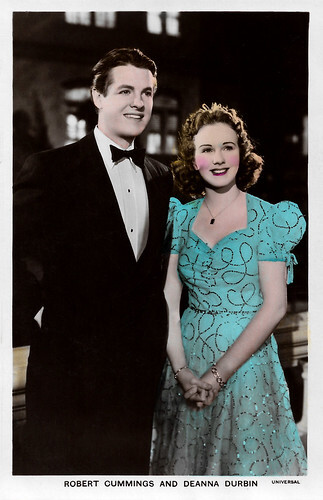
British postcard in the Picturegoer Series, London, no. PC 270. Photo: Universal. Robert Cummings and Deanna Durbin in Three Smart Girls (Henry Koster, 1936).
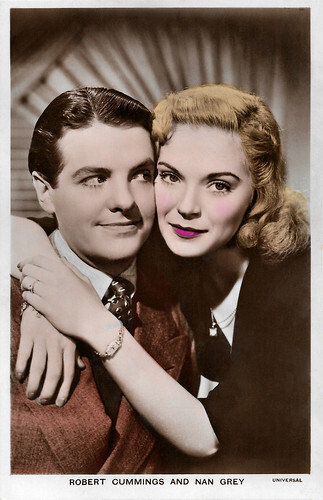
British postcard in the Film Partners Series, London, no. PC 275. Photo: Universal. Robert Cummings and Nan Grey in Three Smart Girls Grow Up (Henry Koster, 1939).
A marvellous comedy talent and also a romantic quality
Charles Clarence Robert Orville Cummings was born in 1910 in Joplin, Missouri. His father, Dr. Charles Clarence Cummings Sr., was a surgeon. He was part of the original staff of St. John's Hospital in Joplin, Missouri. He was the founder of the Jasper County Tuberculosis Hospital in Webb City, Missouri. His mother, Ruth Annabelle Kraft, was an ordained minister of the Science of Mind. Aviation pioneer Orville Wright, an old family friend, was his godfather. After completing high school, he studied briefly at Drury College in Springfield, Missouri before transferring to the Carnegie Institute of Technology in Pittsburgh, Pennsylvania.
Bob studied aeronautical engineering for a year before being forced to drop out for financial reasons. His family had lost heavily in the 1929 stock market crash. Cummings next decided to study at the American Academy of Dramatic Arts in New York, as male actors there were paid $14 a week. Deciding that Broadway producers would be more interested in an upper-crust Englishman than a kid from Joplin, Missouri, Cummings passed himself off as Blade Stanhope Conway, a British actor. The ploy was successful. He later assumed the identity of a rich Texan named Bruce Hutchens and appeared under this name in ‘The Ziegfeld Follies of 1934’. In this production, he met het his second wife, Vivi Janiss.
Cummings decided that if a false identity worked on Broadway, it would work in Hollywood. So in 1935, he journeyed to Los Angeles and the plan worked once more. He began securing small parts in films and soon reverted to his real name. He got his first substantial part in King Vidor 's Civil War-era romance So Red the Rose (1935) alongside Margaret Sullavan and Randolph Scott . In their review, The New York Times said that Cummings "does a fine bit" and "has the only convincing accent in the whole film." He then made a long series of now-forgotten B-movies in which he played leading roles. He had a small role in You and Me (1938) directed by Fritz Lang .
Cummings broke through as a film actor with Three Smart Girls Grow Up (Henry Koster, 1939), in which he was the romantic lead for Deanna Durbin . Koster called Cummings "brilliant, wonderful… I made five pictures with him. I thought he was the best leading man I ever worked with. He had that marvellous comedy talent and also a romantic quality." Another big hit was their comedy It Started with Eve (Henry Koster, 1941) with Deanna Durbin and Charles Laughton . While making this film at Universal, Cummings was also making the drama Kings Row (Sam Wood, 1942) with Ann Sheridan and Ronald Reagan , at Warner Bros. He was rushing from one studio to the other to play two completely different types of roles. In dramatic films he was credited as Robert Cummings; in lighter fare, he was often billed as Bob Cummings.
This was followed by numerous film comedies including The Devil and Miss Jones (Sam Wood, 1941) with Jean Arthur , Moon over Miami (Walter Lang, 1941) starring Don Ameche and Betty Grable , and Princess O'Rourke (Norman Krasna, 1943) with Olivia de Havilland . In these light comedies, he usually played well-meaning, pleasant but somewhat bumbling young men. Cummings also starred in the Alfred Hitchcock spy thriller Saboteur (1942), made at Universal, with Priscilla Lane and Norman Lloyd. He played Barry Kane, an aircraft worker wrongfully accused of espionage, trying to clear his name. From 1938 to 1945, he also appeared on a successful radio serial, ‘Those We Love’, opposite Richard Cromwell , Francis X. Bushman and Nan Grey.
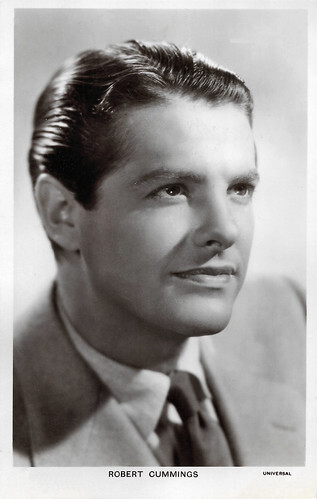
British postcard in the Picturegoer Series, London, no. 1068a. Photo: Universal.
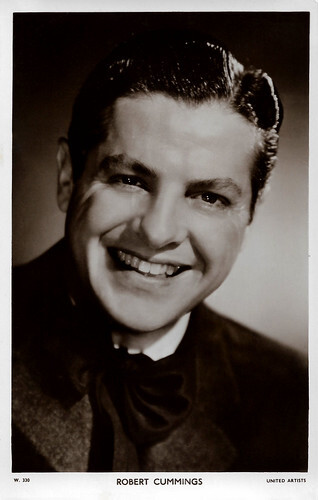
British postcard in the Picturegoer Series, London no. W 330. Photo: United Artists.
The notorious ‘Dr. Feelgood’
In 1942 Robert Cummings joined the United States Army Air Force and was made a flight instructor. He had worked in that capacity for many years before enlisting. After the war, Cummings served for a time as a pilot in the United States Air Force Reserve. Beginning in 1946, he became executive producer of United World Productions. That year, he starred in the comedy The Bride Wore Boots (Irving Pichel, 1946) with Barbara Stanwyck . He also starred in the Film Noir Sleep, My Love (1948), directed by Douglas Sirk and produced by Mary Pickford .
In the 1950s, Cummings achieved success on television. Cummings starred in his first regular television series in the comedy My Hero (1952–1953), playing a bumbling real estate salesman. He also wrote and directed some episodes. He was the star of the initial production of Twelve Angry Men (Franklin Schaffner, 1954), filmed live for CBS's TV drama series Studio One. He received an Emmy Award for his part as Juror Number Eight, the role later made famous by Henry Fonda in Sidney Lumet's 1957 film version. That same year, he also starred with Grace Kelly and Ray Milland in the classic thriller Dial M for Murder (Alfred Hitchcock, 1954). It was a big hit.
The next year, Cummings starred in his own television series, The Bob Cummings Show (1955-1959) for which he also worked as a director. He played studio photographer Bob Collins, a bachelor who photographed and dated the world's most beautiful models. The Bob Cummings Show was succeeded by The New Bob Cummings Show (1962-1963), which however only ran for only one season. He played a charter pilot, often playing amateur detective. In a third series, My Living Doll (1964-1965), he played a psychiatrist who is given care of a lifelike sophisticated but naïve android, played by Julie Newmar , who eventually learns how human society works.
His later films included Beach Party (William Asher, 1963), The Carpetbaggers (Edward Dmytryk, 1964), and the remake Stagecoach (Gordon Douglas, 1966). His final film appearance was in Five Golden Dragons (Jeremy Summers, 1967) with Margaret Lee . His last major television appearance was the television film Partners in Crime (Jack Smight, 1973) with Lee Grant. After guest-starring on The Love Boat (1977), he retired from acting at age 69.
Cummings was a great advocate of a healthy diet and natural foods. He even wrote a book ‘Stay Young and Vital’(1960) which sold millions of copies. Despite this, or perhaps because of it, he came under the influence of doctor Max Jacobson, the notorious ‘Dr. Feelgood’, who gave him masses of amphetamines and eventually meth to supposedly improve his performance. Cummings became addicted to drugs for the rest of his life, which hurt both his career and many personal relationships from the 1960s onwards. Robert Cummings died of kidney failure in 1990 in Woodland Hills, Los Angeles, California, at the age of 80. He was also suffering from Parkinson's Disease at the time of his death. He was interred at the Great Mausoleum at Forest Lawn Cemetery in Glendale, California. Robert Cummings married five times and divorced four times. His wives were Emma Myers (1931-1933), Vivi Janiss (1935-1943), Mary Elliott (1945-1970, 5 children), Regina Fong (1971-1987, 2 children) and Martha ‘Jane’ Burzynski (1989-1990; his death). His son Tony Cummings is a former soap actor best known for Another World (1981).
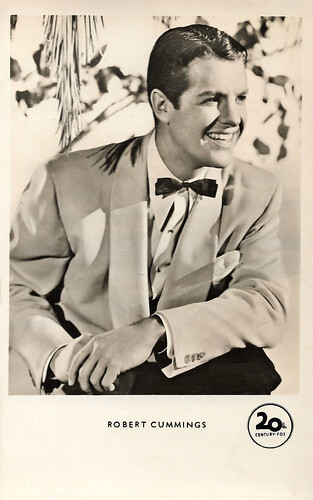
West German postcard by Kunst und Bild, Berlin, no. A 107. Photo: 20th Century Fox.
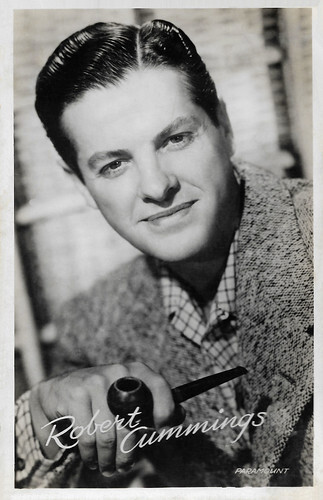
Vintage postcard, no. 3391. Photo: Paramount.
Sources William Bjornstad (Find A Grave), Wikipedia (Dutch, German and English) and .

British postcard in the Picturegoer Series, London, no. PC 270. Photo: Universal. Robert Cummings and Deanna Durbin in Three Smart Girls (Henry Koster, 1936).

British postcard in the Film Partners Series, London, no. PC 275. Photo: Universal. Robert Cummings and Nan Grey in Three Smart Girls Grow Up (Henry Koster, 1939).
A marvellous comedy talent and also a romantic quality
Charles Clarence Robert Orville Cummings was born in 1910 in Joplin, Missouri. His father, Dr. Charles Clarence Cummings Sr., was a surgeon. He was part of the original staff of St. John's Hospital in Joplin, Missouri. He was the founder of the Jasper County Tuberculosis Hospital in Webb City, Missouri. His mother, Ruth Annabelle Kraft, was an ordained minister of the Science of Mind. Aviation pioneer Orville Wright, an old family friend, was his godfather. After completing high school, he studied briefly at Drury College in Springfield, Missouri before transferring to the Carnegie Institute of Technology in Pittsburgh, Pennsylvania.
Bob studied aeronautical engineering for a year before being forced to drop out for financial reasons. His family had lost heavily in the 1929 stock market crash. Cummings next decided to study at the American Academy of Dramatic Arts in New York, as male actors there were paid $14 a week. Deciding that Broadway producers would be more interested in an upper-crust Englishman than a kid from Joplin, Missouri, Cummings passed himself off as Blade Stanhope Conway, a British actor. The ploy was successful. He later assumed the identity of a rich Texan named Bruce Hutchens and appeared under this name in ‘The Ziegfeld Follies of 1934’. In this production, he met het his second wife, Vivi Janiss.
Cummings decided that if a false identity worked on Broadway, it would work in Hollywood. So in 1935, he journeyed to Los Angeles and the plan worked once more. He began securing small parts in films and soon reverted to his real name. He got his first substantial part in King Vidor 's Civil War-era romance So Red the Rose (1935) alongside Margaret Sullavan and Randolph Scott . In their review, The New York Times said that Cummings "does a fine bit" and "has the only convincing accent in the whole film." He then made a long series of now-forgotten B-movies in which he played leading roles. He had a small role in You and Me (1938) directed by Fritz Lang .
Cummings broke through as a film actor with Three Smart Girls Grow Up (Henry Koster, 1939), in which he was the romantic lead for Deanna Durbin . Koster called Cummings "brilliant, wonderful… I made five pictures with him. I thought he was the best leading man I ever worked with. He had that marvellous comedy talent and also a romantic quality." Another big hit was their comedy It Started with Eve (Henry Koster, 1941) with Deanna Durbin and Charles Laughton . While making this film at Universal, Cummings was also making the drama Kings Row (Sam Wood, 1942) with Ann Sheridan and Ronald Reagan , at Warner Bros. He was rushing from one studio to the other to play two completely different types of roles. In dramatic films he was credited as Robert Cummings; in lighter fare, he was often billed as Bob Cummings.
This was followed by numerous film comedies including The Devil and Miss Jones (Sam Wood, 1941) with Jean Arthur , Moon over Miami (Walter Lang, 1941) starring Don Ameche and Betty Grable , and Princess O'Rourke (Norman Krasna, 1943) with Olivia de Havilland . In these light comedies, he usually played well-meaning, pleasant but somewhat bumbling young men. Cummings also starred in the Alfred Hitchcock spy thriller Saboteur (1942), made at Universal, with Priscilla Lane and Norman Lloyd. He played Barry Kane, an aircraft worker wrongfully accused of espionage, trying to clear his name. From 1938 to 1945, he also appeared on a successful radio serial, ‘Those We Love’, opposite Richard Cromwell , Francis X. Bushman and Nan Grey.

British postcard in the Picturegoer Series, London, no. 1068a. Photo: Universal.

British postcard in the Picturegoer Series, London no. W 330. Photo: United Artists.
The notorious ‘Dr. Feelgood’
In 1942 Robert Cummings joined the United States Army Air Force and was made a flight instructor. He had worked in that capacity for many years before enlisting. After the war, Cummings served for a time as a pilot in the United States Air Force Reserve. Beginning in 1946, he became executive producer of United World Productions. That year, he starred in the comedy The Bride Wore Boots (Irving Pichel, 1946) with Barbara Stanwyck . He also starred in the Film Noir Sleep, My Love (1948), directed by Douglas Sirk and produced by Mary Pickford .
In the 1950s, Cummings achieved success on television. Cummings starred in his first regular television series in the comedy My Hero (1952–1953), playing a bumbling real estate salesman. He also wrote and directed some episodes. He was the star of the initial production of Twelve Angry Men (Franklin Schaffner, 1954), filmed live for CBS's TV drama series Studio One. He received an Emmy Award for his part as Juror Number Eight, the role later made famous by Henry Fonda in Sidney Lumet's 1957 film version. That same year, he also starred with Grace Kelly and Ray Milland in the classic thriller Dial M for Murder (Alfred Hitchcock, 1954). It was a big hit.
The next year, Cummings starred in his own television series, The Bob Cummings Show (1955-1959) for which he also worked as a director. He played studio photographer Bob Collins, a bachelor who photographed and dated the world's most beautiful models. The Bob Cummings Show was succeeded by The New Bob Cummings Show (1962-1963), which however only ran for only one season. He played a charter pilot, often playing amateur detective. In a third series, My Living Doll (1964-1965), he played a psychiatrist who is given care of a lifelike sophisticated but naïve android, played by Julie Newmar , who eventually learns how human society works.
His later films included Beach Party (William Asher, 1963), The Carpetbaggers (Edward Dmytryk, 1964), and the remake Stagecoach (Gordon Douglas, 1966). His final film appearance was in Five Golden Dragons (Jeremy Summers, 1967) with Margaret Lee . His last major television appearance was the television film Partners in Crime (Jack Smight, 1973) with Lee Grant. After guest-starring on The Love Boat (1977), he retired from acting at age 69.
Cummings was a great advocate of a healthy diet and natural foods. He even wrote a book ‘Stay Young and Vital’(1960) which sold millions of copies. Despite this, or perhaps because of it, he came under the influence of doctor Max Jacobson, the notorious ‘Dr. Feelgood’, who gave him masses of amphetamines and eventually meth to supposedly improve his performance. Cummings became addicted to drugs for the rest of his life, which hurt both his career and many personal relationships from the 1960s onwards. Robert Cummings died of kidney failure in 1990 in Woodland Hills, Los Angeles, California, at the age of 80. He was also suffering from Parkinson's Disease at the time of his death. He was interred at the Great Mausoleum at Forest Lawn Cemetery in Glendale, California. Robert Cummings married five times and divorced four times. His wives were Emma Myers (1931-1933), Vivi Janiss (1935-1943), Mary Elliott (1945-1970, 5 children), Regina Fong (1971-1987, 2 children) and Martha ‘Jane’ Burzynski (1989-1990; his death). His son Tony Cummings is a former soap actor best known for Another World (1981).

West German postcard by Kunst und Bild, Berlin, no. A 107. Photo: 20th Century Fox.

Vintage postcard, no. 3391. Photo: Paramount.
Sources William Bjornstad (Find A Grave), Wikipedia (Dutch, German and English) and .
Published on August 09, 2024 22:00
Paul van Yperen's Blog
- Paul van Yperen's profile
- 13 followers
Paul van Yperen isn't a Goodreads Author
(yet),
but they
do have a blog,
so here are some recent posts imported from
their feed.



